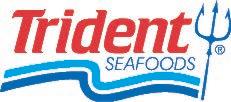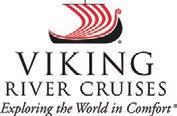THE WEATHER DIARIES 4
Partners in the Polar Region 9
Nathalia Edenmont: Force of Nature 10

Partners in the Polar Region 9
Nathalia Edenmont: Force of Nature 10
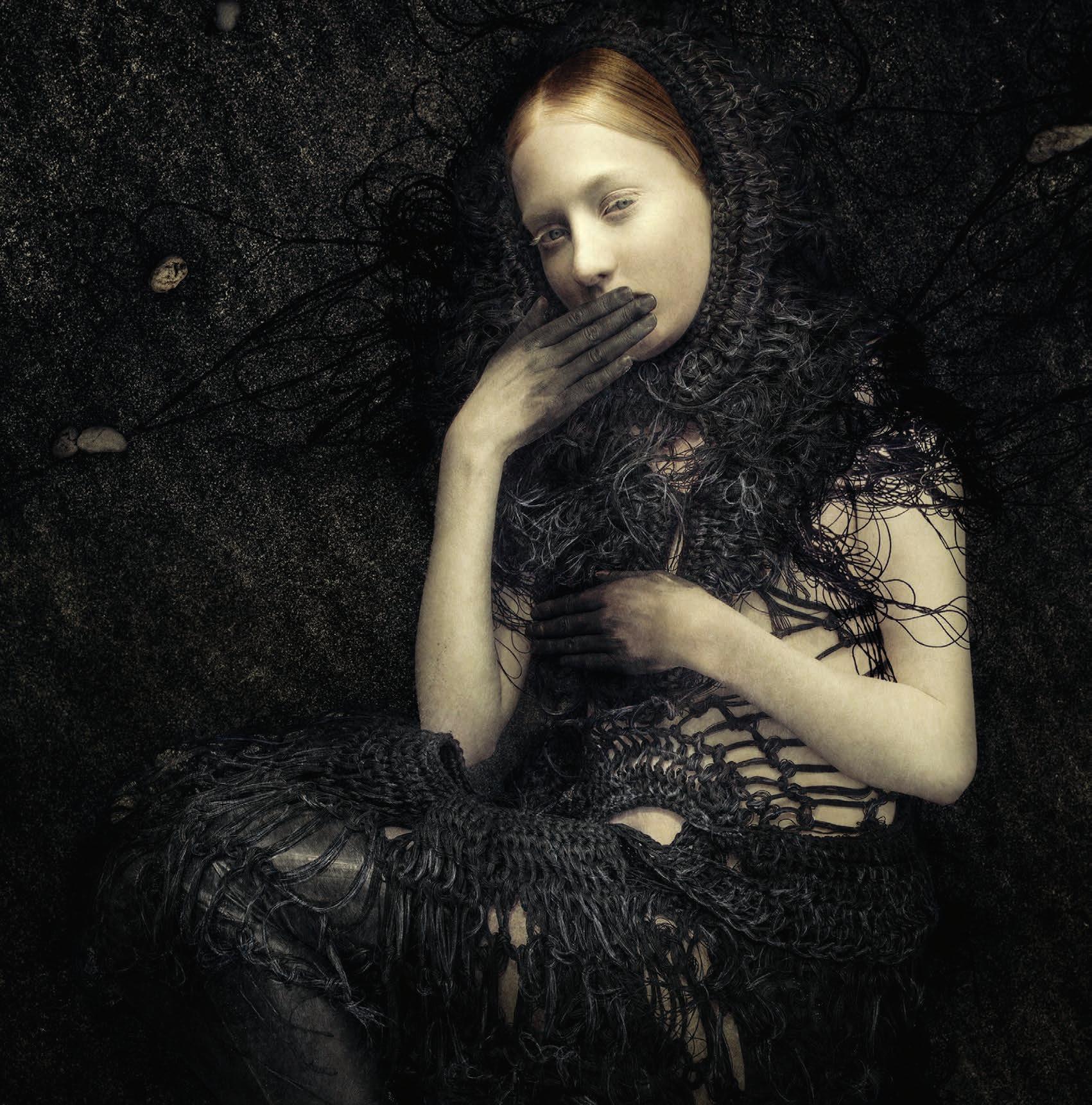
The Photography of Anders Beer Wilse 24
Magnus Nilsson 32

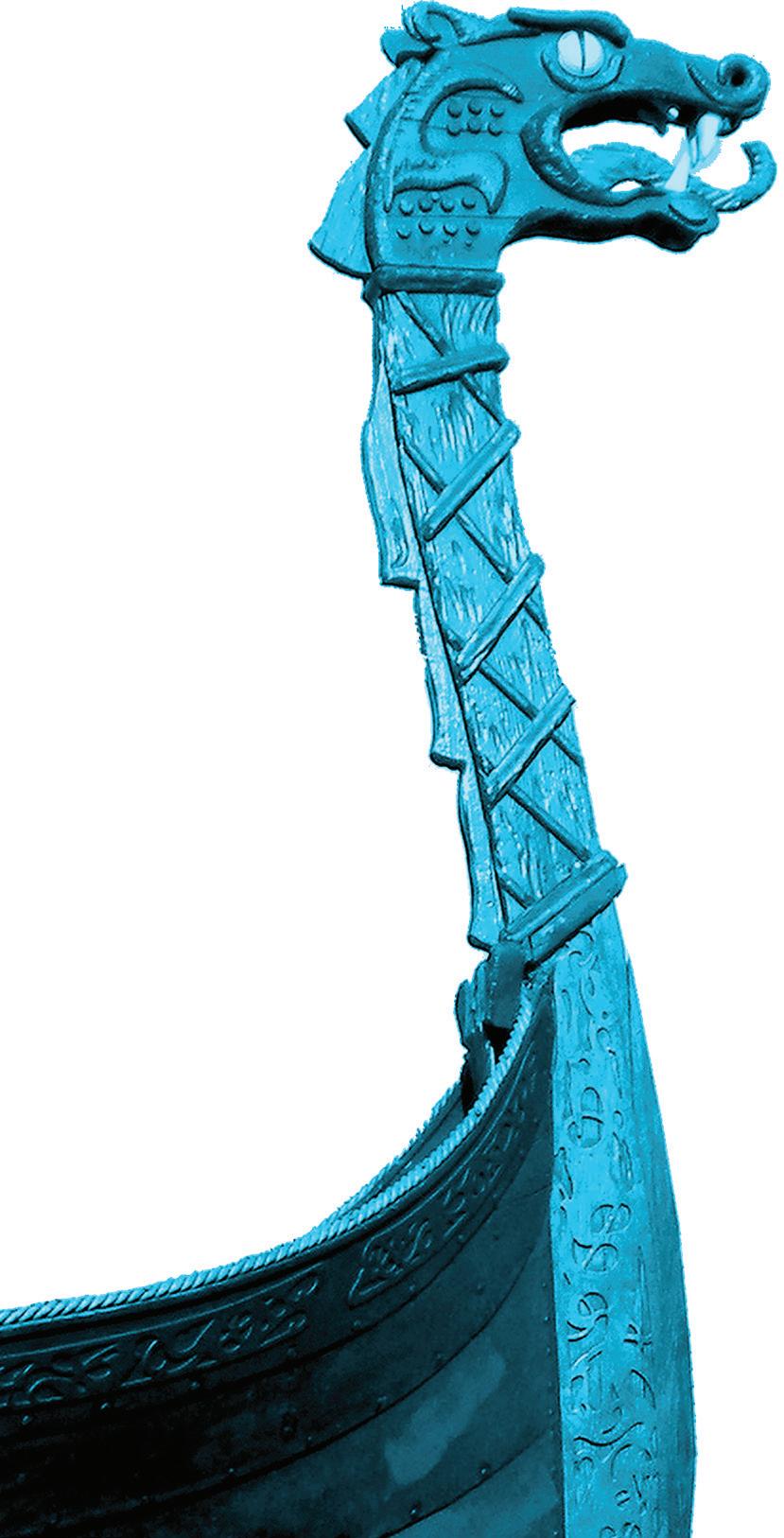
August 20 & 21, 2016
November 19 & 20, 2016
Members & Kids under 12 free; General Admission $5
Handcrafted Gifts * Live Music * Nordic Food & Drink * Photos with Santa
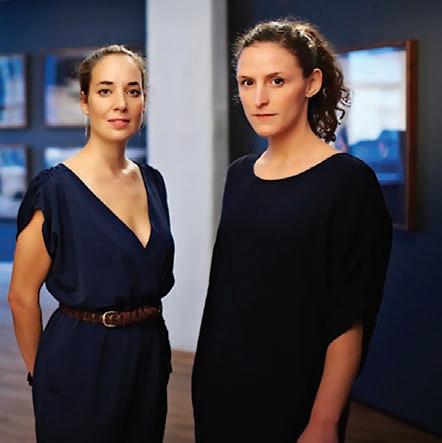
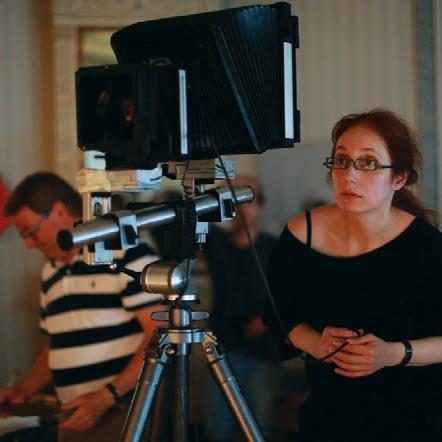
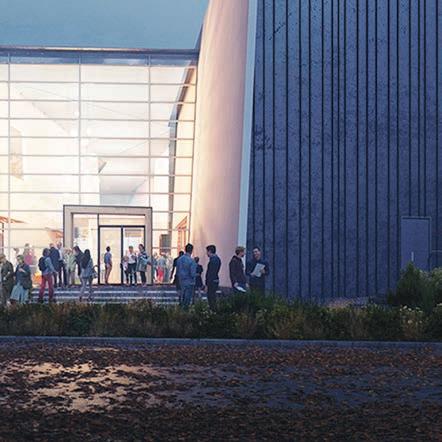
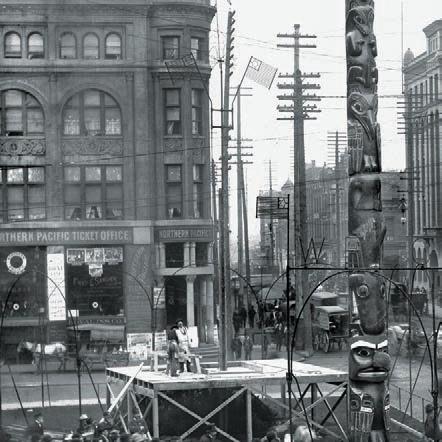
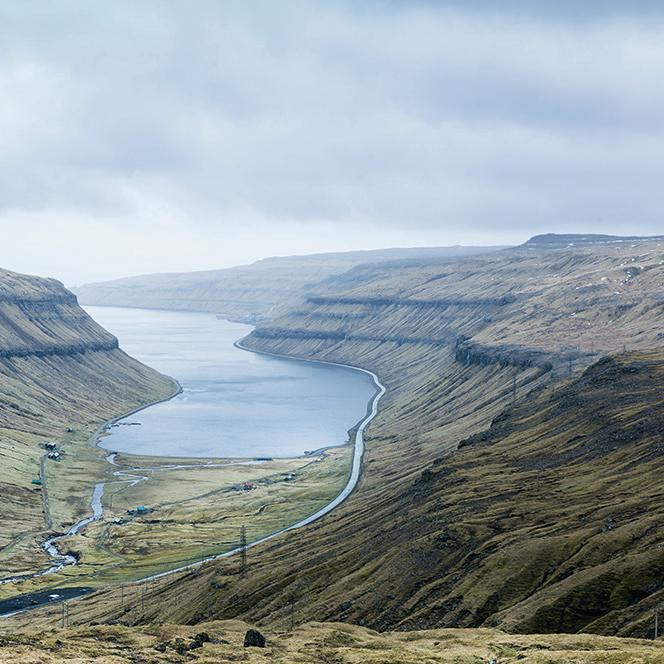
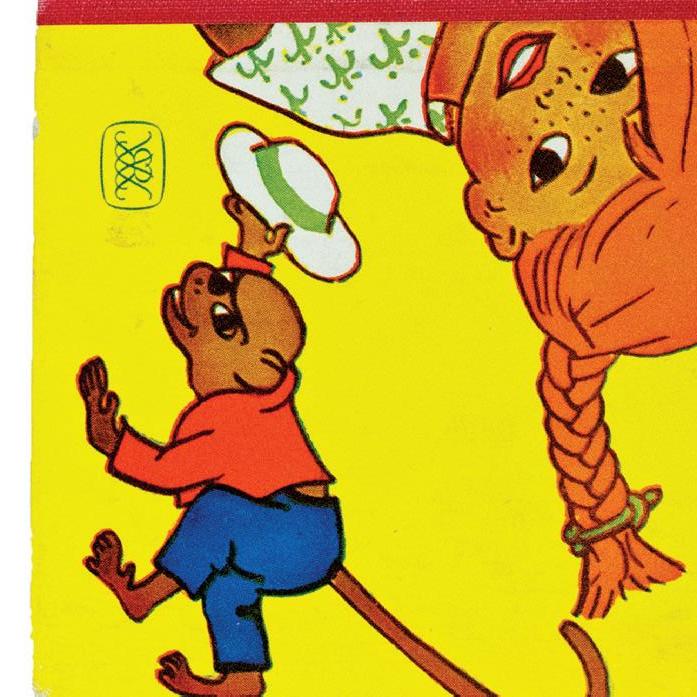

nordic KULTUR 2016

Become a Member of Nordic Heritage Museum
Benefits Include:
Membership card allowing unlimited free admission for each Member
10% discount in the Museum Store
Kids’ Corner emails
Subscription to Nordic News and Nordic Kultur
Discounted tickets to educational programs and events
Member-only exhibition previews
Behind-the-Scenes Tour Night (once a year)
Member Appreciation Weeks (20% discount in Museum Store, twice a year)
The magazine of Nordic Heritage Museum
EDITORIAL BOARD
E ric Nelson Chief Executive Officer
Jan Woldseth Colbrese Deputy Director of External Affairs
K irstine Bendix Knudsen Executive Assistant
E lizabeth Martin-Calder Marketing Consultant
S andra Nestorovic Deputy Director of Operations
Fred Poyner IV Collections Manager
A ni Rucki Graphic Designer
Jonathan Sajda Program Manager
BOARD OF TRUSTEES
Trustees
Hans Aarhus | Per Bakken | Steven J. Barker (Treasurer)
Anne-Lise Berger | E arl Ecklund | A rlene Sundquist Empie
Lotte Gavel Adams | I rma Goertzen (President) | Tapio Holma
Christine Ingebritsen | Ken Jacobsen | Sven Kalve | Jane Klausen
Thomas W. Malone (Vice President) | Valinda Morse | Kurt Ness | Allan Osberg
Einar Pedersen | R ick Peterson (Secretary) | Erik Pihl
Vi Jean Reno | M aria Staaf | Birger Steen | Nina Svino Svasand
Tor Tollessen | M argaret Wright (Immediate Past President)
Consuls
Erik D. Laursen, Denmark | Matti Suokko, Finland
Kristiina Hiukka, Honorary Vice Consul, Finland | Jon Marvin Jonsson, Consul General, Iceland
Geir Jonsson, Honorary Vice Consul, Iceland | Kim Nesselquist, Norway | Lars Jonsson, Sweden
Honorary Trustees
Dr. Stig B. Andersen | R epresentative Reuven Carlyle | L eif Eie | Synnøve Fielding
Senator Mary Margaret Haugen | F loyd Jones | S enator Jeanne Kohl-Welles
Bertil Lundh | M ark T. Schleck | R epresentative Helen Sommers
Mayor Ray Stephanson | R epresentative Gael Tarleton
STAFF
E ric Nelson Chief Executive Officer
Jan Woldseth Colbrese Deputy Director of External Affairs
S andra Nestorovic Deputy Director of Operations
K irstine Bendix Knudsen Executive Assistant
Curatorial
Fred Poyner IV Collections Manager
Jonathan Sajda Program Manager
A lison Church Children’s Education Coordinator
Stina Cowan Public Programs Coordinator
S arah Olivo Adult Education Coordinator
K athi Ploeger Music Library Archivist
A riane Westin-McCaw Registrar
C laire Wilbert Registrar
Development
K aty Ahrens Development Associate, Stewardship
Nick DeCicco Grant Writer
Jenny Iverson Events & Sponsorship Coordinator
K elsey Svaren Membership & Database Coordinator
Marketing & Communications
E lizabeth Martin-Calder Marketing Consultant
A ni Rucki Graphic Designer
Operations
Pamela Brooks Finance Manager
D onna Antonucci Caretaker
R ebecca Bolin Weekend Receptionist
C arolyn Carlstrom Bookkeeper
M ichael Ide Volunteer & Staff Resource Coordinator
M ary Ann Namvedt Museum Store Manager
Sune Sandling Facilities Coordinator
NORDIC HERITAGE MUSEUM
3014 NW 67th Street, Seattle, WA 98117
206.789.5707 | nordicmuseum.org
Welcome to Nordic Kultur, the magazine of Nordic Heritage Museum. This edition coincides with a tremendous event: the groundbreaking for our new building in the downtown Ballard neighborhood of Seattle. Years of preparation, planning, and hard work have culminated into a visionary design for the New Nordic Museum. Among a host of new experiences planned for the facility is an expanded core exhibition which will chronicle the parallel histories of Nordic communities in Europe and North America. Nordic sagas will provide a powerful metaphor for the exhibition journey, encouraging us to reach back into the deep past, as well as to explore more recent history, focusing on the values and attributes of the Nordic peoples.
For this fourth issue of Nordic Kultur, several exhibitions and programs are highlighted, starting with The Weather Diaries which showcases West Nordic fashion photography inspired by the dramatic physicality of nature. Stockholm-based artist Nathalia Edenmont captures fantastic dreamscapes with her riveting imagery. And Magnus Nilsson’s Nordic: A Photographic Essay of Landscapes, Food, and People, presents a pictorial essay that reflects connections between the Nordic people and their environment.
Big Jake Bjarnason: The Gentle Giant comes to life with the story of his birth in Iceland to his career as a police officer and sheriff in Ballard over a century ago. His enormous stature and good-natured spirit kept the frontier town safe for a steady influx of Scandinavian immigrants to the area. The highly successful Nordic Lights Film Festival held at the Seattle International Film Festival brought audiences a chance to view The Fencer, a film directed by Klaus Härö, recognized this year as a Golden Globe nominee for Best Foreign Film. We were very fortunate to interview Härö for this issue, and glean his insights into the challenges of making this beautiful film. In addition, a fascinating interview with the founders of the Odin Brewing Company provides a look into the Icelandic origins of this fine craft brewery.
For a look backstage, we describe the journey behind a recent addition to the Museum’s permanent collection: Marita Huurinainen’s “Emo” Dress, and the donation of two important books to our children’s literature archives. Also, you can read about our exciting plans for a Cultural Resource Center in the new museum, serving as a home for our expanding Nordic American Voices library.
When Nordic Heritage Museum opened its doors in 1980, few could have imagined the reality of a spectacular new building. It is to the credit of our members, board, volunteers, and staff that we can truly envision a bright future for the Museum.
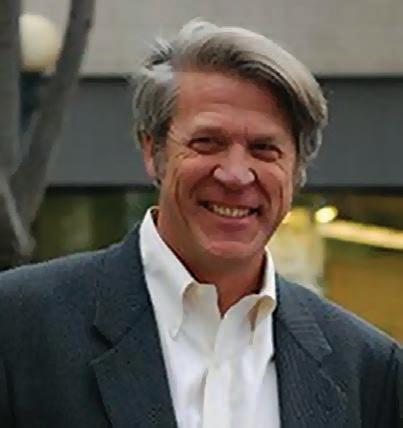
Eric Nelson CEO, Nordic Heritage Museum
One-of-a-kind installations from selected designers and large-scale photographic artworks by Sarah Cooper & Nina Gorfer
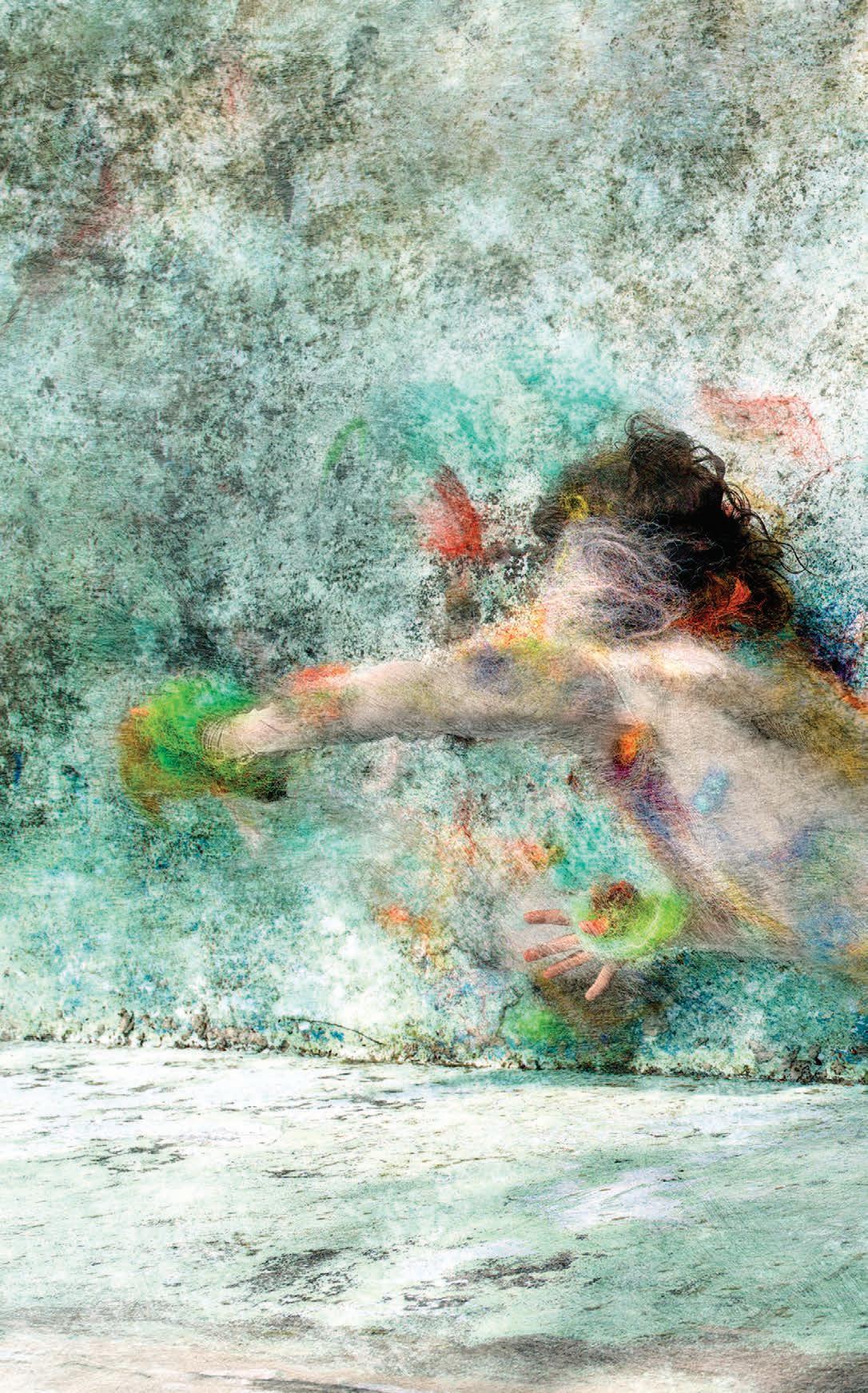
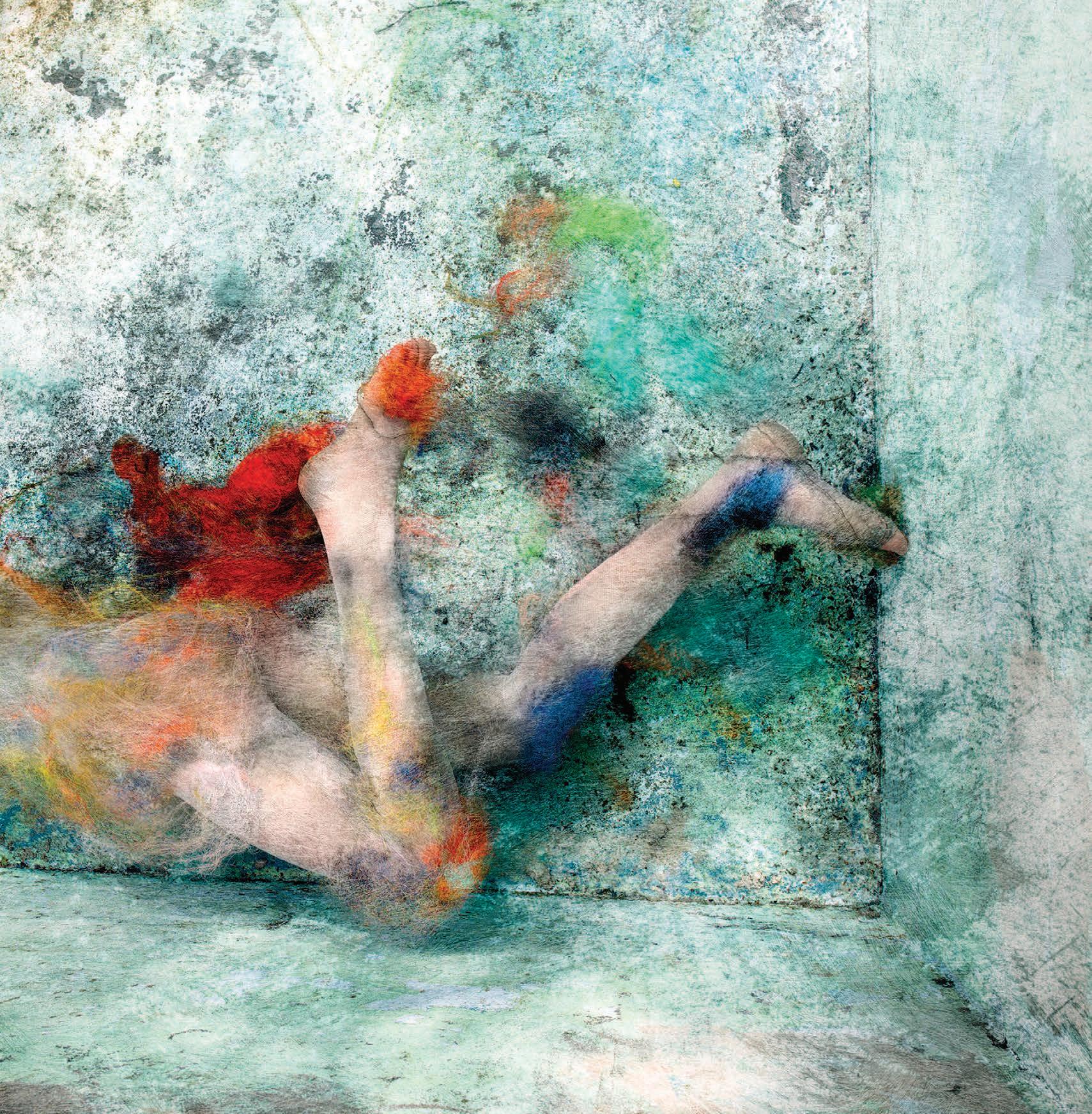
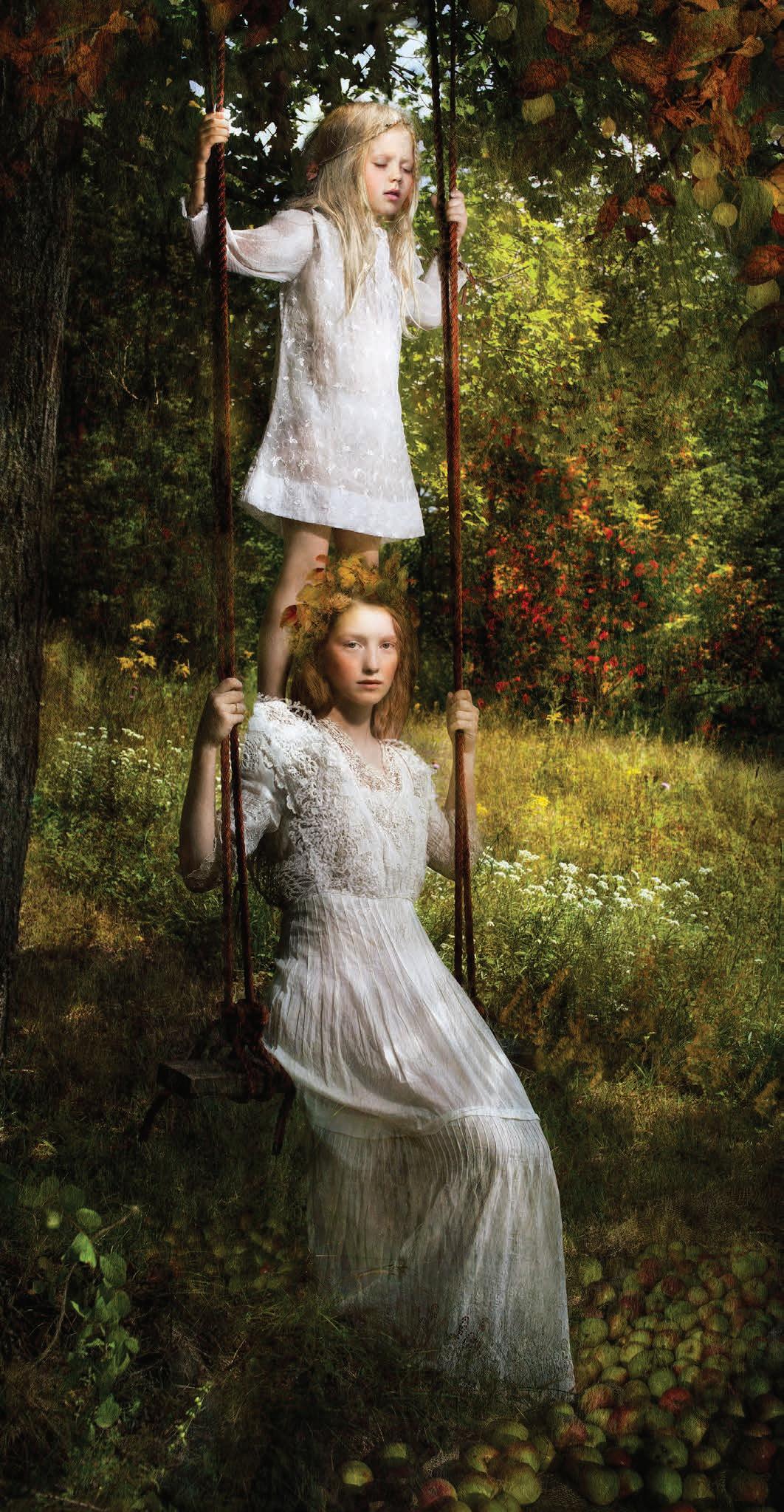
On assignment from Nordic House Reykjavik, the artist duo Cooper & Gorfer explore the driving forces of creativity behind the fashion of three remote areas of the North Atlantic: Iceland, the Faroe Islands, and Greenland. Over two years the artists collected stories from local designers and artisans, whose artistic expression have been shaped by the cultures, traditions, and surroundings of the far western Nordic region. Common to the three islands is their isolation, limited resources, wild nature, and unpredictable weather.
Instead of depicting their findings objectively, Cooper & Gorfer create ambiguous stories, the truth of which are poetic and subjective. They interpret present day North Atlantic identities by effortlessly crossing genres from centuries of visual culture. The resulting body of work is a prolific collaboration between Cooper & Gorfer and some of the most gifted designers and artists from the North Atlantic Islands; a fabulous record from a journey to places where the weather molds the people.
The breathtaking exhibition The Weather Diaries is on view at Nordic Heritage Museum August 12–November 6, 2016.
“The Weather Diaries” is a metaphor for many of the themes addressed in this exhibition. The West Nordic islands, Iceland, Greenland, and the Faroe Islands are privy to extreme weather conditions and seasonal periods of total darkness and light. The exhibition explores the roots of West Nordic fashion, and its inimitable creativity and aesthetics, under this umbrella of the strong impact of weather and nature. “Seldom do we see such pleasure for the creative process as we have found in the artists and designers presented here,” explain Cooper & Gorfer.
The exhibition showcases one-of-a-kind installations from select designers alongside large-scale photographic artworks by
Cooper & Gorfer. Below is an excerpt from the accompanying exhibition catalog, produced by Nordic House Reykjavik and distributed by Gestalten. It showcases personal essays, exclusive interviews with the participating designers and artists, and the photographic works by Cooper & Gorfer, as well as other anecdotal references.
No, no, no, we couldn’t find it if our lives depended on it! How could we miss it? It was supposed to be here. We were supposed to drive to the end of the road and continue on up the gravel driveway leading to a gate (which we were to carefully close behind us—the sheep, you see).
“After the gate, drive until the road ends,” Ilmur had told us. “There, up on a little hill, with the forest to the right, you will find it.” But there we were, hiking on a small trail through thorny terrain, and it was nowhere to be found. We had driven as instructed, until the gravel strip had become so narrow we concluded the road must have ended. Maybe we had taken a wrong turn somewhere. But where? It’s not like Iceland has an abundance of roads, after all. In the end, we did not find what we were searching for that blue and windy day in early June 2013. Despite our collective efforts, we could not find the road that would lead us to the abandoned house.
Once they were many. Easy to find, scattered along roadsides, on hill tops, and strewn about empty plains. Many of them witnesses of a time long gone, with their flowery wallpapers and painted wooden floors. In some houses, the cups would still be on the kitchen table, the bed left unmade. People must have just walked out of their house one day, suitcase in hand, never to return. Iceland surely is a place of stories.
A place that, through a paradoxical familiar strangeness, strikes a chord in our imagination. There is of course its mythical nature, young enough to remind us of the forces that shaped the earth. There is also, far more subtly—and hardly noticeable on the first visit—the nature of its people,
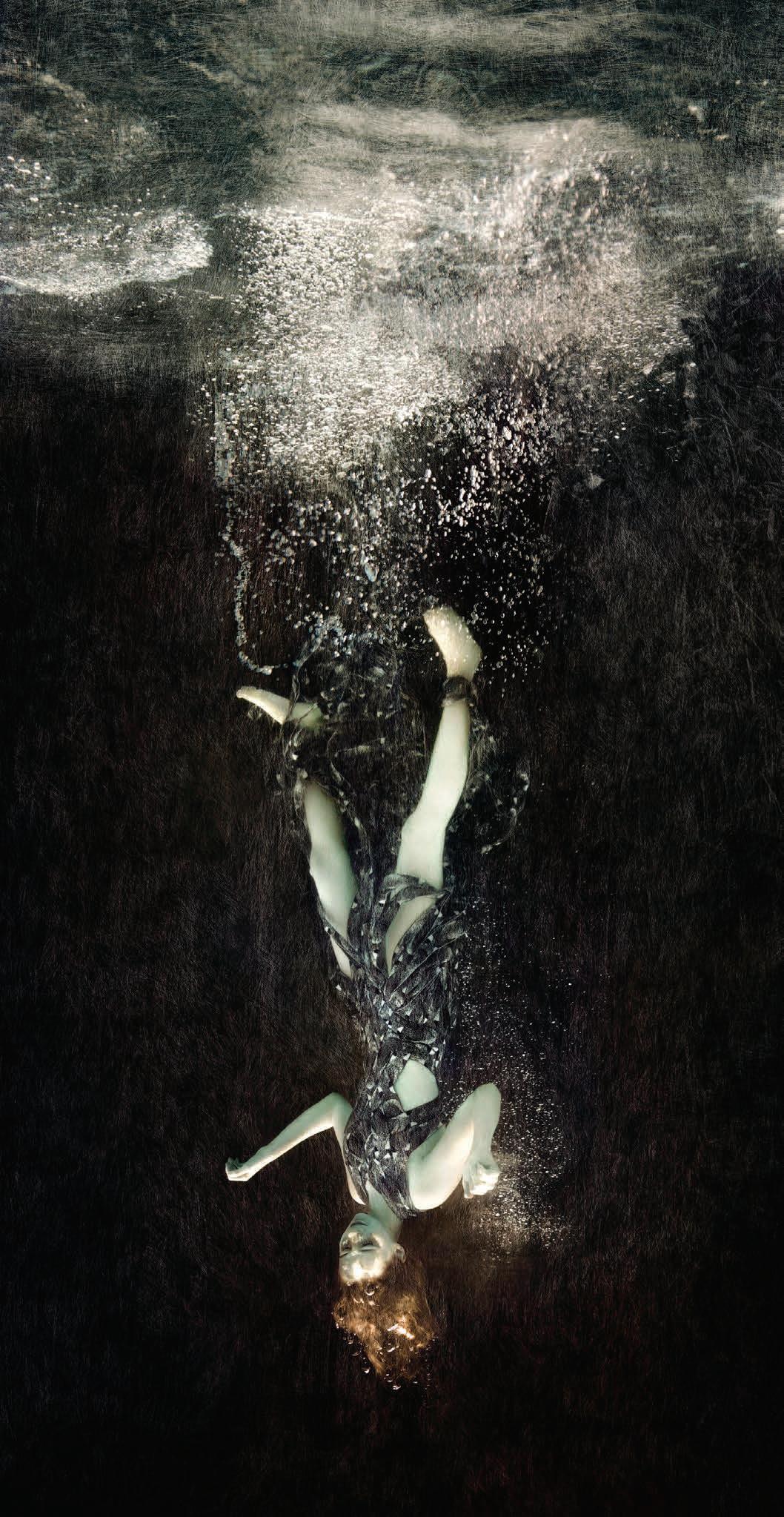
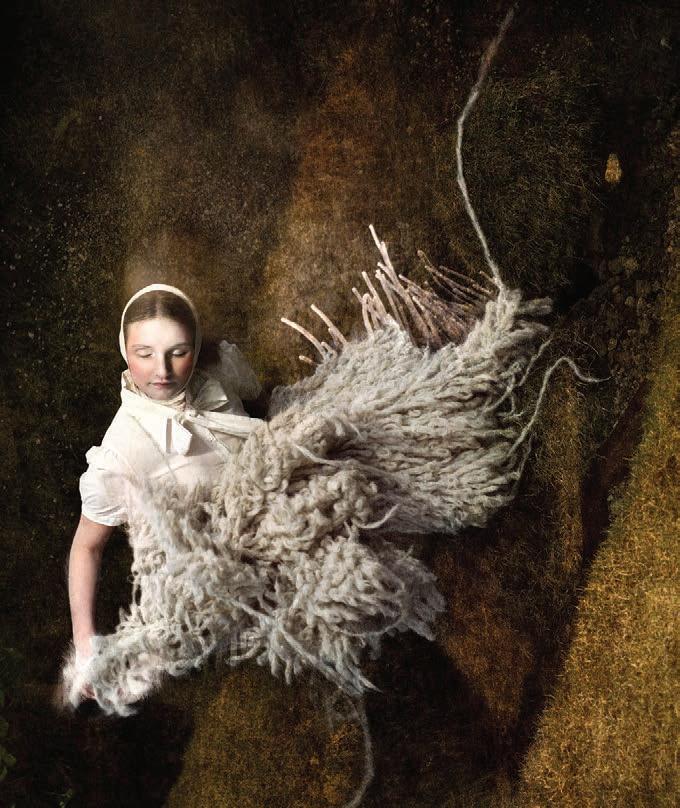
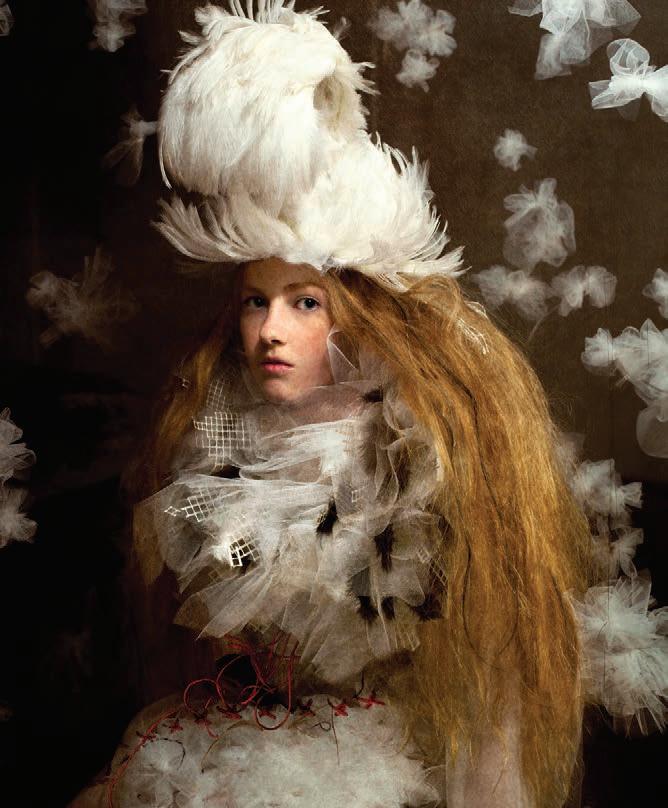
who strangely seem to resonate with a more essential, a more primal, part of ourselves.
It was early January 2012, when we were asked to curate the third Nordic Fashion Biennale, scheduled for 2014. As artists, we were initially skeptical of this request. We have never considered ourselves curators, and are far from what one might call fashion experts. But it was hard to hide the excitement this proposal infused into us. After all, it was Iceland that had fostered our first artistic project. It began with a car crash during a blizzard in October 2005, and ended with us creating our first book. The wild Icelandic weather that had scared us into obedience, had also set the seed for our collaboration as artists. More importantly, it had produced the profound friendship we have today. There is an unrelenting magic to a place such as Iceland, so naturally we said yes to the request.
What followed was a two-year-long investigation in the West Nordic Region— Iceland, Greenland, and the Faroe Islands —with a focus on fashion. It literally was months of discovery.
Revisiting Iceland had a strong personal meaning for us. But our travels to the Faroe Islands and Greenland opened up new alleyways, raised new questions, and stimulated both our minds and inspiration.
That the first human settlements on the eighteen rather small Faroe Islands have braved the elements, tells of the stubborn and adventurous nature of humanity.
Like the Faroese artist Edward Fuglø put it during our interview at his house in Klaxvik, “It is strange to see when the schoolteacher points to the world map, halfway between Iceland and Scotland, where all you see is blue, saying, ‘We are here, here are the Faroe Islands.…’ It’s odd to grow up on a place that does not even exist on a map.”
Greenland has a story and history all its own. For people outside Denmark it surely must feel peculiar that this vast land of ice could be part of Denmark, part of Europe, part of anything at all other than itself. A rich, majestic, beautiful place. And difficult, in many ways. From our research, it would now be preposterous not to see the effects the long Danish ascendancy had on the Greenlandic Inuit culture, for good and for bad. Foreign domination always leaves its traces. And it is this that we set out to investigate: What impact does cultural heritage and the place you grow up have on your inspiration? How does it influence your creative personality?
In many ways, Iceland, Greenland, and the Faroe Islands have their own
idiosyncrasies—each one of them with their own unique identities and stories. But still, we found in all of them a jaunty indomitability, if such a thing could exist, not only toward creativity but toward life at large.
Weather moulds behaviour, and isolation forges a pool of creative bravery. It is a part of the world where market values don’t have to make sense, because the forced freight of commercialism is rarely loaded.
The book in your hands is intended to convey aspects of these northern islands that have enthralled us. In the aftermath of hardship and seasonal darkness and light, reiterative and merciless in its completeness, emerges a relentless creativity. The cultural isolation and the overpowering force of nature spawn the seed of a raw and authentic inspiration.
…They have in common a fearlessness towards creativity, an urge to create for creation’s sake. It was a liberating experience to have had the luck to work with people who are so uncommonly authentic and enchantingly fun, people who remind us of the childlike wonder and indulgence of a mind at play.
Sarah Cooper & Nina Gorfer, Artists Curators of The Weather Diaries
January 29–April 24, 2016
A story of rescue and resistance against Nazi persecution. Approximately 7,200 lives were saved, through the efforts of Danish citizens who ferried Danish Jews by boat to safety in Sweden. This has come to be known as one of the biggest instances of an organized effort against the Nazis during WWII. Exhibition originated by The Museum of Danish Resistance 1940–1945/The National Museum of Denmark, and traveled by The Danish Immigrant Museum in Elk Horn, Iowa.
March 18–May 8, 2016
Heralded as one of the top twenty chefs in the world, Magnus Nilsson is the head chef of Fäviken restaurant in Sweden. Nilsson’s first museum exhibition highlights his original travelogue photography— an illustration and examination of Nordic food culture that unravels the mysteries of Nordic ingredients and introduces the world to Nordic culinary history and cooking techniques. Premiering in the US at Nordic Heritage Museum, the exhibition features Magnus Nilsson’s photography, stories, and recipes from his new book, The Nordic Cookbook (Phaidon, 2015). Exhibition produced by the American Swedish Institute (Minneapolis, MN).
April 29 – July 10, 2016
Americans and Norwegians have explored uncharted areas in the Polar Regions for more than a century. Many of the first discoveries in the Arctic and the Antarctic were made by Norwegian or American expeditions, or by Norwegian and American explorers working together. This exhibition is a celebration of their efforts and their contribution to our knowledge of the ends of the Earth. Produced for Nordic Heritage Museum by The Fram Museum (Oslo, Norway).
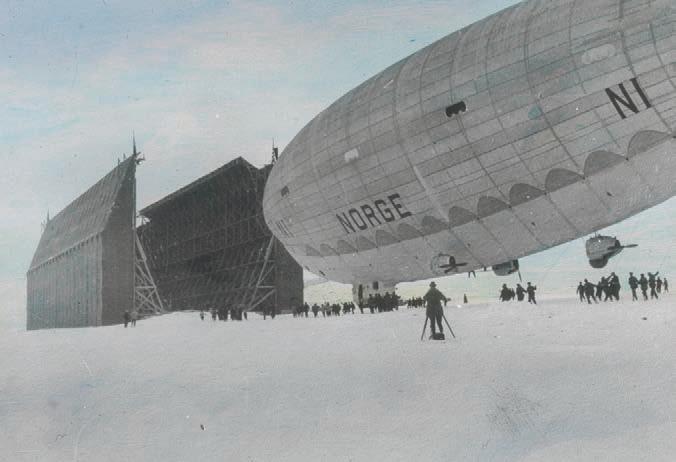
May 20–July 24, 2016
Probing and provocative, Nathalia Edenmont’s photography speaks to life’s inherent truths through a visceral engagement with her own turbulent existence. Rich in symbolism and with clear references to historical genres of art, Edenmont’s frequently beautiful and challenging arrangements can be viewed as a modern expression of traditional iconography. Her autobiographical work explores the darker recesses of her troubled childhood and teenage years in Ukraine, where she resided until moving to Stockholm in 1991. The exhibition features sixteen richly-colored, large-format photographs. Organized by Nordic Heritage Museum with support from Nancy Hoffman Gallery (New York) and Wetterling Gallery (Stockholm).
August 12–November 6, 2016
The Nordic Fashion Biennale (NFB) returns to Nordic Heritage Museum with the latest installment, The Weather Diaries. Photographers Sarah Cooper & Nina Gorfer traveled throughout Iceland, Greenland, and the Faroe Islands to explore the roots of West Nordic fashion. This exhibition explores the inspiration of creative minds, probes links to cultural identity, scrutinizes the impact of the inescapable physicality of nature and weather, and showcases one-of-akind installations from the selected designers, alongside large-scale photographic artworks by Cooper & Gorfer. Featured designers include Mundi (IS), JÖR by Guðmundur Jörundsson (IS), Kría (IS), Hrafnhildur Arnardòttir a.k.a. Shoplifter (IS), Guðrun & Guðrun (FO), Barbara Í Gongini (FO), Rammatik (FO), Bibi Chemnitz (GL), Najannguaq Lennert (GL), Nikolaj Kristensen and Jessie Kleemann (GL). Exhibition produced by Nordic House Reykjavik.
The Photography of Anders Beer Wilse
December 2, 2016–February 28, 2017
Norwegian engineer and self-taught photographer Anders Beer Wilse (1865–1949) lived in Seattle from 1892 to 1900 and left a legacy of early photographs documenting this period of unprecedented growth and change in the city’s history. This exhibition includes Wilse’s photographic images taken both in Washington State and the greater Pacific Northwest region, as well as from select regions in Norway after 1900. Organized by Nordic Heritage Museum and including images from the University of Washington Libraries; the Ballard Historical Society; the Museum of History & Industry (MOHAI); the Norsk Folkemuseum (Oslo, Norway); and the Norsk Teknisk Museum (Oslo, Norway).
Nathalia Edenmont’s world is terrifying and beautiful, sensuous and spartan, fashion-forward and timeless, full of life and brimming with death. Her compositions are straightforward, posing her figures against black seamless backgrounds or white empty spaces. There are no double exposures or blurred reflections, no tricks of the camera, no Photoshop special effects. What you see is what was there, staged before an oversized 8x10 view camera, captured in a single session.
In an age where we have come to doubt the veracity of all photographs—where even documentary photographs are suspect—Edenmont makes images that have not been tampered with in any way. The things we see have actually happened; the image has been built from actual elements. There is no escape hatch or buffer to protect us from these photographs. We cannot say “this cannot happen.” It has happened, as we can clearly see.
Edenmont’s photographs derive their power not from a theoretical framework but from details of her autobiography. Born in Yalta in 1970 when the Ukraine was still part of the USSR, Edenmont had a happy childhood which gave her no reason to question the Soviet propaganda that she learned at school. On an impulse, she asked to go to a children’s art school for her elementary education, a decision her mother supported, and a place where she excelled.
“I think like any other child I liked to draw, but nothing special. When I was nine years old, a neighbor girl, one year older than me, decides she wants to go to art school, so I thought, ‘me too!’ I told my mother and my mother said yes. There we were drawing simple things, like still lifes, but also art history. I remember seeing a picture of a work by Rubens when I was ten years old, I thought all these naked bodies, because in the Soviet Union at the time you never saw anyone naked, I never saw my mother naked, and suddenly I saw all these people naked.”
Nathalia Edenmont is never less than serious when she turns her gaze to Old Master paintings and religious icons. Rather than doubt the power of an image, she is fully invested in their truth. These images first appear to her in her mind, fully formed. Her job is merely to fulfill the vision she has seen by assembling the models, crew, and props necessary to make the dream come true. She has no reason to doubt photographic truth or cast aspersions on the myths surrounding imagemaking. Instead, her goal is solely to bring her reality to a wider public, combining iconoclastic and iconographic impulses.
All was well until young Nathalia’s father died when she was twelve. The following year, she watched her mother suffer slowly in a hospital, an experience captured poignantly in Self-Portrait (Deathbed), in which Edenmont poses as her mother, while her model Cornelia holds her hand. Edenmont recalls that she was home, ironing a dress for her school graduation when a neighbor came to tell her that her mother had died. In shock, she returned to the ironing board, only to find that she had burned the dress. Again, the episode appears repeatedly in her photographs, especially Nostalgia and Devotion in which the clothes on the models are singed and blackened with soot.
“The day I discovered my mother died, I was on my way to get my diploma from school. But when I was handed my diploma, I said to the rector, ‘My mother died.’ He said, ‘What?’ And I said yes. So he gave me my diploma and asked me if I had any relatives. I had no relatives. So he contacted a woman at the Cultural Bureau and told her that he has a student whose mother just died and she has the best diploma. So she contacted an art school in Kiev where I could live. You had to take an examination because many children from the whole country would apply. So three days after my mother died, I made the examination and so I entered the school. I never planned to continue art because my plan was to be a lawyer like my mother but I didn’t have anybody to raise me so I went to this art school where I lived until I was eighteen years old.”
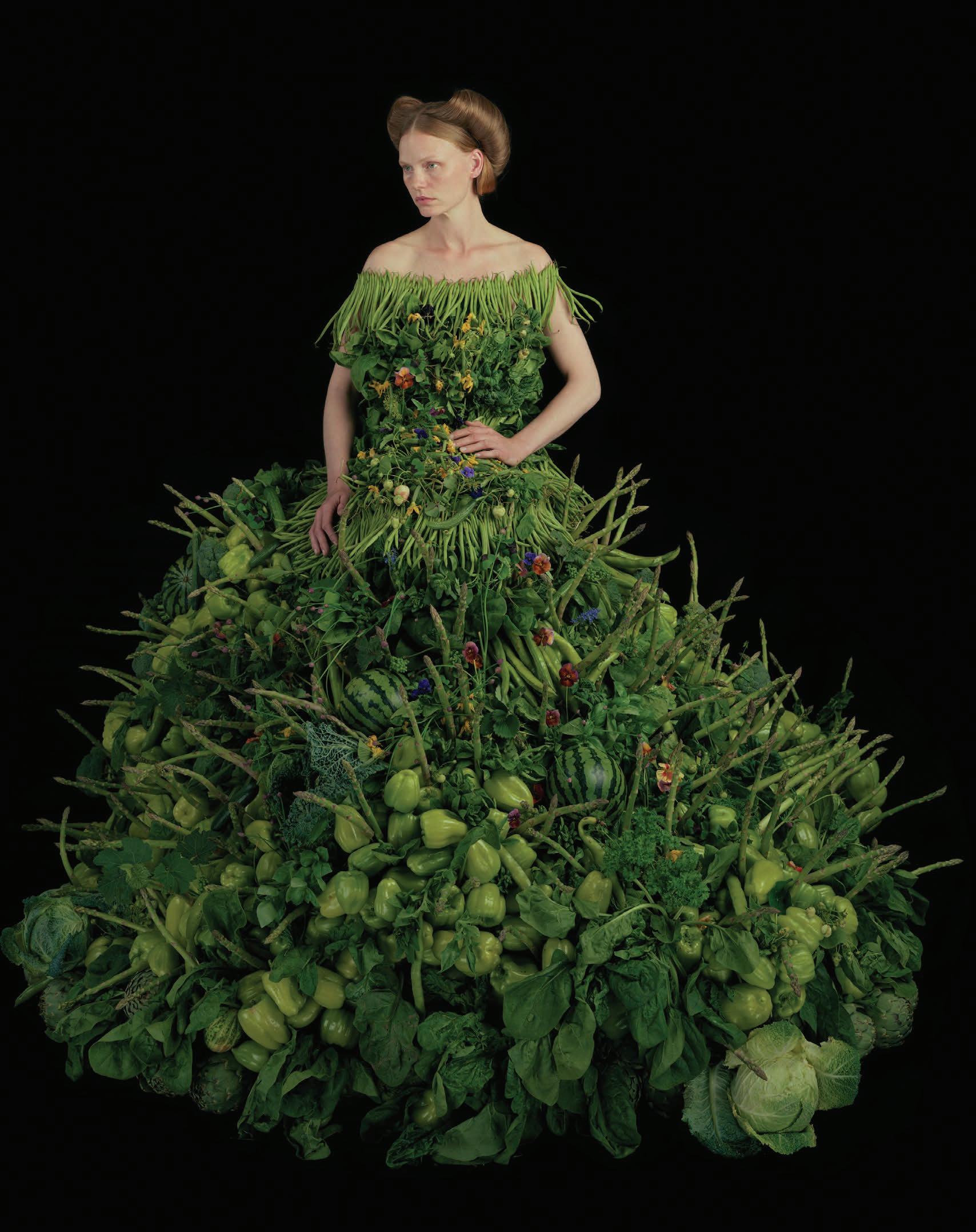
Soon after, at the age of 21, Edenmont moved to Sweden, where she supported herself most often by working as a cleaning woman. Later, under pressure from her second husband to give up painting (Edenmont has been married five times), she attended Forsbergs Skola International School of Design, again hoping for a career as a commercial artist. She was not trained as a photographer, but in graphic design, yet her teachers told her repeatedly that her work did not look commercial. One day, Per Hüttner, a practicing artist and a professor, asked her how she came up with her ideas, because they were by far the most interesting in the class. She said, as she often repeats even now, “I don’t think, I see pictures in my mind.” He asked her to describe a few and immediately responded that that is the work she should be doing. He told her to make an installation that
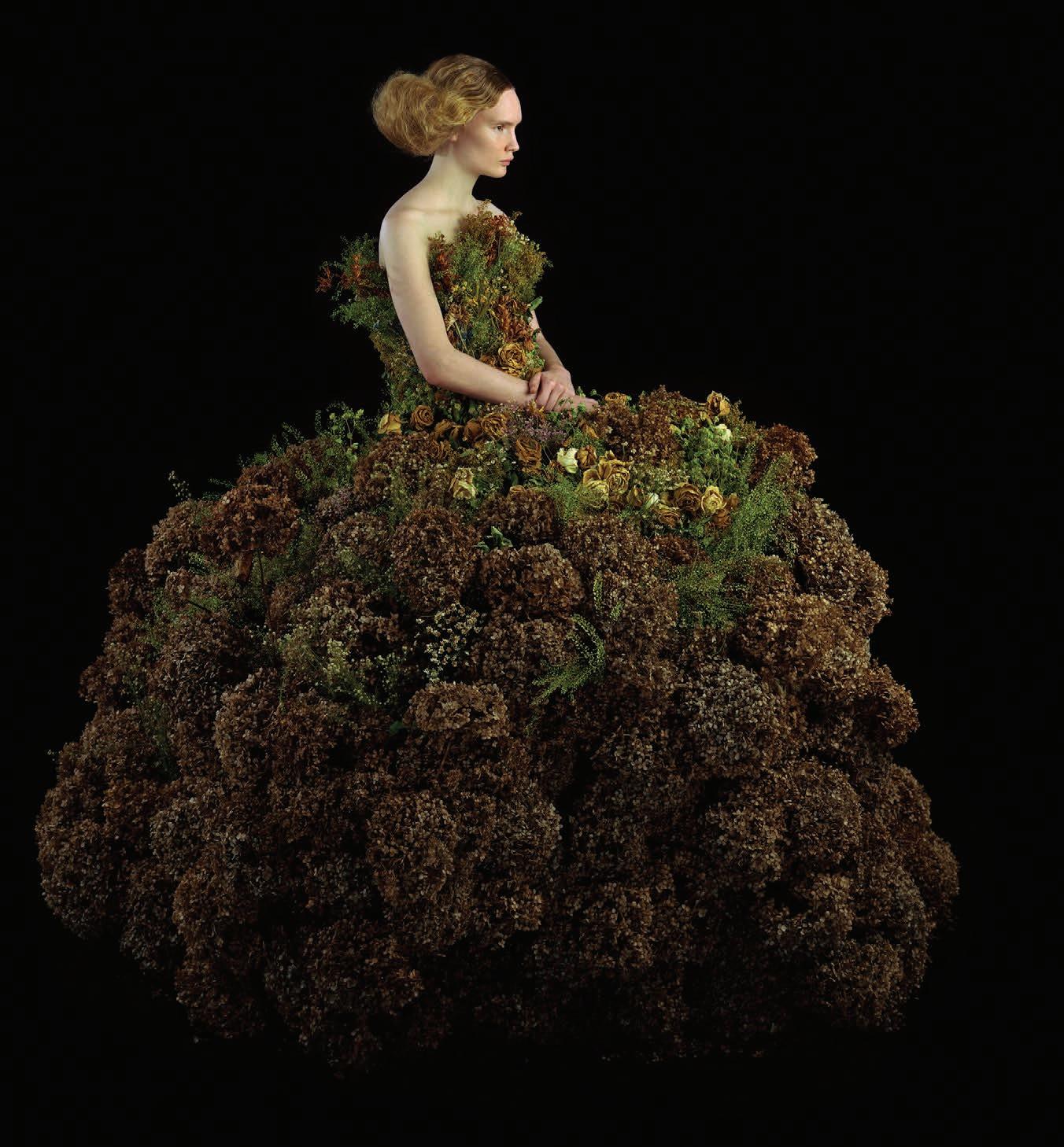
he could photograph. In seeing the results, he announced, “My God, this is the beginning of your career.”
Edenmont didn’t believe him or want to believe him. In her mind, an artist never had a job and never made enough to support himself. She briefly moved to Australia and married once again, only to move back to Sweden, disappointed. She looked up her old professor and asked his advice. “What am I to do?” she recalls asking him. “I think you are an artist,” Hüttner replied. Since she had no job and no new relationship, she thought she was finally free to pursue an art career. In 2003, at the age of 33, Edenmont had her first solo shows at Mors Mossa Gallery in Goteburg, Sweden and Wetterling Gallery in Stockholm.
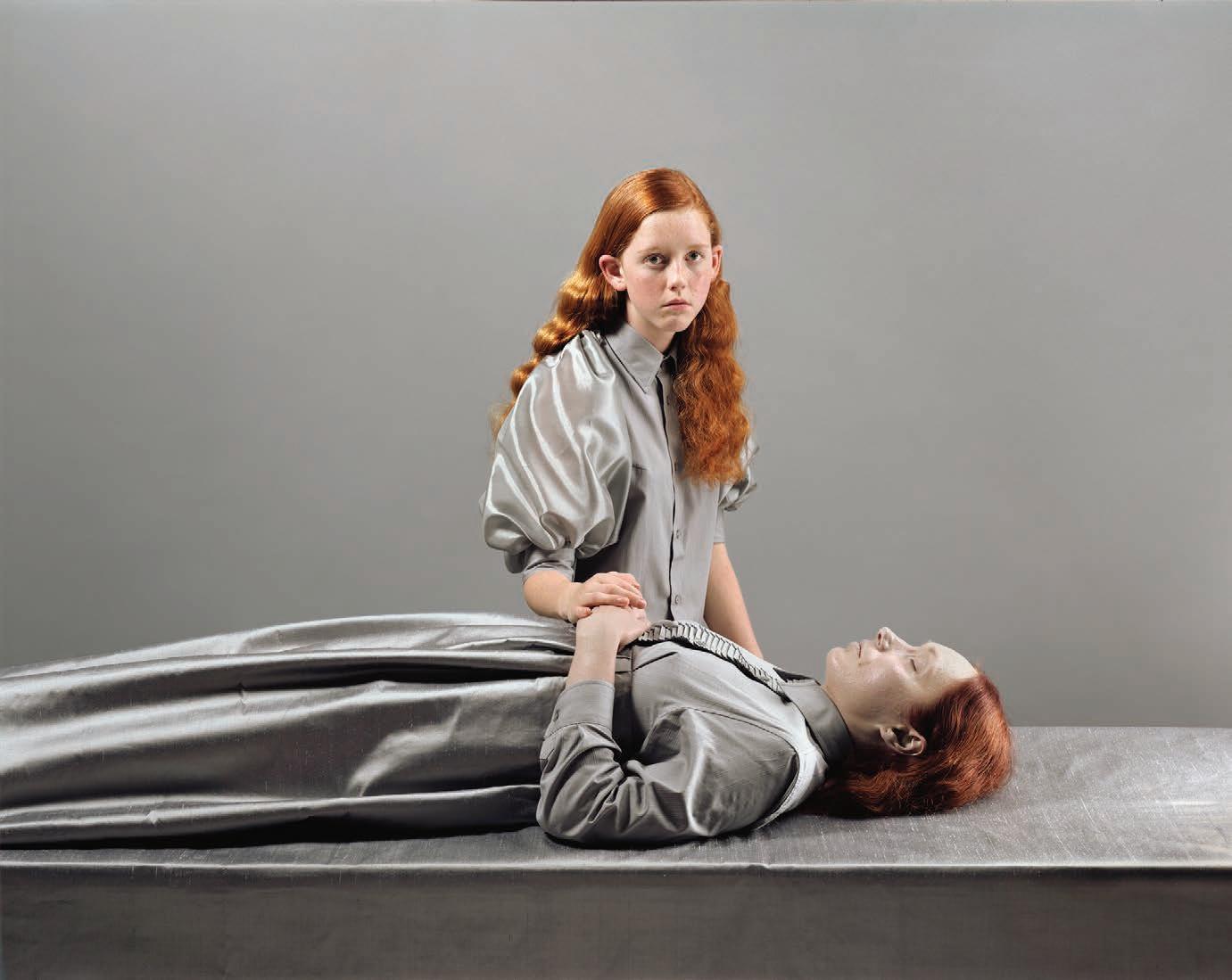
Juxtaposing public and private, sacred and sensual, security and discomfort, Edenmont demonstrates a strong relationship to contemporary artists such as Cindy Sherman, Robert Mapplethorpe, and Andres Serrano. These are artists who challenged the superiority of formal concerns—composition, lighting, framing, and camera angle—to address one of the most universal subjects in photography, the body. Each of these artists turned the body—a key symbol and conveyor of eternal beauty since the ancient Greeks—back into a time-based, gender-specific, amalgamation of flesh-and-bone. For Nathalia Edenmont, her tension between high style and intimate content can be disturbing, but it is also the source of undeniably beautiful photographs.
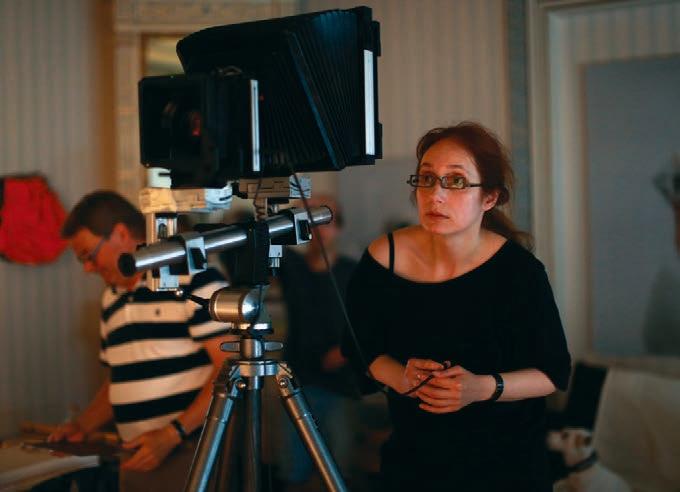
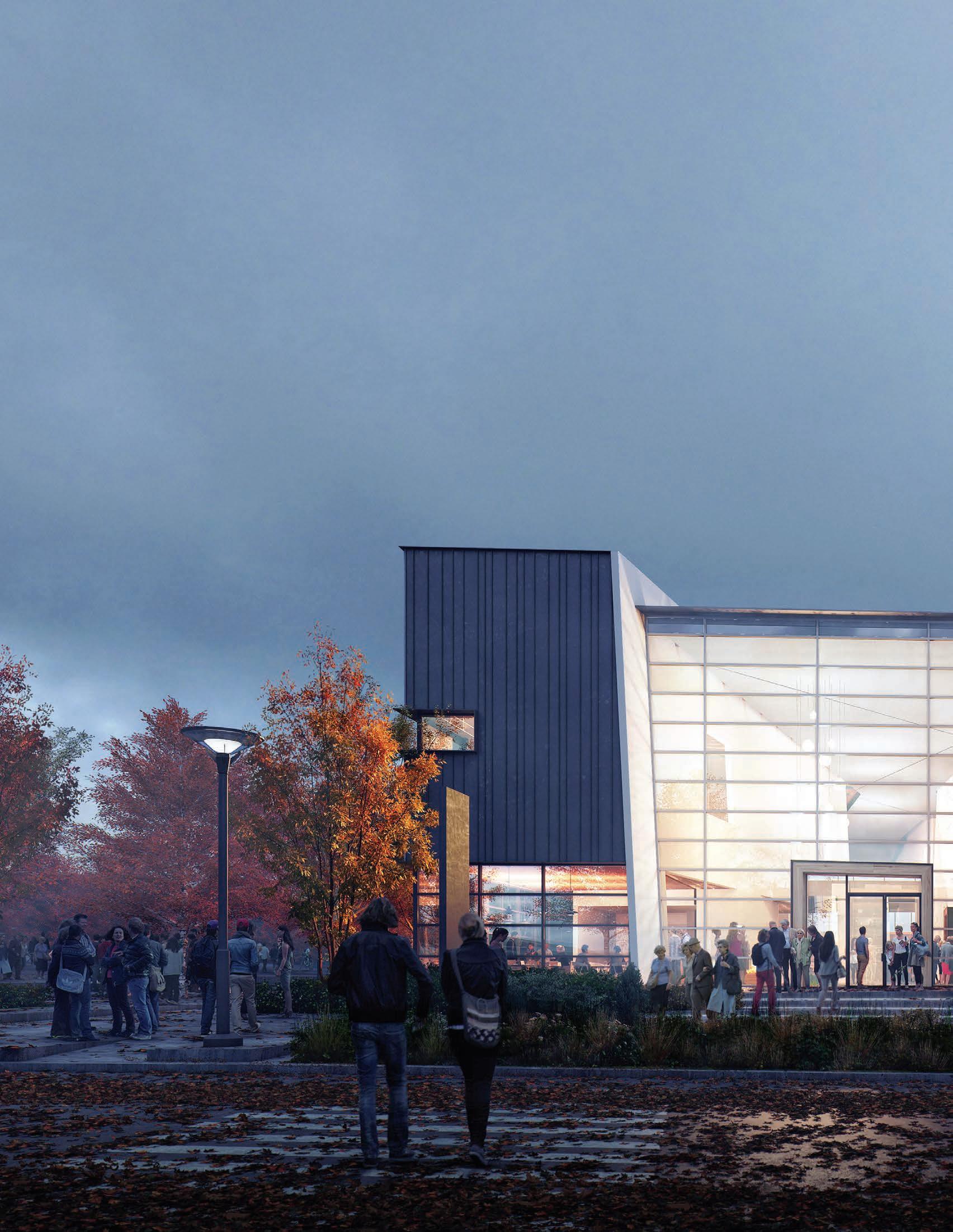
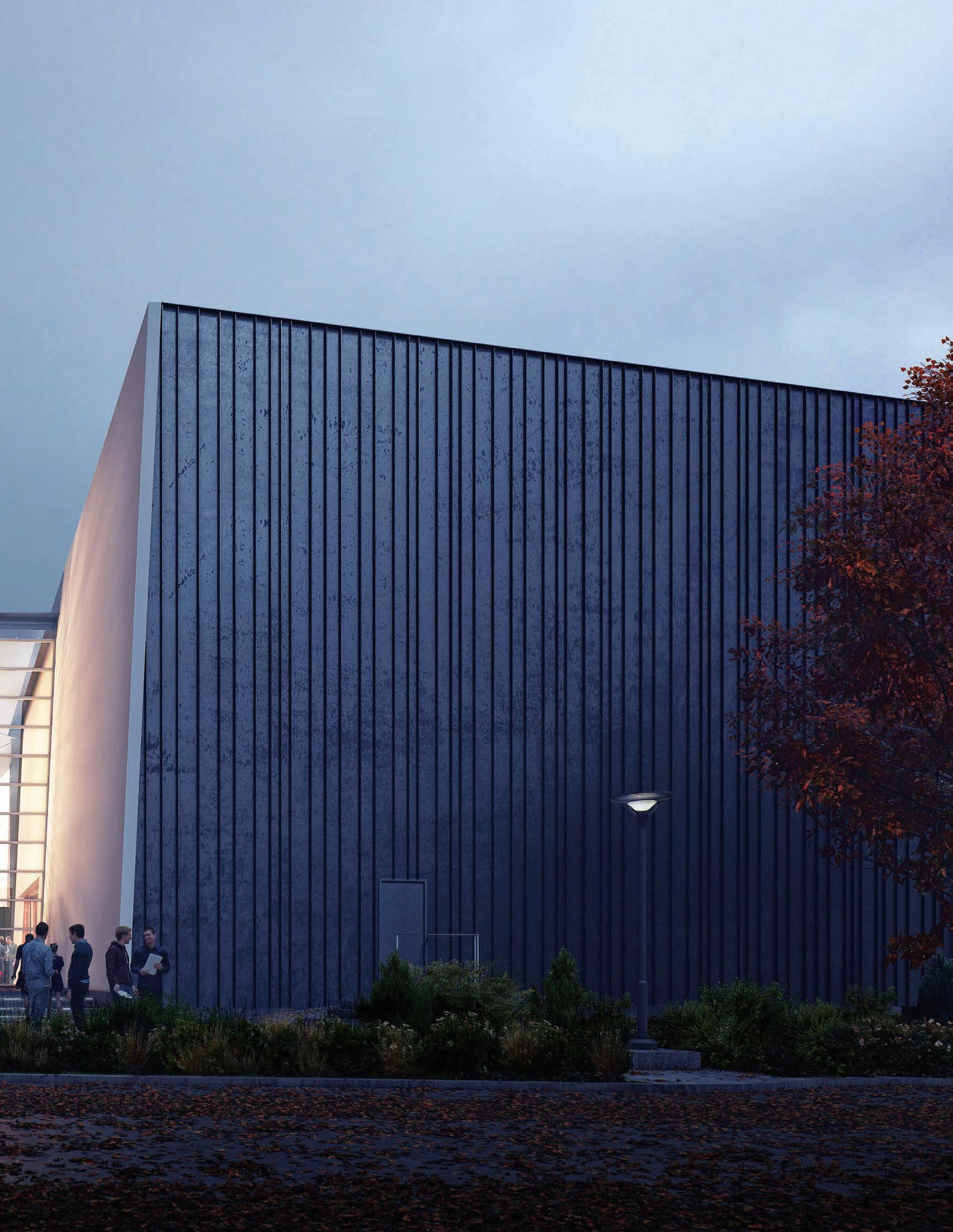
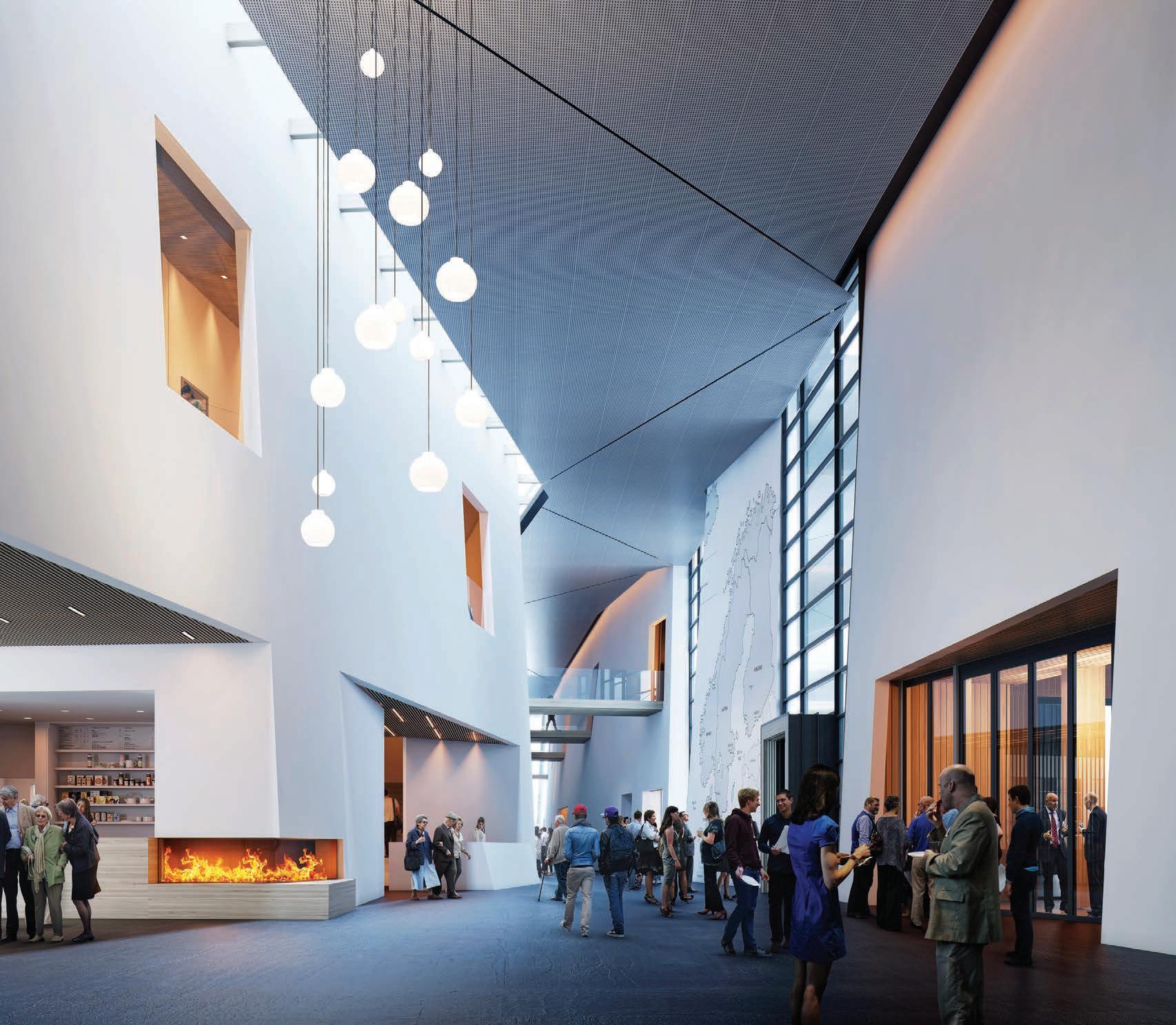
NORDIC HERITAGE MUSEUM is in the final phase of fundraising for a new 57,875-sq. ft. museum and cultural resource center dedicated to the preservation and exploration of Nordic culture. With groundbreaking and a public campaign to begin this summer, opening ceremonies are slated for early 2018.
The new Museum will be located on Ballard’s main artery, Market Street, alongside the vibrant boat docks and the iconic Chittenden Locks—gateway to the Puget Sound, Gulf of Alaska, and Bering Sea.
The newly-designed building includes an auditorium, a museum store, and a café. On the second floor will be a cultural resource center and core exhibition galleries, presenting narratives of both the past and present as a new story emerges—one that explores a continually evolving Nordic culture.
OPENING: Early 2018
NEW MUSEUM LOCATION: 2655 NW Market Street
GROUNDBREAKING: July 30 | 3pm
PUBLIC CAMPAIGN KICKS OFF SUMMER 2016!
Double Your Nordic Spirit with a gift to the capital campaign. Your donation will be matched dollar for dollar. Contact Jan Woldseth Colbrese at 206.789.5707 x39 or janwc@nordicmuseum.org.
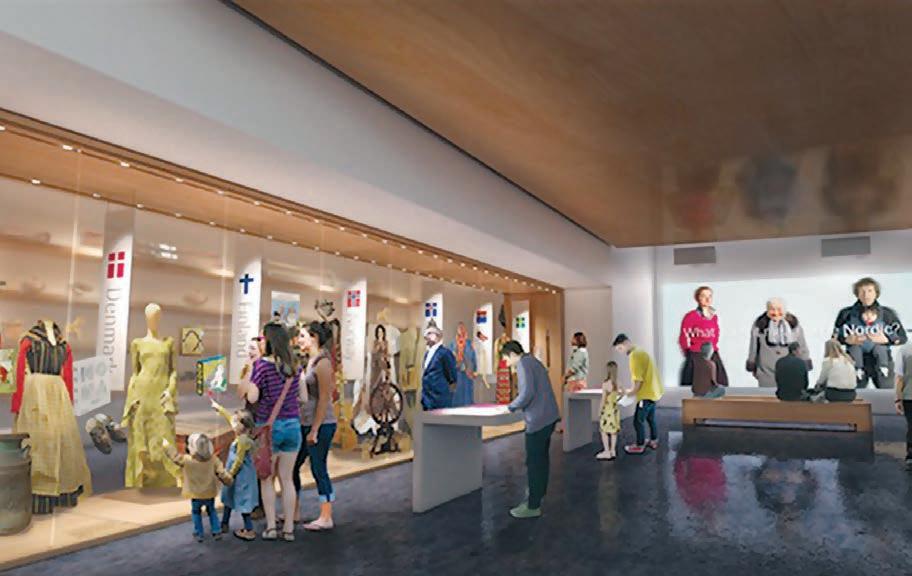
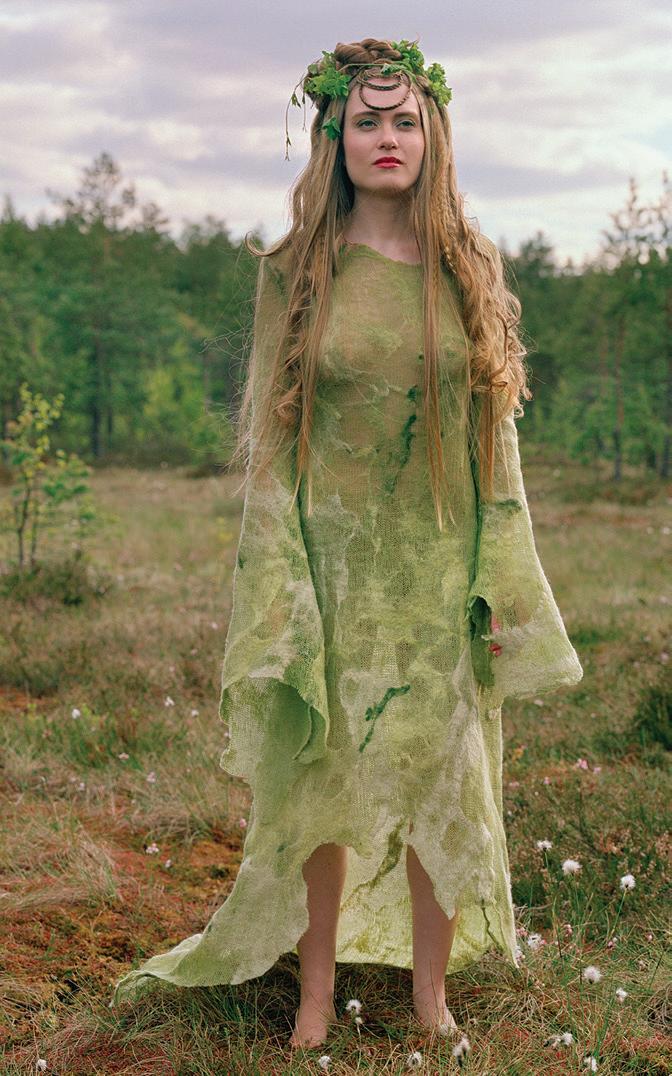
Museums rely on the expertise of Collections Specialists and Registrars to care for all types of objects. Dismantling an exhibition can be as involved as the installation process, requiring detailed steps to insure the protection of each piece. Claire Wilbert assisted with the dismantling of the Museum’s 2015 exhibition, Finland: Designed Environments, originating from the Minneapolis Institute of Art. She describes her relationship with the beautiful “Emo” dress, designed by Marita Huurinainen using fabric by Marja Eivola.
was time for the exhibition to end. Now we needed to remove the dress carefully from its display mannequin without damaging the delicate, unbound neckline. I determined the best way would be to remove the mannequin’s arms, so we could lift the dress with extreme caution over the head. Then we positioned the dress in its archival wrappings and crate and sent it back to Minneapolis.
thoughtfully, taking duct tape and an extra protective bag, just to be sure.
I first saw the stunning “Emo” dress at Nordic Heritage Museum when I visited for my interview for the position of Interim Registrar. It stood out because, as a knitter, I could appreciate the amazing amount of time and effort that went into its creation and the delicacy of how it combined wool and peat.
To my delight, I was invited to become the Museum’s Interim Registrar, so my acquaintance with the “Emo” dress was renewed.
I saw it regularly in the course of my daily rounds as a Registrar, when I checked the exhibition thoroughly. Then, all too soon, it
Soon, however, I learned that Fred Poyner IV, the Museum’s Collections Manager, was preparing to secure the dress for our Museum’s permanent collection. To my surprise, I was asked to courier the dress from Minneapolis back to its new home in Seattle. After many emails and phone calls, we received the signed deed of gift from the artist in Finland. Now, once again, I was to be charged with ensuring the safety of the “Emo” dress!
I’d never served as a courier before. I knew my responsibilities as the Museum’s official representative, but all I could think of were the horror stories drilled into me in graduate school…TSA [Transportation Security Agents] agents ripping into crates or customs officials venting their annoyance on unsuspecting registrars. I couldn’t help wondering what was in store. So I packed
I got to Minneapolis without incident and spent time catching up with family— definitely one of the perks of couriering! Then I headed off to the Minneapolis Institute of Art to pick up the dress. For all my mental angst, the transaction was something of a letdown. I went to the security desk, introduced myself, and the MIA’s registrar brought the carefully prepared dress and her set of documents out to me. I signed her documents and she signed mine. Then I headed out of the museum with my precious bundle of bubble wrap.
Soon I was on my way to the airport for the flight back to Seattle. As I unloaded my laptop and took off my shoes in the security line, I mentally checked my list. I was preparing myself to defend the “Emo” dress against the TSA, my fellow travelers, and any other unforeseen threats.
But as I picked up the dress from the conveyor belt and reassembled my carry-ons, I realized the dangers were almost over. I walked happily to my gate with my precious cargo. Soon I would deliver it to the safety of Nordic Heritage Museum, where it will grace the new Nordic Orientation Gallery as a wonderful example of Finnish design.
$5,000,000+
Osberg Family Trust; Allan and Inger Osberg; Osberg Construction Company
$3,000,000–$4,999,999
The A.P. Møller and Chastine Mc-Kinney Møller Foundation
Jane Isakson Lea* and James Lea State of Washington
$1,000,000–$2,999,999 4Culture
Barbro Osher Pro Suecia Foundation
Breivik Family Trust
Floyd and Delores Jones Foundation
Kaare* and Sigrunn Ness
The Family of Einar and Herbjorg Pedersen
Einar and Emma Pedersen
Scan | Design Foundation by Inger and Jens Bruun City of Seattle
Berit and John Sjong
Robert L. and Mary Ann T. Wiley Fund
Anonymous
$500,000–$999,999
Earl and Denise Ecklund
Jon and Susan Hanson
M. J. Murdock Charitable Trust
The Norcliffe Foundation
$100,000–$499,999
Jan and Priscilla Brekke
Svanhild and Russell Castner
Patricia and Robert Charlson
Peter Henning*
Stan and Doris Hovik
Joshua Green Foundation
Koon Family Trust
Karen L. Koon
Nesholm Family Foundation
Donald and Melissa Nielsen
Everett and Andrea Paup
Reimert and Betty Ravenholt
Chris Siddons
Norman Kolbeinn Thordarson and Judy Thordarson
Estate of Leo Utter*
$50,000–$99,999
Pirkko and Brad Borland
D.V. and Ida McEachern Charitable Trust
Estates of Dr. C. Ben Graham and Pearl Relling Graham*
Jon Halgren
Egon and Laina Molbak
Skandia Music Foundation
Arlene Sundquist Empie
Estate of Judith Tjosevig*
$25,000–$49,999
Brandon Benson
Per and Inga* Bolang
Irma and Don Goertzen
Michael and Jill Heijer
Leif Erikson International Foundation
Georgene and Richard Lee
Marilyn and Rodney Madden
Tom and Drexie Malone
Karl Momen
Nordic Council of Ministers
Peach Foundation
Patsy* and Larry Small
Louise Solheim
Maria Staaf and William Jones
Svend and Lois Toftemark
Anonymous
$10,000–$24,999
Karin Ahlstrom Bean
The Boeing Company Gift Match Program
Etienne* and Nancy Debaste
Leif Eie
Francisca Erickson
Asmus Freytag and Laura Wideburg
Gertrude Glad
Estate of Helen K. Hagg*
Sven and Marta Kalve
Olaf Kvamme*
Valinda I. and Lyle S. Morse
Eric and Yvonne Nelson
Alice Ness*
Eldon and Shirley Nysether
Mr. and Mrs. Andrew Price
Börje and Aase Saxberg
Marvin and Barbara Stone*
Nina Svino Svasand and Ernest Svasand
Swedish Finn Historical Society
Donald* and Kay Thoreson
Tor and Ingrid Tollessen
Anonymous (2)
$1,000–$9,999
Hans and Kristine Aarhus
Rick, Marlene, and Derek Akesson
Richard and Constance Albrecht
Myrna Amberson
American Seafoods Company LLC
Bruce and JoAnn Amundson
Stig and Ruth Andersen
Chris and Terrie Rae Anderson
Jan Anderson
B&N Fisheries
Isabella Backman Johnson
Steven and Kathleen Barker
Patti Benson
Keith and Kathy Biever
Anders and Karen Bolang
Herb and Shirley* Bridge
Diana Brooking
Jette and Stephen* Bunch
Ward and Boni Buringrud
Gloria Mae Campbell
Jean K. Carlson
Elaine and Richard Carpenter
Joanne Chase
Jan Woldseth Colbrese and Mike Colbrese
Ragnar Dahl*
Danish Brotherhood Lodge #29
Sandra Egtvet
John and Linda Ellingboe
Embassy of Denmark, USA Embassy of Finland, Washington, D.C.
Embassy of Sweden, Washington
James Feeley
Finn Room Committee
Gunilla and Jerry Finrow
Marianne Forssblad and Roland Wedenström
H. Weston Foss*
Lisa Garbrick
Lotta Gavel-Adams and Birney Adams*
Glacier Fish Co., LLC
John Martin Hansen
Richard and Marilyn Hanson
Harbor Enterprises, Inc.
Fred and Karin Harder
Scott and Lisa Harpster
Peter and Pat Haug
Sandy Haug
Wally and Kristin Haugan
Electa Hendricks* and Electa Anderson
Jeff and Linda Hendricks
Woody and Ilene Hertzog
Kristiina Hiukka
Olavi Hiukka
Ruth and Preben HoeghChristensen*
Roy Holmlund*
Karen Holt
Gunnar Ildhuso, Sr.
Curtis and Shirley* Jacobs
Ernst and Linda Jensen
Stan Jonasson and Linda Jangaard
Steven Jones
Jacob and Ellen Jordal
Mari-Ann Kind Jackson
Ken and Rachel Jacobsen
Kevin and Penny Kaldestad
Jim and Cris Kelley
Arnold Kegel and Martha Fagnastøl Kegel
Lowell and Shirley Knutson
Mina and Raymond Larsen
Leadership Tomorrow Alumni Association
John S. Legg
C. Stephen and Donna Lewis
Elmer and Joan Lindseth
Limback Lumber
Svenn L. Lovlie
Estate of Olav Lunde*
Patricia J. and Richard* Lundgren
Florence Lundquist*
Birgit Lyshol
Jon Magnusson
John and Hanna Liv Mahlum
Josephine* and William Mahon
Leif and Cindy Mannes
Ronda and Brad Miller
Kay Most*
Susan and Russell Ness
Norman Archibald Charitable Foundation
Nysether Family Foundation
Sigurd and Else* Odegaard
Cindy and Ron Olander
Richard and Kay Olsen
Gordon Olson
Carol Oversvee Johnson
Pacific Nordic Council
Barbara Paquette
Kathryn and Jay* Pearson
Walter Pereya
H. Fredrick Peterson
Erik Pihl
Eilert and Virginia Prestegaard
Evan T. Pugh
Megan and Greg Pursell
Gustav and Claire Raaum*
Ed and Marjorie Ringness
Ringstad Enterprises
E. Paul and Gayle Robbins
Dean A. Robbins
Rotary Club of Ballard
Royal Norwegian Embassy in Washington
Vivian Sandaas*
ScanSelect, Inc.; Ozzie Kvithammer and Anne-Lise
Berger
Ralph Schau
Seattle Latvian-American Embroidery Group
Craig and Nancy Shumate
Yara Silva and Lars Matthiesen
Edward Smith
Carol and Norman Sollie
Sons of Norway, Hovedstad
Lodge #94
Harriet Spanel*
William Stafford
Birger Steen
Elaine Stevens
Gordon Strand
Frank and Jennifer Swant
Norman and Phyllis Swenson
Lisa A. Toftemark
Dorothy Trenor
Trident Seafoods Corporation
Susan Laurie Tusa and Dan
W. Durham
Debbi and Larry Vanselow
Raiti Waerness
Colleen White
Karin and Colin Williams
Dale Wright
Margaret and Richard Wright
Anonymous (2)
Up to $999
Chris J. Aaro
Molly Aasten*
Karen Abelsen
Adams Insurance
Diane Adams
Greg Aden
Kay Lynn Alberg
Aven and Shirley Andersen
Dennis Andersen
Margrethe Andersen*
Arlene Anderson
Doug Anderson
Ellen Anderson*
James R. Anderson
Jo Ann and Alan Anderson
Karla Anderson
Marilyn C. Anderson
Roger Anderson and Gene Ampon
Lars Andreasson
Fred Arnason and Family
Curtis and Kimberly Arnesen
Lois M. Arneson
Per A. and Lisa Bakken
J.R. Balison, M.D. and Constance F. Balison
Ballard SeafoodFest Musicians
Bank of America Charitable Foundation
John and Claudia Barnings
Carolyn Basanich
Diane Baxter
Mark and Juliann Beales
Glen and Susan Beebe
Jolie Bergman
Tanya Bevan
Michael Bigney-Russell
Marlene Bissell
Margareta Blix
Sharon Blomlie O’Hara
Shirley Bohannon
Diana Brooking
John and Tonjia Borland
Nickcole Bortz
Robert and Margaret Boyce
Alane and Ralph Boylan
Kathleen Branden
Patricia and Arne Brakke
Olav* and Cynthia Brakstad
David Branch
Dorothy and Chris* Bredal
Eric and Bobbie Bremner
Marilyn Bringedahl
Pamela Brooks
Kari Brothers
Ruth and Richard Brown
Thelma Brown
Gro Buer
Jennie Burwell
Cadence Apartments
Patricia Carey
Dale and Jean Carlson
Nancy Carrs Roach
Katherine and John Casida
Gary and Henryetta Castellano
Jackie Caswell
Hank Chin and Soo Kyung
Chin
Joan Christ and Tom Everill
Kristina Clawson
Anne Coiley
Jo Ann Coney
John and Jodi Coney
Richard and Judith Curley
Clyde Curry
Dan and Andrea Daniels
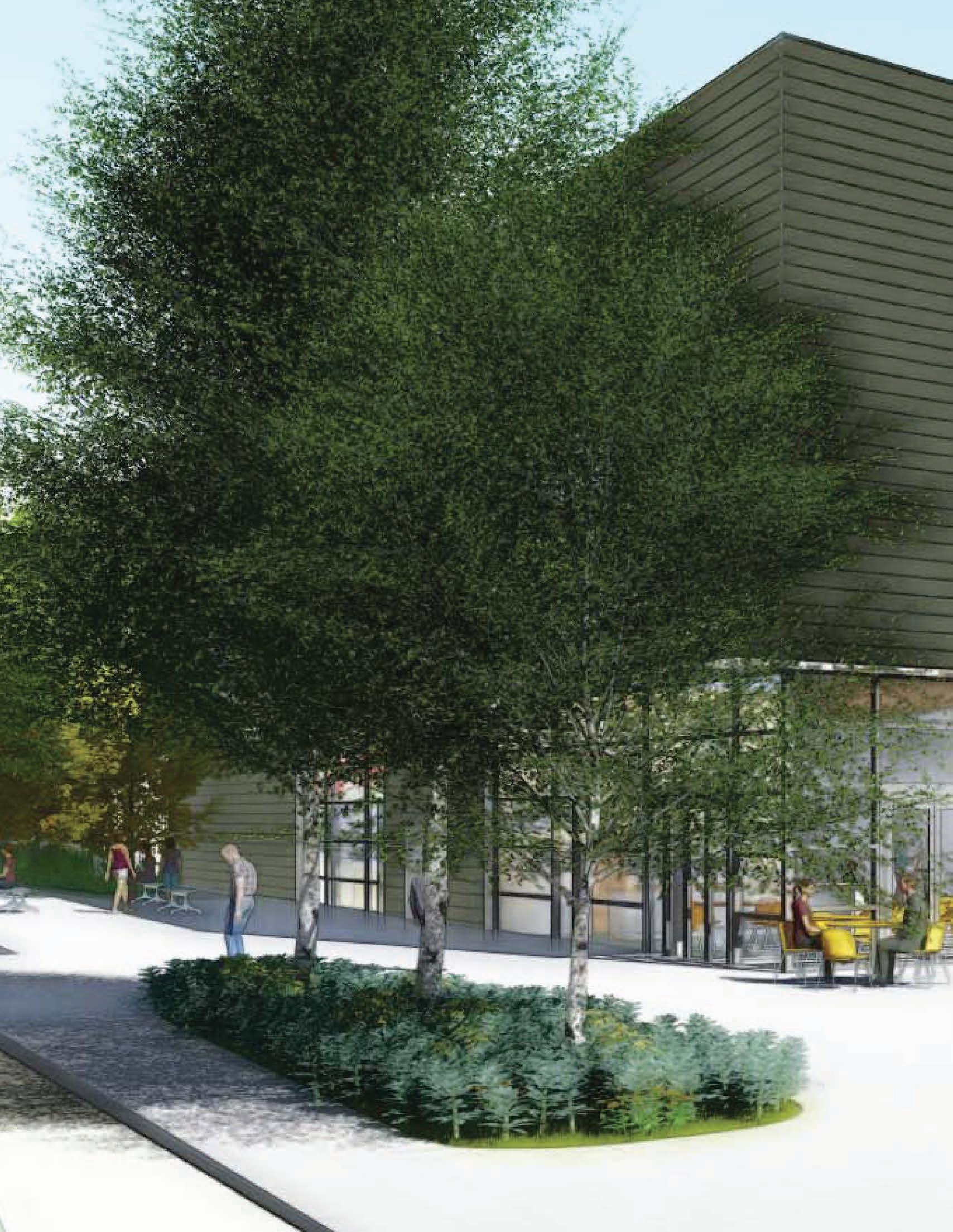
Laura Cooper and Stuart Mork
Microsoft Matching Gifts Program
Beth Alderman and Edward Boyko
Daughters of Norway, Gina Krog #38
Daughters of Norway, Sigrid
Undset Lodge #32
Jan E. Delismon
Karoline Derse
Patricia Desmond
Cathleen Dickey
Roger and Ruth Diemert
Grete Dixon
Richard and Linda Domholt
Warren Doty
John and Mary Douglas
Marcia R. Douglas
Anna Marie Drexler
Steven and Gail Dzurak
Edna Eckrem
Betty Edwards
Donna Eines
Sharene and Zac Elander
Kathryn Emmenegger
John Enge
Amy Erickson
GeorgeJean Erickson
John Erickson
Kristin Erickson
John and Katherine Evans
Thomas and Willy Evans
Family of Reidar Fammestad
Barbara and Frank Fanger
Mildred Fast
Geoff Ferguson and Joan Valaas Ferguson
Sylvia Field
Elvira and Don Fife
Finnish American Heritage Committee
Joanne Foster
Ryan Franklin
Senator Karen Fraser
Fred Fredrikson
James and Anna Freyberg
Mary O. Fricke
Sharon and Richard* Friel Frihet Lodge #401, VOA
Paul Friis-Mikkelsen and Rita
Hackett
Hansine Frostad
F/V Gene S. Inc.
James and Marilyn Giarde
Ivar Gilje
Shelby Gilje
Bonnie Good
Marjorie J. Graf
Bill Greger
Estate of Elvin B. Gustafson*
Carina Halgren
Betty and Reidar Hammer
Heidi Hansen
Rigmor Hansen
Kermit and Jane Hanson
Bill Harbert
Susan Haris
Kari Hauge Allen
Mary Margaret Haugen
Torgeir and Helen Haugland
Jim and Ann* Hayes
Alice Hedberg
John Heggem
Robert and Donna Hegstrom
Ken and Ruth Helling
Paul Heneghan
Mary Henry
Tom Herche
Inger-Marie Hermann
Jason Herrington
Val and Joe Hillers
Mary and Mark Hillman
Ruth and Gene Hockenberry
Frank Hofmeister
Charlotte Hoiosen
Rolf Hokansson
Tapio and Brend Holma
Ronda and Ray Holmdahl
Fritz Horand
Horgan Associates Inc.
Tore Hoven
Lois Huseby
Icelandic Room Committee
Gail and Roger Ide
Melanie Ito and Charles Wilkinson
Sandi and Joel Ivie
John and Justine Jacobsen
Patricia Jacobsen and Alan Gurevich
Pekka and Mari Jaske
Sally Jepson
Mary and Jim Jessen
Carl and Ellen Johanson
Richard Johnsen*
David Johnson
Jerome and Susannah Johnson
Margaret and Max Johnson
Richard Johnson
Richard and Ingri Johnson
Sigurbjorn Johnson*
James and Dianne Johnston
Paul and Lillian Johnston
Elaine Jorgensen
Ellen Juhl
Camille Kariya
Astrid Karlsen Scott
Christina and Michael Katsaros
Raisa Kaufman
Irwin and Judith Kennedy
T.J. and M.O. Kennedy
Donald Kerr
Ginny Kettunen
Doug Kilgren
Ove and Edith Kilgren*
Sam Kito
Victoria Knoll
Elise Knudsen
Laura Knudson
Jeanne Kohl-Welles and Alex Welles
Jari and Minna Koponen
Glenn and Rosemary Krantz
Ivan Kristjanson
John Kvinge*
Rolf Laderach and Minna Gronlund-Laderach
David and Marlene Lafave
Lang Manufacturing Co.
Dorothea Larsen Adaskin
Ingrid and Lennart Larsson
Kristine Leander
Helen Lee*
Bill and Jody Lemke
Kathleen Lindberg and David
Skar
Joan B. Linde
Rocky and Casey Lindell
List compiled May 2016. Every effort has been made to ensure its accuracy. Please contact Jan Woldseth Colbrese at 206.789.5707 x39 or janwc@nordicmuseum.org for corrections or additions.
Kathleen Lindlan
Brett and Jennifer Liskey
Pat Loftin
Michael and Laura Logan
Lorraine Longo and Frederic
Dahlem
Jette Lord
Richard and Carolyn Luark
Sarah and Arnold Ludvigsen
Stuart and Dorothy Lundahl
Lunde Marine Electronics, Inc.
Laura Lundgren
Edith Maines
Victor and Karen Manarolla
Pat Martin
Richard and Elizabeth Marquardt
Joseph and Charlotte Matsen
Hans and Irina Mauritzen
Paula Maxwell
Art McDonald
Norman and Constance*
McDonell
Robert S. McEwen
Gwen McGrath
Donald McLaren
Eeva and Jeffrey McFeely
Neil McReynolds
Renate McVittie
Joan Melcher
Walter Meredith
Bruce and Carol Meyers
William and Bonnie Meyers
Curtis and Mary Mikkelsen
Kaare Mikkelsen
W. C. Twig Mills and Alison Stamey
Donald and Dolores Mooney
Karoline Morrison and Dennis
Beals
Maureen Munger
Andrew L. and Doris I.* Nelson
Marvin and Sandra Nelson
Ingrid Ness
Sandra Nestorovic
Nona and Robert Nicholson
Stella Nieman
Nordiska Folkdancers
Carl J. Nordstrom III*
Elsie Norman*
Steve and Catherine Numata
Joan Oates
Ted and Jean Oien
Rick Olafson
Shawn Olsen
Shirley Olsen
Steve and Nancy Olsen
Leanne Olson and Jim Bailey
Roselyn M. Olson
Hans and Ingrid Orth
Elisabet Orville
Thomas Ousdale
Christina A. Owens
Dorothy Owens
Alene Patterson
Virginia Paulsen
Jeffrey Payne
Eric and Ingrid Pearson
Ray and Ruth Pennock
Melba Petersen*
Douglas and Sheila Peterson
Mardell and Mark Portin
Virginia Prestegaard
Puget Sound Regional Council
Matt Quint
Marie Ramstead Zobrist
Vija Rauda
Dorothy Raymond, L.T.
Raymond Family, Paul Raymond, grandchildren, and great-grandchildren of Lars Brekke
Mollie M. Reeves
Karen Regenauer
Kea Rehn and Douglas Chatfield
R. R. and Hedda Reid
Kay Reinartz and Richard Frith
Kirk Reiten
Steven Reiten
Fred and Alyne* Richard
Julia Ringrose
Roger Rippel
Ann Risvold
Robert and Carmen Robbin
Stanley and Erika A. Rogala
Mabel Rosvold
Claire Sagen
Alice Sagstad
Luis Salazar and Yolanda Leon
John Salenjus
David, Bryn, and Bridget Savage and Laurie Medill
Michael Schick and Katherine Hanson
Steve and Peggy Schmitz
Roy Schonberg
Carleen and Charles See
Roald Severtson and Liz
Gallagher Severtson
Marilyn Sheldon
Shirley Jo Hanna Sigurdson
Jonas Simundson*
C. Elmer and Patricia Skold
Ellen Grude Skugstad
Patricia and Landis Smaaladen
Rosemary Small
Barbara Snoey
Paul and Charlene Snyder
Helen Sommers
Sons of Norway, Grays Harbor Lodge #4
Sons of Norway, Poulsbo Lodge #44
Anker and Ruth Sorensen
Margie Sorlie
Henrik Sortun
Linda and Michael Sprague
Eli Stahlhut
Jim and Sonja Staley
Liv Stangeland*
Monica Stenberg
Judith Anne Stenford
Kirk Gunnar Stensvig
Virginia Stout
Joyce Strand
James and Jenny Strock
Bethany Sugawara
Vesa Suomalainen
Molly Svendsen
Robert and Mary Jo Svendsen
Carl Swenson
Carl E. Swenson* and Jean Eastman Swenson
Alice Swinland
Taku Graphics
Mary Tannehill
Norma Thomasson
Neil and Patricia Thorlakson
Heidi Thorsen and Johnny Stutsman
Robert Thorson and Leone
Murphy
Valerie Thorson
Donald and JoAnn Thuring
Lorna and Ritchie Tilson
Carl and D. Marlene Tingelstad
Daniel and Jean Tolfree
Sandra and Richard Tomlinson
Camille and Alan Torget
Louise Torseth
Joan Tracy
Candace Trautman
Christine Trigg and Doug Hauger
Anne Tstee Aronson
Sonia A. and Richard L. Turner, Jr.
Gordon Tweit
Barbro Carlson Ulbrickson
Sonja Ulvestad Coffman
United Finnish Kaleva Brothers & Sisters Lodge #11
Sylvia Vikingstad
Mark Vinsel
Malfrid Vintertun
Ed and Joyce Waight
Marlys S. Waller
James Warren and Wendy Hutchins Cook
Don K.* and Evelyn K. Weaver
Margit Weingarten*
Ross and Nancy Weinstein
Penny S. Welsh
Norm Werner
West Coast Finnish American Singers Association
Norman* and Benita
Westerberg
Richard and Judith White
James Whiteley
Randal and Kristi Wiant
Dorothy Wicklund
Laurie and George Williams
Lorrin Williams and Lisa Lindstrom
Lynn and Sonny Wirta
Archer Wirth
Elsa Wise
Richard T. Wise
Connie and Roger Wolter
Rosemary Wood
Sonnera Joyce and Edward Wood
Larry T. Yok
Vivian Zagelow
Frank and Shirley Zahner
Sharon Zerr-Peltner
Murlyn Zeske
Anonymous (12)
*Deceased
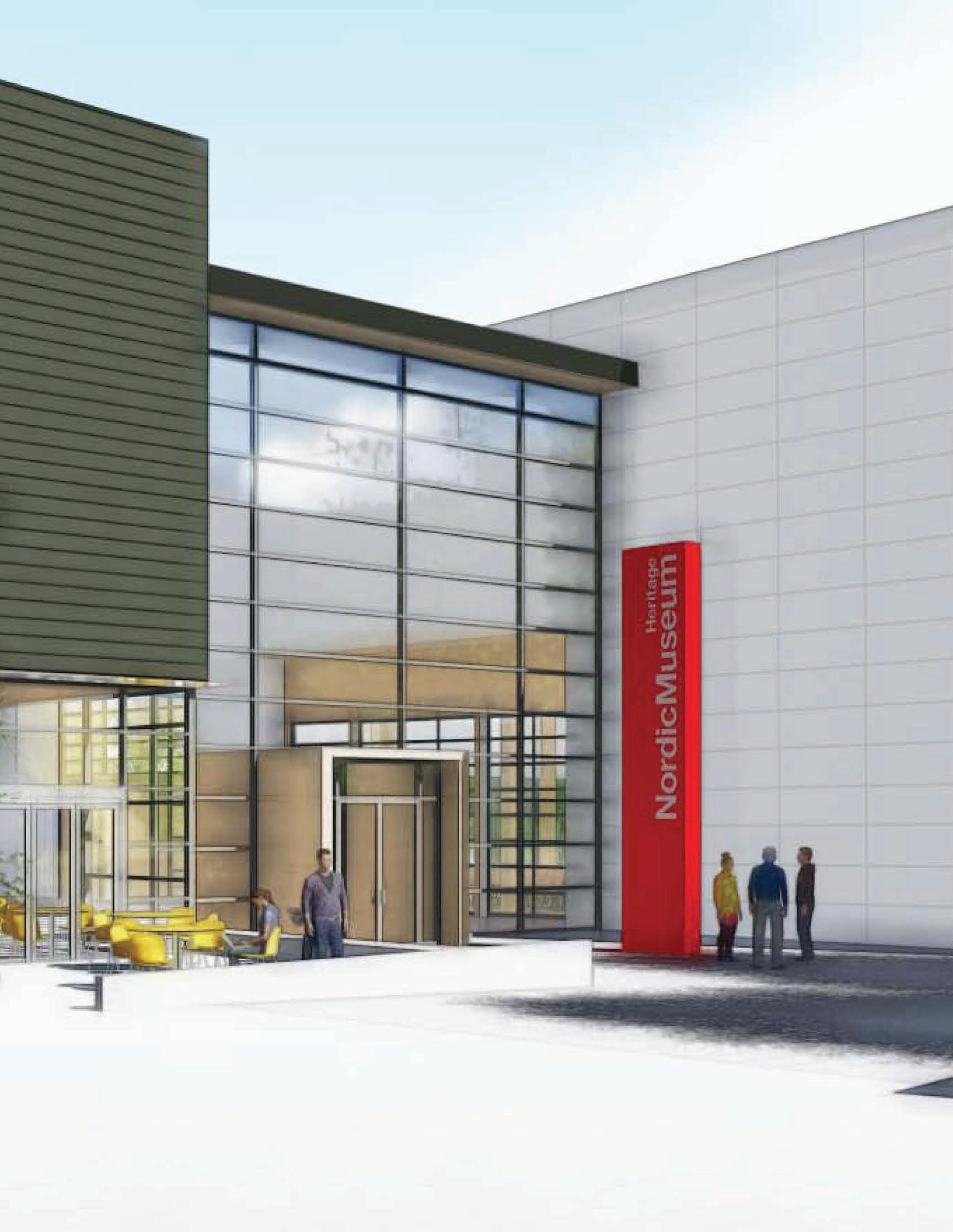
Contributed by Kirstine Bendix Knudsen
NORDIC HERITAGE MUSEUM, with generous financial support from the Nordic Council of Ministers, had the opportunity to invite forty-five academics, scholars, and museum professionals, from the Nordic countries and from North America, to advise the Museum on the development of the new core exhibition for the future museum. The Nordic Council of Ministers has developed a new strategy for branding the Nordic countries as an aligned unit that supports Nordic Heritage Museum’s vision.
The core of this new approach is described in the opening of the Nordic Council of Ministers Branding Strategy: The Nordic region is appealing. For some time, characteristically Nordic cuisine, design, films, music, and literature have been bringing the Nordic region international recognition. The successes, which come from all the Nordic countries, often share a distinctly Nordic element— a Nordic trademark.
However, the Nordic region first started to distinguish itself internationally in the aftermath of the financial crisis [2008–09]. The Nordic governance and welfare model once again showed it was capable of renewing itself. Countries all over the world began to discuss whether the Nordic model could serve as a possible buffering and stabilizing factor in an increasingly uncertain global economy. The Nordic region is also facing a number of serious challenges and is far from perfect, and it is perhaps this imperfection that makes the region fascinating.
At the same time, the Nordic countries are always at the top of international rankings regarding openness, trust, equality, environment, and happiness. These are the values the Nordic Council of Ministers wants to share with the rest of the world in their strategy for international branding 2015–2018. The objective is not to convey a homogeneous picture of the countries in the Nordic region, nor to give an impression that all Nordic citizens, organizations, and governments think and behave in the same way. Instead of emphasizing the distinctive features of each country, the strategy is to promote what they have in common: the
Nordic perspective, the values, and a culture that has grown out of a common history.1
As a part of their strategy, the Nordic Council of Ministers has hosted a number of events in the US, including the successful Nordic Cool Festival in Washington, D.C. in 2013. From 2016 on, they expect Nordic cooperation to be present on a larger scale in the US with events focusing on climate, culture, and much more.
Nordic Heritage Museum is the only museum in North America that represents the entire Nordic region: Denmark, Finland, Iceland, Norway, and Sweden, as well as the Faroe Islands, Greenland, and Åland. The Museum and the Nordic Council of Ministers both share a similar mission: to brand and promote the Nordic Region for an international audience.
In the spring of 2015, Nordic Heritage Museum invited the Nordic Council of Ministers to become a partner and
Openness and a belief in everyone’s right to express their opinions
Compassion, tolerance, and conviction about the equal value of all people
Trust in each other and also, because of proximity to power, trust in leaders in society
New ways of thinking, focusing on creativity and innovations
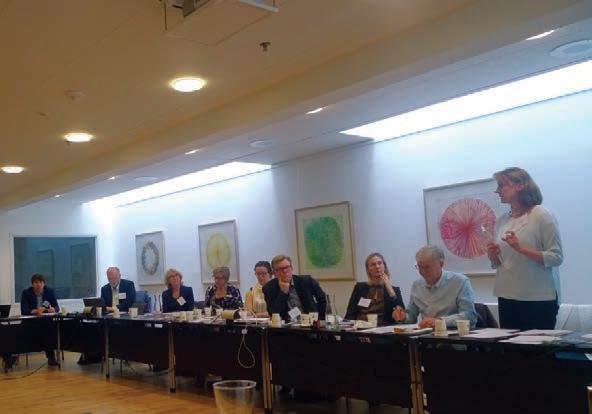
Sustainable management of the environment and development of natural resources
collaborator in the critical development process for the new Nordic Heritage Museum. It was not only about strengthening the new Nordic Museum’s profile, but also to provide a North American platform for the Nordic Council of Ministers on which to expand, promote, and realize its vision for the Nordic countries. The goals of the project are:
To define the new Nordic Heritage Museum’s core storyline in close collaboration with experts who possess specialized knowledge of Nordic history, culture, and values.
To create partnerships with museums and cultural institutions in the Nordic Region in order to promote the exchange of ideas and artifacts.
To form an alliance with the Nordic Council of Ministers to support the establishment of the new Nordic Museum and contribute to the dual vision of expanding knowledge of the Nordic countries and communicating Nordic values in an American context.
To create an authentic and current Nordic platform in Seattle that will continuously attract cultural stakeholders from the Nordic countries and serve as a showcase for Nordic culture and the promotion of that brand.
A grant from the Nordic Council of Ministers’ program, “Neighbors to the West,” made it possible for the Museum to gather forty-five stakeholders from the Nordic Region and North America in, respectively, Copenhagen and Seattle, for two symposiums. Both meetings were very fruitful. The Museum received valuable feedback from the group and the Nordic Council of Ministers found the project successful: “We are happy to know that our support has given Nordic Heritage Museum an opportunity to work with the storyline for the new museum on a genuine Nordic basis and with support from competent people and professionals from the Nordic countries,” said Dagfinn Høybråten, Secretary General, Nordic Council of Ministers.
THE NORDIC COUNCIL OF MINISTERS is the official intergovernmental body for cooperation in the Nordic Region. There are ten thematic minister councils and an overarching minister council, the Nordic Cooperation Ministers, that coordinate the overall cooperation. The Nordic governments meet at the minister councils to develop and implement policies and strategies, draft Nordic conventions, and much more. In 2014, the Nordic Cooperation Ministers decided on a vision to strengthen the trust-based cooperation by addressing solutions for the challenges and dilemmas within globalization, resource consumption, economic crisis, and climate change through regional and international cooperation.
The Nordic Council of Ministers is a central platform for cultural cooperation. The activities of the Council in the field of culture have positive effects in other areas of Nordic cooperation, both in and outside the Nordic region. norden.org
1Foreword to Strategy for International Branding of the Nordic Region, 2015–2018. Nordic Council of Ministers, 2015.
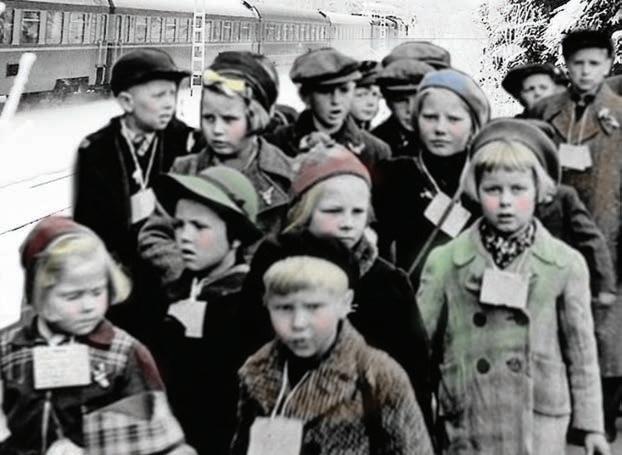
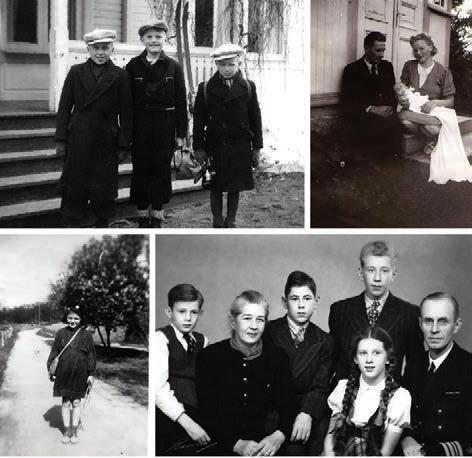
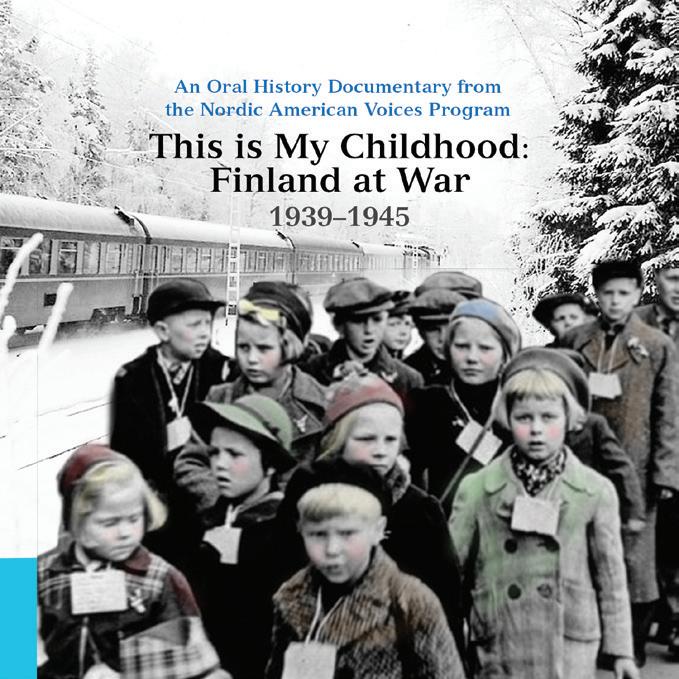
A film documentary based upon oral history interviews conducted by the Nordic American Voices program
A limited numbers of copies are available in the Museum Store.
Featuring Norway’s Arne & Carlos
Nancy Bush
Evelyn Clark
Susanna Hansson
Judith MacKenzie
Laura Ricketts
Susan Strawn
Susan Azadi
OCTOBER 8–10 IN SEATTLE
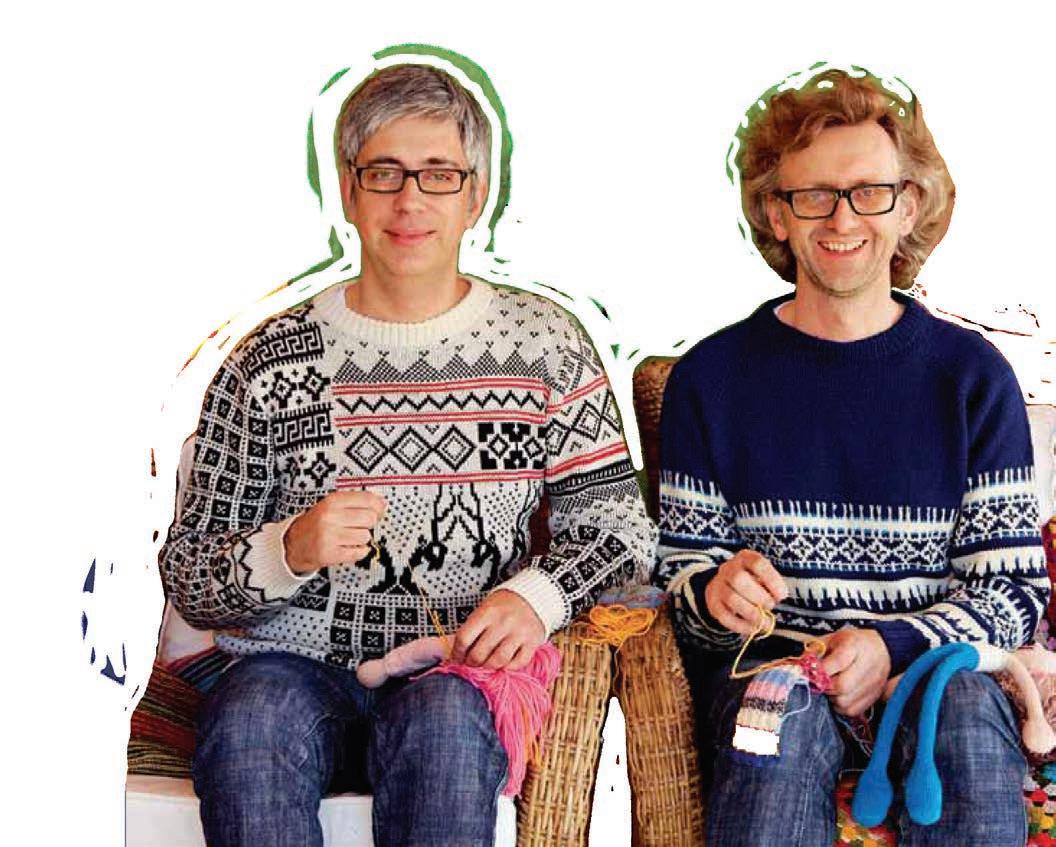
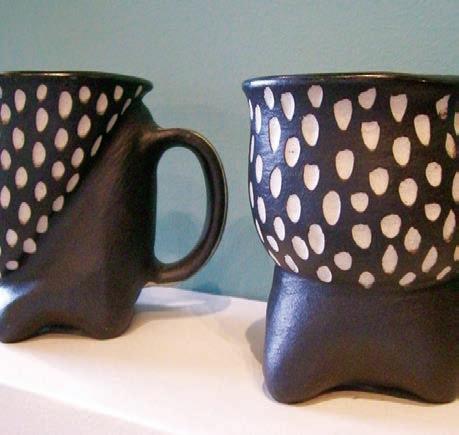
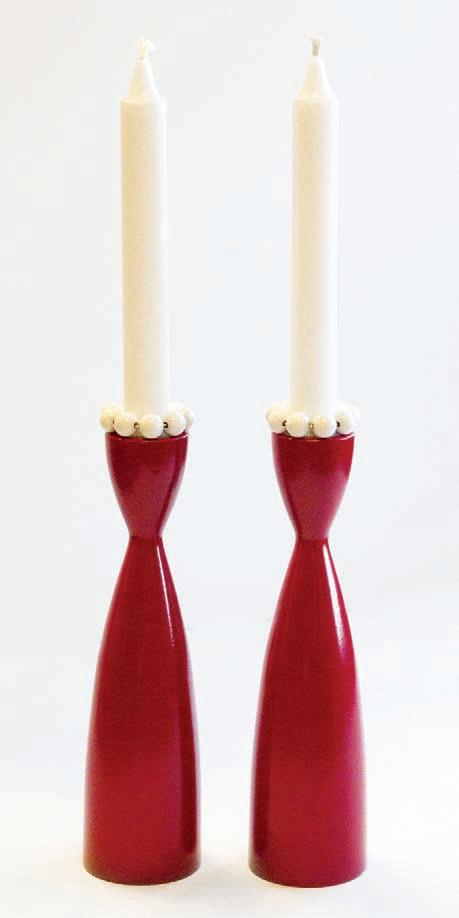
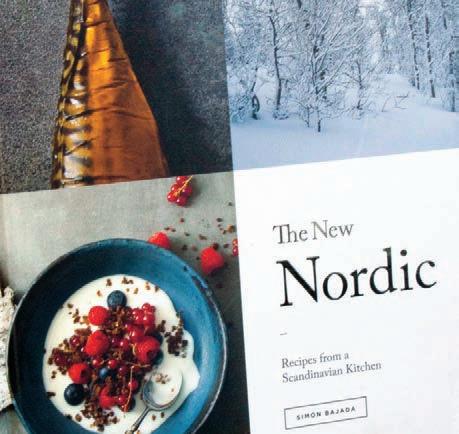
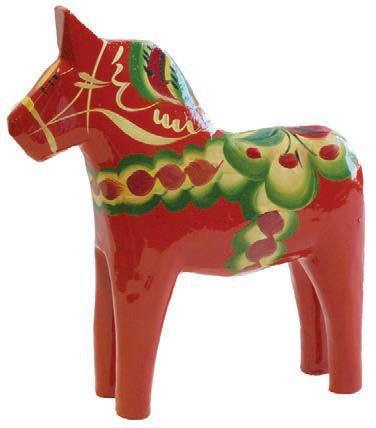
If you’re looking for something uniquely Nordic, stop in the Museum Store on your next visit!
Members enjoy a 10% discount on all purchases and 20% off twice a year during Member Appreciation Weeks.
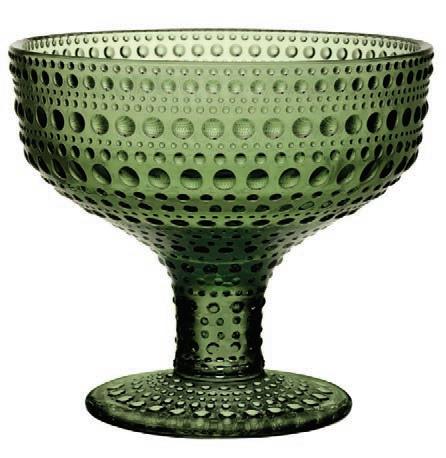
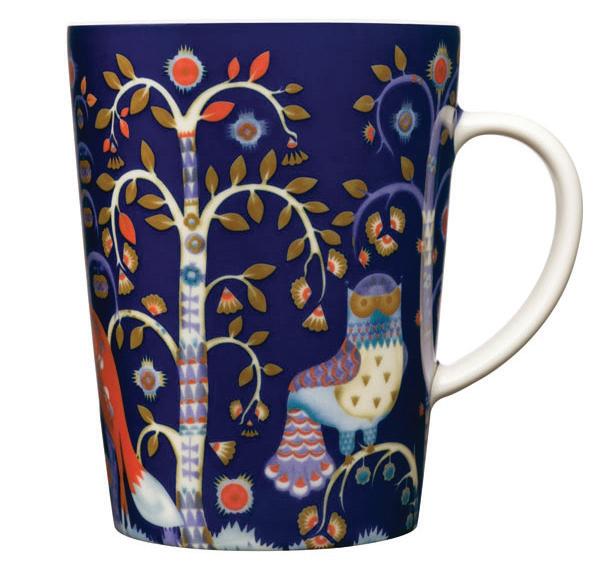
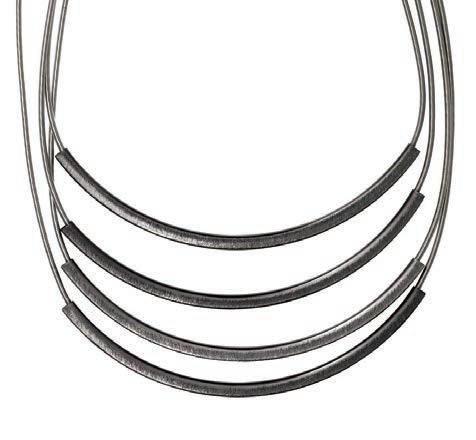
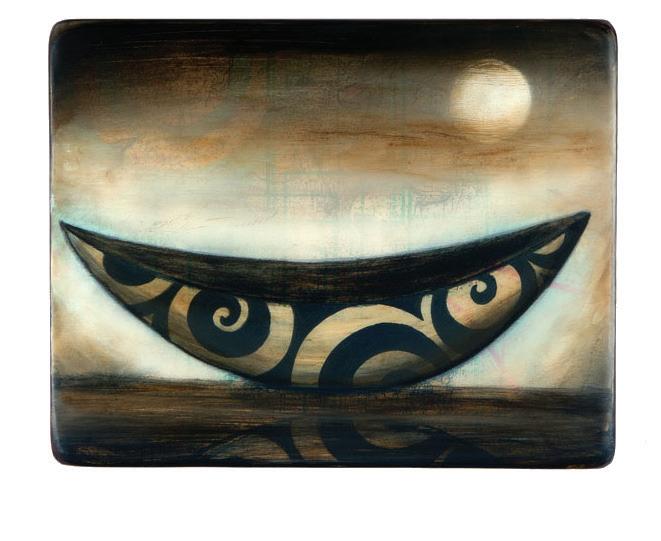
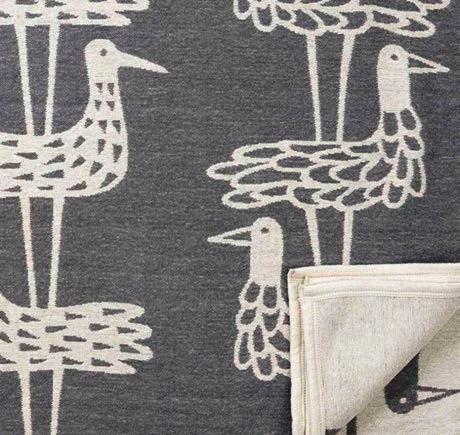
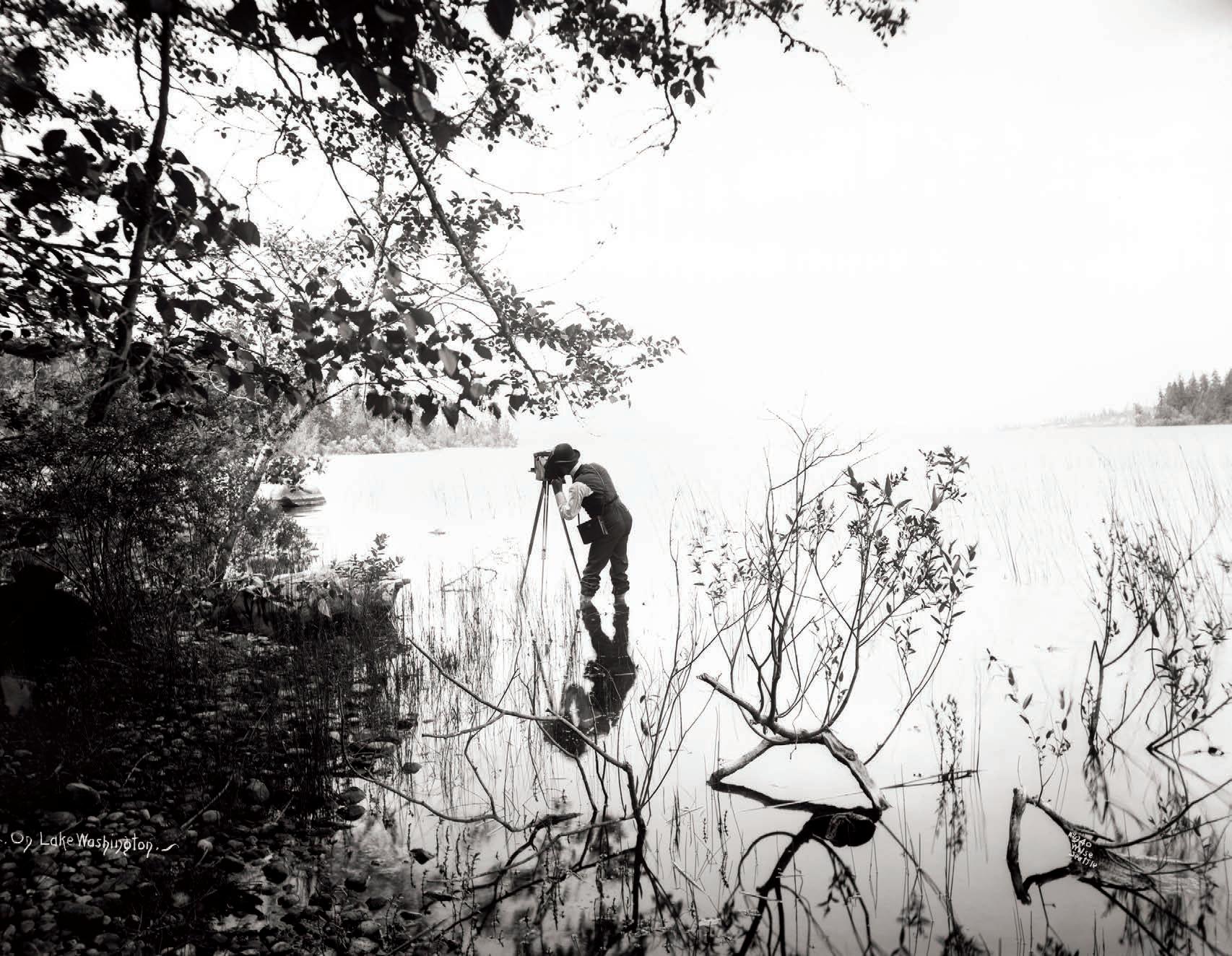
ANDERS BEER WILSE (1865–1949) came to America from Norway as a young man, first to Minnesota in 1884 via New York, and then later to Seattle in 1890. Arriving in Washington State, Wilse, who had trained as an engineer, was employed by the Great Northern Railway for two years, building the railroad across Stevens Pass in the
Cascade Mountains. His early photographs from this time document life in the railroad workers’ town, before and after the railway was completed. There are images taken from afar showing workers shoveling snow or laying line on timbered platforms high above the snow pack, as well as more intimate images of daily life, such as workers getting
haircuts. Wilse was an outdoorsman through and through: a primitive hut of slat boards served as his first darkroom during his time in the Cascades. Subsequent travels around the state took him from Spokane to the Olympic coast, north to Kootenay Lake in British Columbia, and to Paradise Valley at the foot of Mount Rainier.
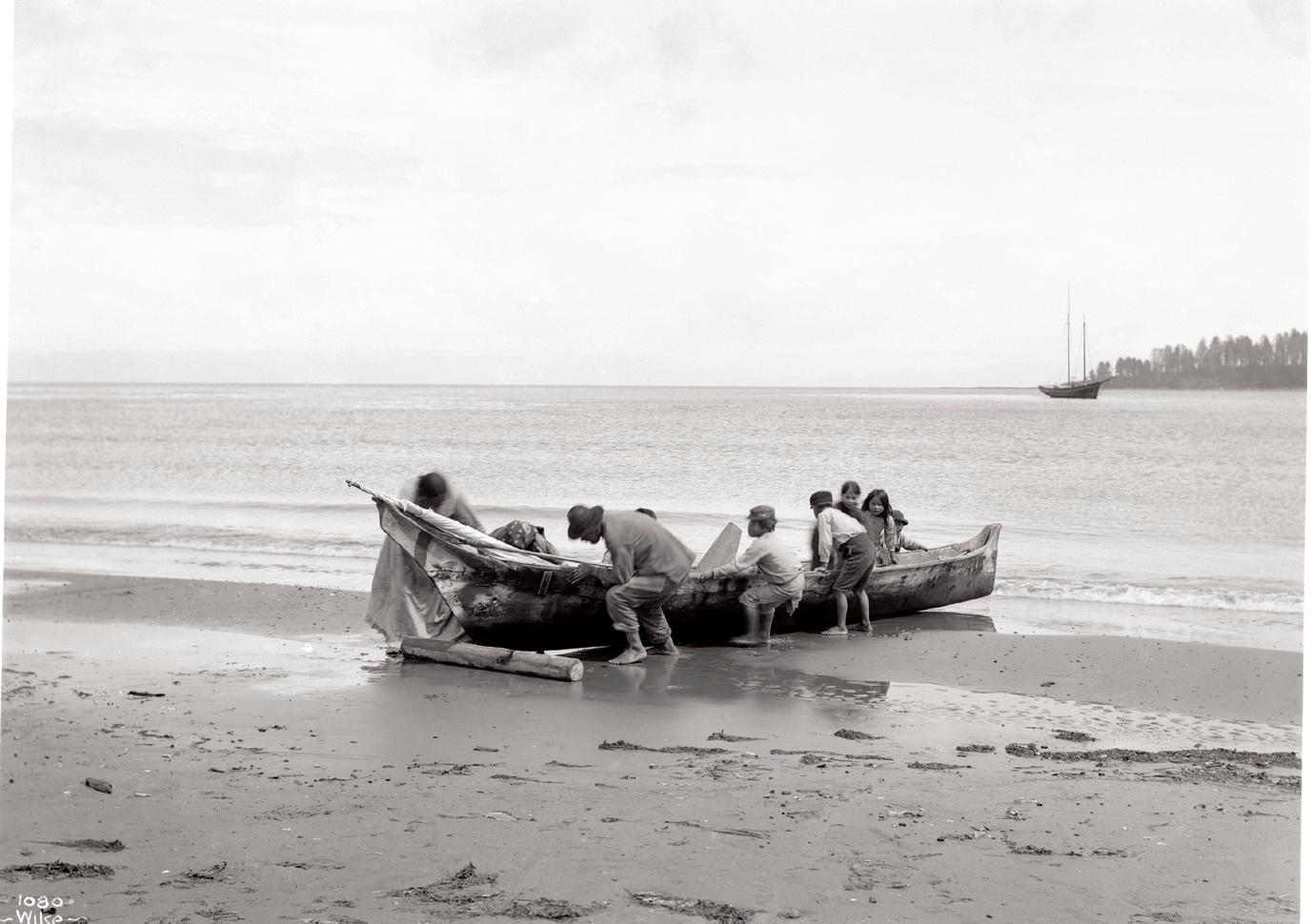
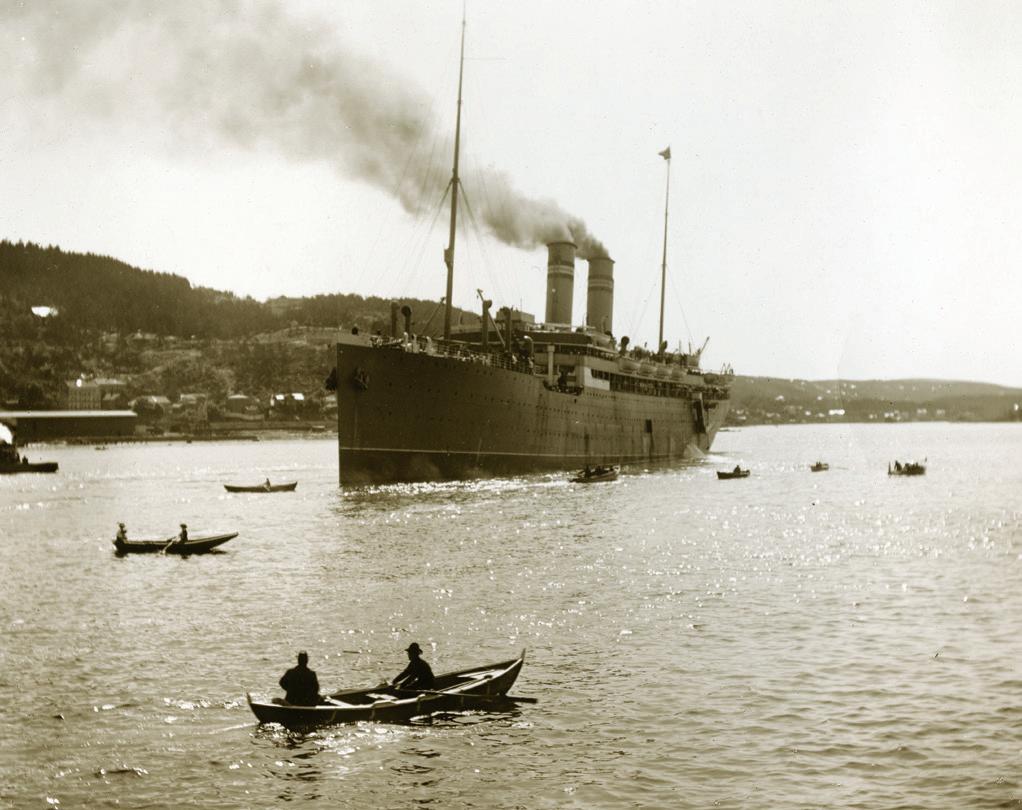
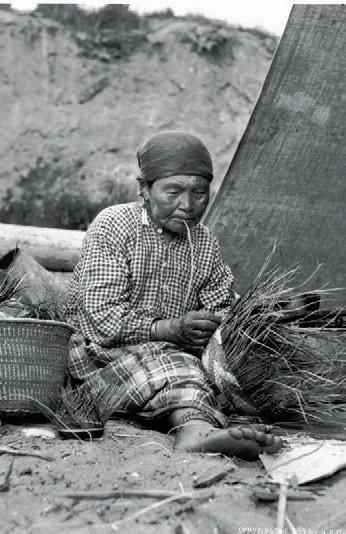
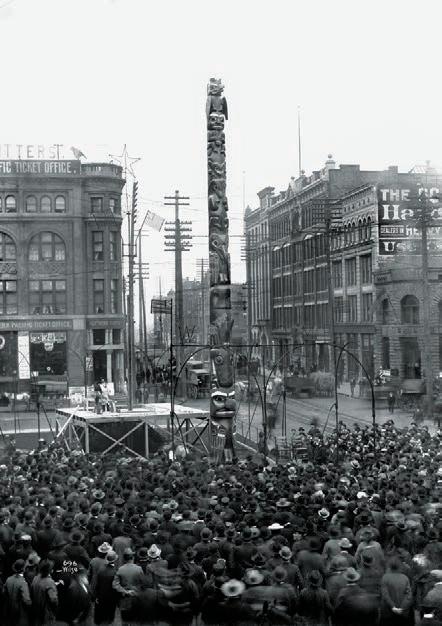
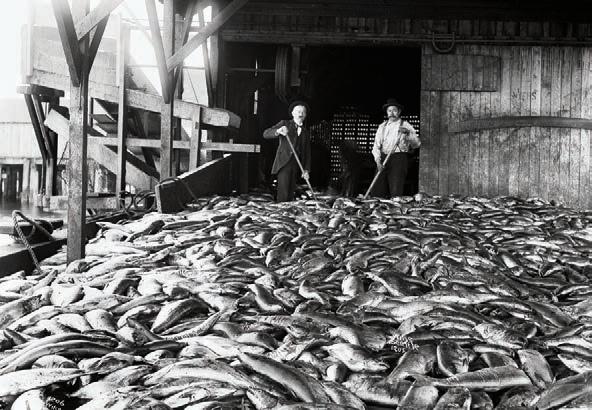
Wilse’s engagement with photography as a profession had a profound shift in focus when, in 1897, he joined travel photographer David Kirk as a business partner in a new photography studio in Seattle. Wilse referred to this as his “do or die” moment in choosing photography as his lifelong pursuit.1 The partnership with Kirk was short-lived—only six
months—and was already over when Wilse left Seattle on a three-month excursion to photograph the landscapes of Montana and Idaho. However, the commercial success of his photographs convinced Wilse to remain in Seattle and to continue documenting subjects such as hotel interiors, the logging industry, Native American encampments, the
Alaskan Gold Rush, and, in 1898, a contingent of visiting Sámi reindeer herders in Seattle’s Woodland Park.
In October 1900, only three years after starting his Seattle studio, Wilse returned to his native Norway, where, on May 1, 1901, he opened a photography studio in Nere Slottsgate in Kristiania.2
Contributed by Fred Poyner IV
Wilse’s 1898 photographs of the Sámi provide an important visual record of Nordic labor of the period. Together with Kirk, Wilse took at least eleven photographs showing a mixed Sámi, Finnish, and Norwegian group of men in March at Woodland Park. The men had been hired by the U.S. Government to escort a shipment of 537 reindeer that arrived in Jersey City on the steamer Manitoban that February, and to shepherd the herd safely to the West Coast, before the animals were to travel north to the Klondike region of Alaska.3
The Seattle herd of 1898 was but one such importation of reindeer for the Northern Territories. There are different versions of why reindeer herds were secured by the U.S. Government for Alaska. In one version, taken from a history of North Kitsap, Washington, the group escorting the Seattle herd was called both “Lapps” and a Norwegian variant, “Samer” (pronounced Sah-mur). The rationale cited was the need to provide reindeer meat to starving “Eskimos” (Inupiaq) located off the Arctic coast of Alaska. Another account, dating from 1906, based the reason for the Seattle reindeer herd on a story that had circulated out of the Yukon in 1897. In this version, American miners “were starving,” and Dr. Sheldon Jackson had persuaded the War Department to release funds for the purchase of the herd from “Lapland.”4 Jackson, who was General Agent of Education in the Alaska Territory, was instrumental in efforts, dating back to as early as 1890, to secure imports of reindeer for native Inupiaq in the Arctic. The intention was to train the Inupiaq as herders and was also part of a broader missionary-led effort to convert them to Christianity.
A third account, published by the Seattle Daily Times the same month the reindeer herd occupied Seattle’s Woodland Park, offered the most insight into the ultimate fate of the herd and the destination of its Nordic handlers:
Although the purpose for which these reindeer were purchased, i.e. the Government relief Klondike expedition, has been abandoned by Secretary Alger, the ultimate destination for the herd is Alaska just the same. The program now is to divide the herd into two parts…the greater number, 337, will leave here for Pyramid Harbor…under the charge of the reindeer expert, W.A. Kjellman [sic]. The remaining 200 reindeer will be sent to Prince William Sound with about fifty herders, under command of Capt. Abercrombie.5
In reviewing the history of the Sámi in Woodland Park, we can look to the photographic record established by Wilse to provide excellent details about the people described in newspaper articles. The aforementioned Mr. Kjellman is shown in Wilse photograph #563, holding the tether to a young, dehorned reindeer calf. He wears a knee-length overcoat, button-down wool jacket, and a square-shaped hat. His personage appears to be one of seriousness, with his gaze focused on something off to the right, and out of view. (The reindeer also looks in this direction.) In the background are a number of young evergreen trees, perhaps recent plantings in the park.
Was Kjellman one of the Sámi, or was he counted among the Finnish or Norwegian members of the Seattle group of herders? He is dressed entirely differently from those individuals seen in other Wilse photographs who can be identified as Sámi by name. This suggests that
Kjellman belonged to either the Norwegian or Finnish contingent of the group of herders. There is a record of Kjellman’s being hired by Dr. Sheldon Jackson in 1893 to be Superintendent of the Teller Reindeer Station in Alaska. In this record, he is identified as a Norwegian from Madison, Wisconsin, who grew up working with reindeer in “Finmark” and is fluent in the Sámi language.6
Wilse’s photograph of Kjellman not only found application in 1898 as a newspaper illustration for the Seattle Daily Times but also serves as a visual commentary in today’s archival record. Digitized copies of the very same photograph have been saved in the University of Washington’s Special Collections and Nordic Heritage Museum’s photograph archive. Moreover, Wilse’s photograph series of the Seattle reindeer herd in Woodland Park offers additional examples of known Sámi individuals and groups. A collection of these will be included in the upcoming exhibition People, Places, Changing Lands: The Photography of Anders Beer Wilse, hosted by Nordic Heritage Museum in December 2016.
1 Anders Beer Wilse, En Emigrants Ungdomserindringer, vol. I, 1936: 50.
2 Ibid, p.121; Roger Erlandsen, Pas paa! Nu tar jeg fra Hullet! Om fotografiens første hundre år I Norge – 1839–1940, 2000: 231.
3 Osborn Spencer, “Ten Thousand Tame Reindeer in Alaska,” Seattle Daily Times, 5 August 1906: 3.
4 “Loaned Deer to Missionaries,” Seattle Daily Times, 2 April 1906: 5.
5 “The Herd of Reindeer,” Seattle Daily Times, 10 March 1898: 5.
6 “Alaska Chronology — 1893,” Báiki: The International Sami Journal, 2001–2015, URL: http:// www.baiki.org/content/alaskachron/1890.htm [accessed: February 25, 2016].
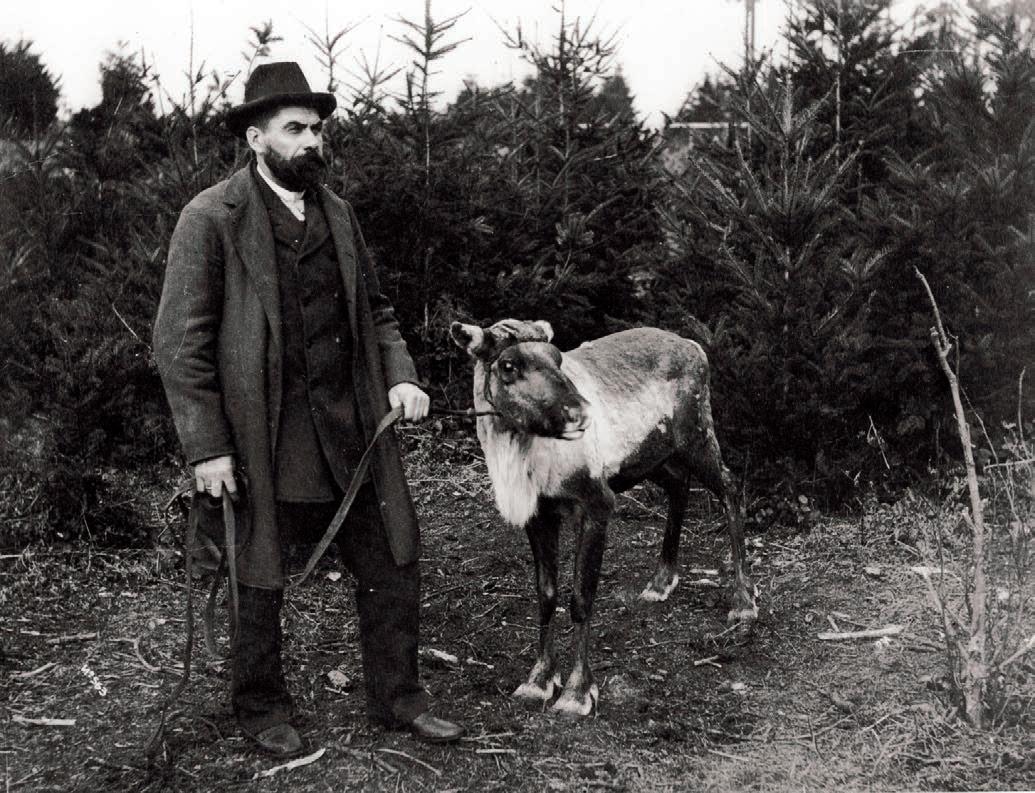
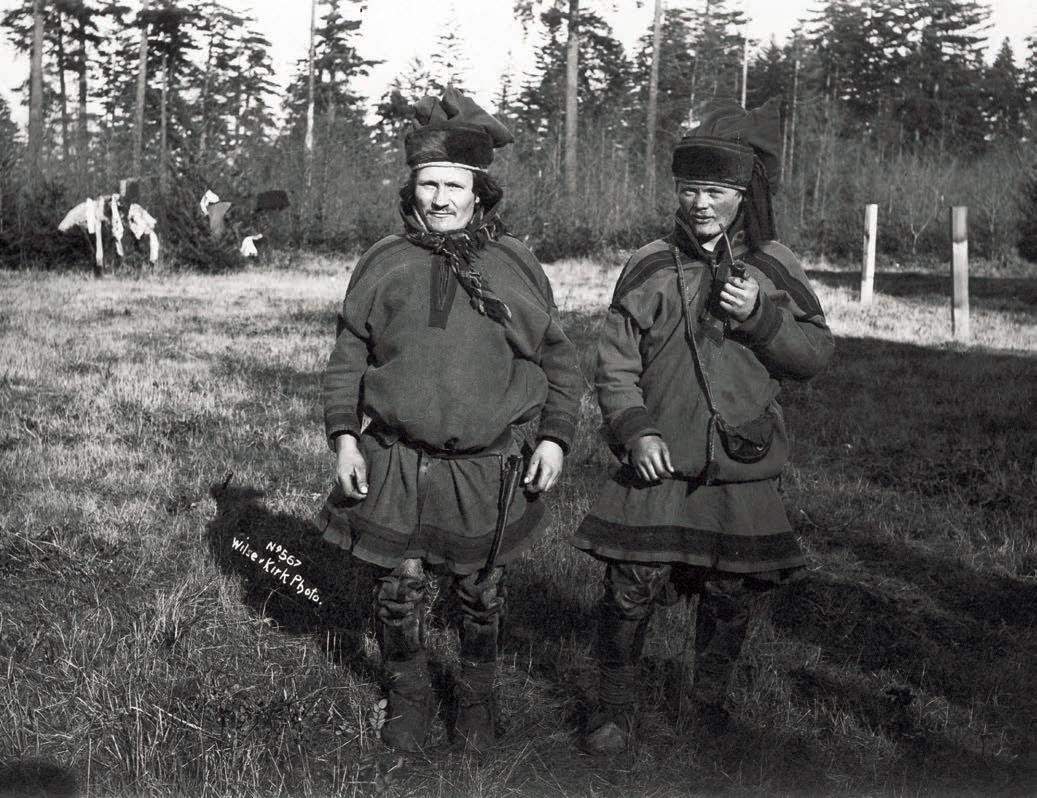
Adapted from the exhibition at the Museum of Danish America
In the early morning of April 9, 1940, German military forces invaded Denmark—a step in Adolf Hitler’s quest to conquer the whole of Europe.
The Danish government and King Christian X knew that fighting Germany was unrealistic: the German army was much stronger and any conflict with them would mean a needless loss of life. So, after a brief battle of a few hours, Denmark surrendered to the aggressor.
An “act of protection” was what the German government called their occupation of Denmark. They saw the Danes as belonging, like themselves, to the Aryan race—the supreme master race that formed the basis of Germany’s Nazi ideology. Because of this, Denmark was allowed keep its own government and authority, and King Christian X could continue to reign as a symbol of national independence. Denmark was permitted a favored-nation status with Germany and, in return, the Danes agreed to export food and industrial goods to Germany.
At this time almost 8,000 Jews lived in Denmark. The Germans were being exceptionally cruel to Jews in other
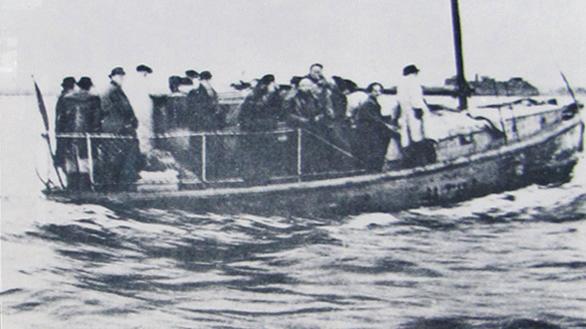
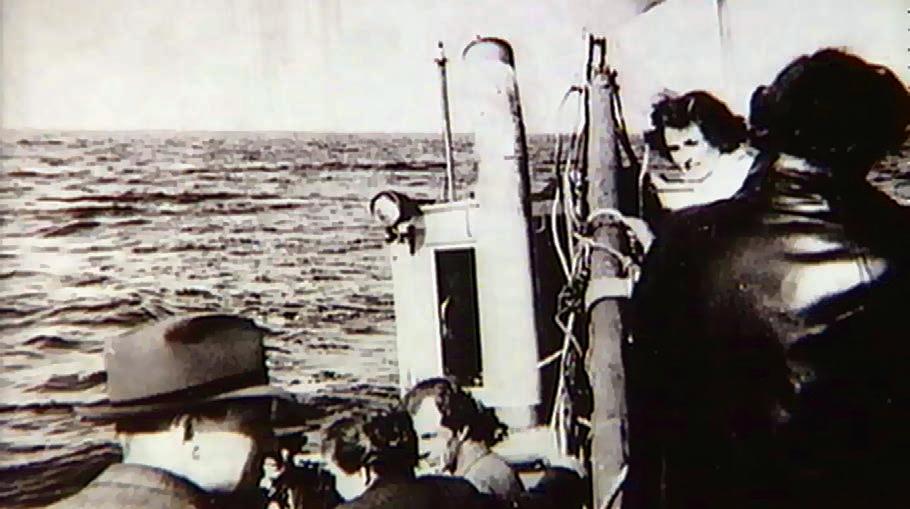
countries, following Adolf Hitler’s “Final Solution.” But at first, a blind eye was turned toward the Danish Jews. This was in part due to Werner Best, who had been appointed the German Reich’s Commissioner for Denmark. Best knew of Hitler’s plan to exterminate Europe’s Jewish population. He also knew that any attack against Jewish Danes would be seen as an attack against all Danes. To keep the peace, Best reported to Hitler that there was “no Jewish problem” in Denmark.
However, the situation was to change radically in mid-1943 after the Germans suffered major defeats in North Africa and the Soviet Union (Russia) at the hands of the Allies. These victories inspired greater resistance by the Danes toward their German occupiers.
For the previous three years, the Danes had passively resisted the Germans. Now, there were food shortages and other deprivations, and feelings of oppression and hatred toward the Germans grew stronger. Civil unrest soared. The Danish
Resistance Movement led nationwide strikes. Conflict between the Danes and the Germans escalated.
In August 1943, the Danish government refused to accede to new demands from its aggressor. As a consequence, the government of Denmark was dissolved and martial law was instituted by Germany. Now the Jews of Denmark no longer had their government to protect them from the Germans. In fact, the Germans already had a plan for the Jews: they would seize all Danish Jews overnight—between October 1 and 2—and would remove them to Germany in two large boats and a bus. The dates chosen coincided with Rosh Hashanah, one of the holiest times of the Jewish year.
Werner Best told his confidant, German diplomat Georg F. Duckwitz, of the plan to deport the 8,000 Jews. At great risk, Duckwitz traveled to Germany to try to stop the deportation. When that failed, he traveled to Sweden to find refuge for the Danish Jews. Then Duckwitz leaked the information about the
“Something unusual happened to Eichmann and his men: the Jews slipped from their very grasp and disappeared, so to speak, behind a living wall raised by the Danish people in the space of one night.” —Museum of Danish America
pending round-up to Jewish leaders and to Danish Resistance members. He also told them of the sanctuary Danish Jews could find in Sweden. The news spread with lightning speed across the country.
Rabbi Marcus Melchior was among those who learned of the deportation plan. At early morning services, on September 29, the day prior to Rosh Hashanah, Rabbi Melchoir told the 150 Jews in his congregation that the Nazis would invade their homes, seize them, and send them to concentration camps. He warned everybody not to return home, to spread the word, and to go into hiding immediately.
The threat to the Danish Jews was a direct attack on the whole Danish population. It ignited the most impressive and complete rescue mission of World War II.
The citizens of Denmark would not stand for the inhuman round-up of Danish Jews. People from every walk of life came to the Jews’ defense. Ordinary citizens offered hiding places in their homes and on their property. Churches and hospitals became safe havens. Complete strangers offered help to anyone who appeared Jewish or had a Jewish sounding last name. Police officers refused to join in the manhunt.
Most of the Jews looked for safety with Gentile friends or supporters. They also went into hiding in the countryside or
in harbors on the coastline. Because of this unprecedented joint effort, the Nazis found very few Jews when they arrived the next night. Less than 500 individuals, just seven percent of the Danish Jews, were arrested. Most of them were too old, too sick, or unable to flee. A few in hiding were disclosed by Nazi informants. Those arrested were deported to Theresienstadt, the concentration camp in occupied Czechoslovakia. Theresienstadt was not an extermination camp: the Danish Red Cross was permitted to monitor the care of Danish citizens at the camp. Only fiftytwo Danish Jews died at Theresienstadt, because of disease or deprivation.
In the course of just a few weeks, the remaining Jews—close to 7,500 people— were secretly evacuated from Denmark and shuttled across the Oresund to Sweden at night, by any vessel available. The 10-mile journey across the waters of the Sound was cold and rough. There was no question, though, that this was a better option than Nazi concentration camps.
More than 800 trips were made across the Sound. Danish Jews disembarked at their destination to be greeted by Swedes who were awaiting their arrival. Some large ferries carried dozens of refugees at a time. Other refugees found passage in the hulls and storage areas of cramped and smelly fishing boats, or in rowboats or kayaks, where only a few people could be stowed safely.
After Germany’s surrender in 1945, the Danish Jews came back from Sweden. Many found their homes and possessions untouched. They had been protected by their Danish neighbors until their return.
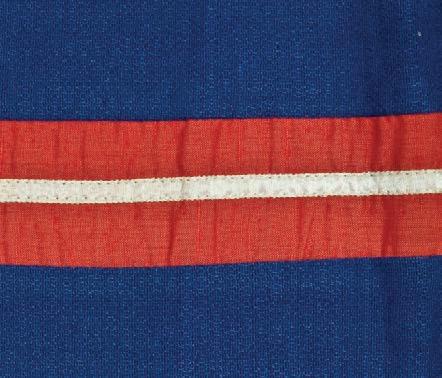
Copenhagen professor Dr. Erik Husfeldt was a renowned surgeon and respected member of the community. He was also a strident oppositionist to the occupying Nazi regime. A leader of the Danish Resistance, his family lived out World War II in hiding, while they aided Danish Jews fleeing Nazi persecution. As the defeated German army marched out of Copenhagen, Husfeldt and his fellow compatriots in defiance wore blue, white, and red armbands—the symbol of the Danish Resistance. This is the armband that Husfeldt proudly wore that very day (above).
Dr. Husfeldt was awarded the American Medal of Freedom with two Bronze Palms by General Eisenhower. He was also one of the signees on the Charter for the United Nations in 1945.
Facing page: Passengers aboard a Danish transport ship, ca. 1943. Museum of Danish America
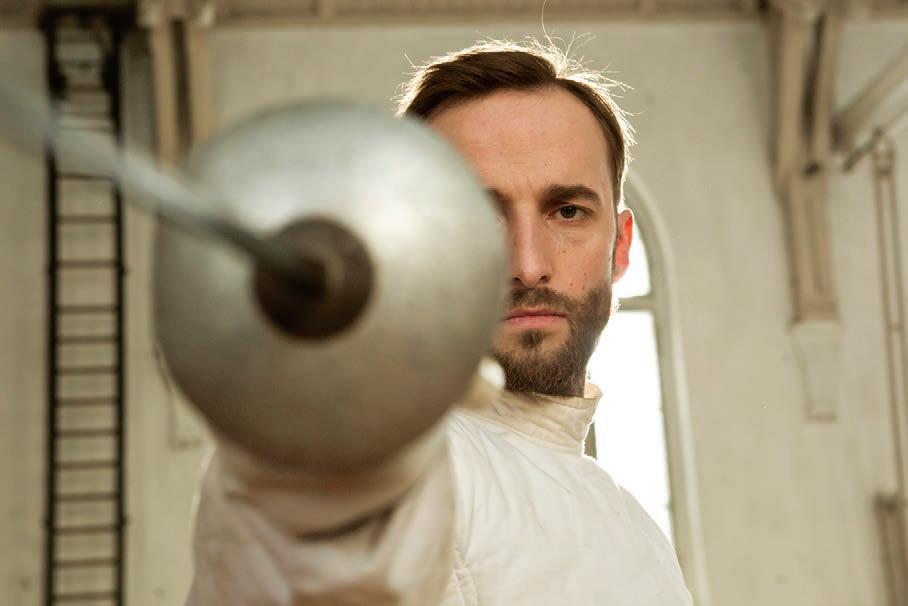
The Fencer storyline: In the mid-1950s, Endel Nelis arrives in Estonia, having left Leningrad to escape the secret police. He finds work as a physical education teacher and becomes a father figure to his students, as many are orphaned because of the Russian occupation. He teaches them his passion—fencing, and the sport becomes a form of self-expression for the children. The children want to participate in a fencing tournament in Leningrad. Endel must make a choice: risk everything to take his students to Leningrad or put his safety first, and disappoint them.
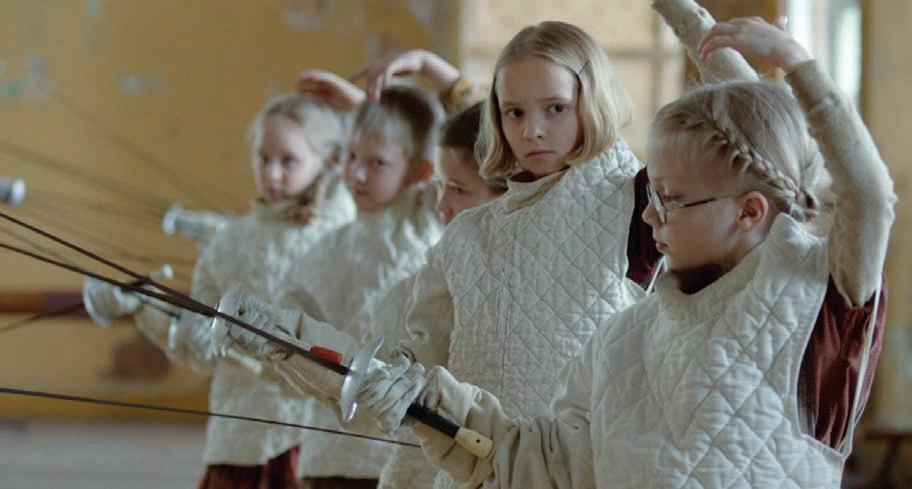
The Fencer (2015), a film by Klaus Härö, was shown at the 2016 Nordic Lights Film Festival at the Seattle International Film Festival (SIFF). The first-ever Finnish film nominated for a Golden Globe, it was shortlisted for an Oscar in 2016
Härö was interviewed by Nordic Heritage Museum Public Programs Coordinator, Stina Cowan, and Program Manager, Jonathan Sajda.
SC: The Fencer is beautiful! What about Endel Nelis made you want to tell his story?
KH: Actually Anna Heinämaa’s original screenplay attracted me. I had not heard about Endel Nelis, and I made a decision not to find out, either. What I needed to find out were the circumstances of the Estonians during the 1950s Stalin era. I tried to do that research very, very carefully. If I had started to research his life [beforehand] I would have been totally distracted. I’ve been there before: you have a historical subject, and find yourself drowning in all these wonderful stories and interesting facts. You just can’t get them all into an hour and a half or two hours. If I can find a way to capture something of the human condition, which is universal, and about the spirit of the time, then the audience will feel satisfied.
I wanted to go at it through the writer’s central idea—the story of a man in hiding. He has a need for communion with other people, but is forced to be a
loner. This story was very attractive—he finds his life again, finds his way back through the children. I thought that was just a beautiful, beautiful thing.
SC: You directed in Estonian and Russian—two languages you don’t speak? How did that work?
KH: Film is not about dialogue. Movies are about telling stories in pictures. You put one picture to the next, and you add music, you have the audience right there. Everybody is saying, “Oh, I know what’s going on. I know what’s going to happen.” You need a certain amount of dialogue to reveal things, but really what I strive to do is tell the story in a cinematic way. When I read any screenplay, there are two things I’m looking for. One is content: is this something that I really will be interested in a year from now, three years from now? And the other thing, obviously, is a story told in visuals. It doesn’t mean it has to be a very flashy thing. It can be a low-key, intimate thing as well. I felt that this was a story about bringing hope where there is none. And the idea of bringing this beautiful, classical, almost dance-like sport into a world of gloominess…it was an idea to bring beauty into ugliness.
SC: In many of your movies you have child actors, and especially so in The Fencer. How do you work with children to make them such great natural actors?
KH: It is hard work in one respect. Shooting a movie, we might do the last scene first and the first scene last. With children, I need to keep track of what should happen emotionally in every scene. I don’t have to with adult actors. We had to go to schools, sports events, clubs, and look for the kids, and talk to their parents, and ask if they would let them come to a casting. It was a huge undertaking.
JS: We read that The Fencer was the hardest film that you’ve ever made. Could you speak to that a little bit?
KH: As I said, you read a script, you fall in love with it, and then it’s in Estonia, a new culture for me. The language barrier
was pretty hard with the children. We went with very simple instructions in broken English, and I think it went fine. It was a lot of work with all the fencing scenes. [There were] limited resources, so we were really tired in the evenings. But that’s how it should be.
SC: How long did it take you to film the movie?
KH: The shoot took thirty-nine days. Because it was a period piece, we had to build sets for everything; you have to dress everything; you have to prepare everything. You have the sport of fencing, where you have to rehearse before you can
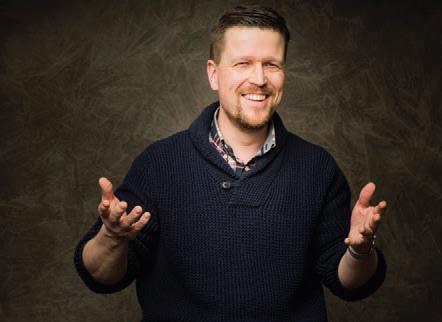
film a single shot. You have to block it very carefully so no one gets hurt. A lot of work!
SC: This is the fourth time one of your movies has been picked to represent Finland as the foreign film at the Oscars. Has this affected your career in any way?
KH: It’s not something you take into account while working on a film. When you choose a project, it’s first and foremost: do I care enough, do I have something to give, do I feel I can go back to the producer and say, honestly, I need to make this film? I resist a story as long as I can, until I cannot, and then I’ll take it on. Being considered for an Oscar, it’s a huge thing. But being selected is not something you get used to. It’s always a gift that makes you very, very humble.
JS: Tell us more about working with actor Märt Avandi. He’s been very successful in comedy before this film, but this is obviously a dramatic role.
KH: When I first saw Märt Avandi, I
thought he would be wonderful as our fencing teacher. He had the look of the old movie actors, [like] Henry Fonda, that kind of beautiful man, with sad eyes…and with a secret. I thought, “Wow, he’s perfect.” In tiny Estonia, he’s a huge star, but I did not know this. I chose him for his acting abilities and his appearance. On YouTube, you’ll see these really silly, absurd sketches he’s done. They’re hilarious in their own way. I’ve worked with comic actors before in dramatic roles. Comedic actors use pain and sadness as inspiration for comedy and are equally able to use those feelings for dramatic roles.
Klaus Härö is one of the most internationallypraised Finnish directors. His films are favorites in both Finland and Sweden. He received the Ingmar Bergman Award at the 2004 Guldbagge Gala, the Swedish equivalent of the Oscars—a first for any non-Swedish director.
SC: American movies are very different from Nordic movies, but it seems that Nordic movies have become increasingly popular here in the US. Why do you think that is?
KH: A good question! Nordic directors are learning from American films. Finnish films have not made that leap into general consciousness the same way Swedish thrillers or Danish dramas have. There’s a reason for that, of course. We just haven’t been at that professional level. I remember growing up watching films by Bille August or Hallstrom, and thinking, they’re so close geographically, but when it comes to quality, they’re light-years away. Today we have a generation of Finnish filmmakers my own age who are very eager to learn and eager to draw on both European and American traditions. There’s a quality, hopefully, that we can give our films that is uniquely Scandinavian—maybe some sort of a fragile feeling, sensitivity, a sort of melancholy.
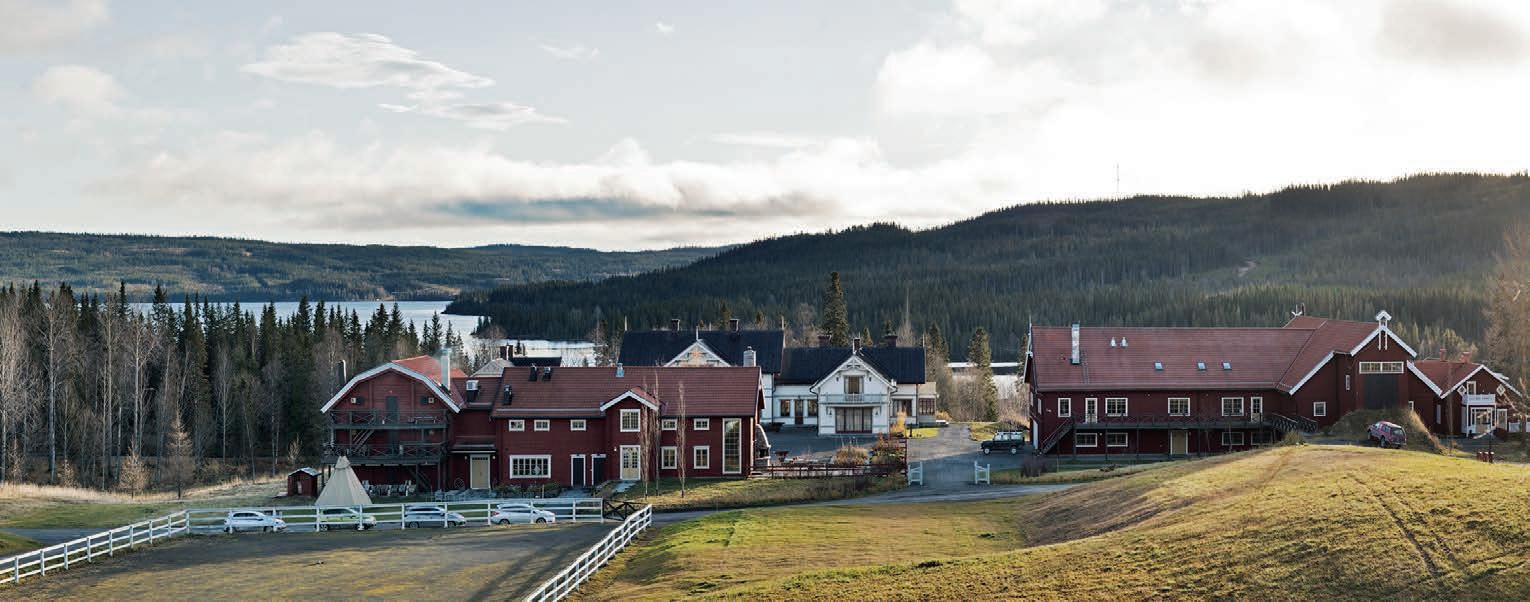
The mysteries surrounding Nordic food and culture continue to be the topic of exhibitions, articles, and passionate debates amongst critics and members of international culinary circles alike. So what would inspire Magnus Nilsson, one of the pan-Nordic arts and culture’s most critically-acclaimed rising culinary stars, to travel for three years throughout the Nordic region collecting recipes, exploring out-of-the-way kitchens, and curating old family recipes, all while shooting several thousands of photos along the way?
Reality. Not the melodramatic stuff of reality television or the folklore traditions of old, but realism rooted in a genuine curiosity to document the diversity and nuanced techniques of modern-day cooking in the Nordic region. “I wanted to record what people are really cooking, not create a fairytale version of Nordic cooking,” says Nilsson. This same outlook also defines Nilsson’s self-described culinary style, rektún mat, which is Jämtlandic for “real food.” “What really makes food authentic is that it is made by
real people who are doing their best with what is available,” Nilsson explains.
For its North American preview, Nordic Heritage Museum was proud to present Magnus Nilsson’s Nordic: A Photographic Essay of Landscapes, Food, and People, a traveling exhibition produced by the American Swedish Institute in Minneapolis, Minnesota. Nordic features photographs by the celebrity Swedish chef in his international debut as a visual artist, anthropologist, and storyteller.
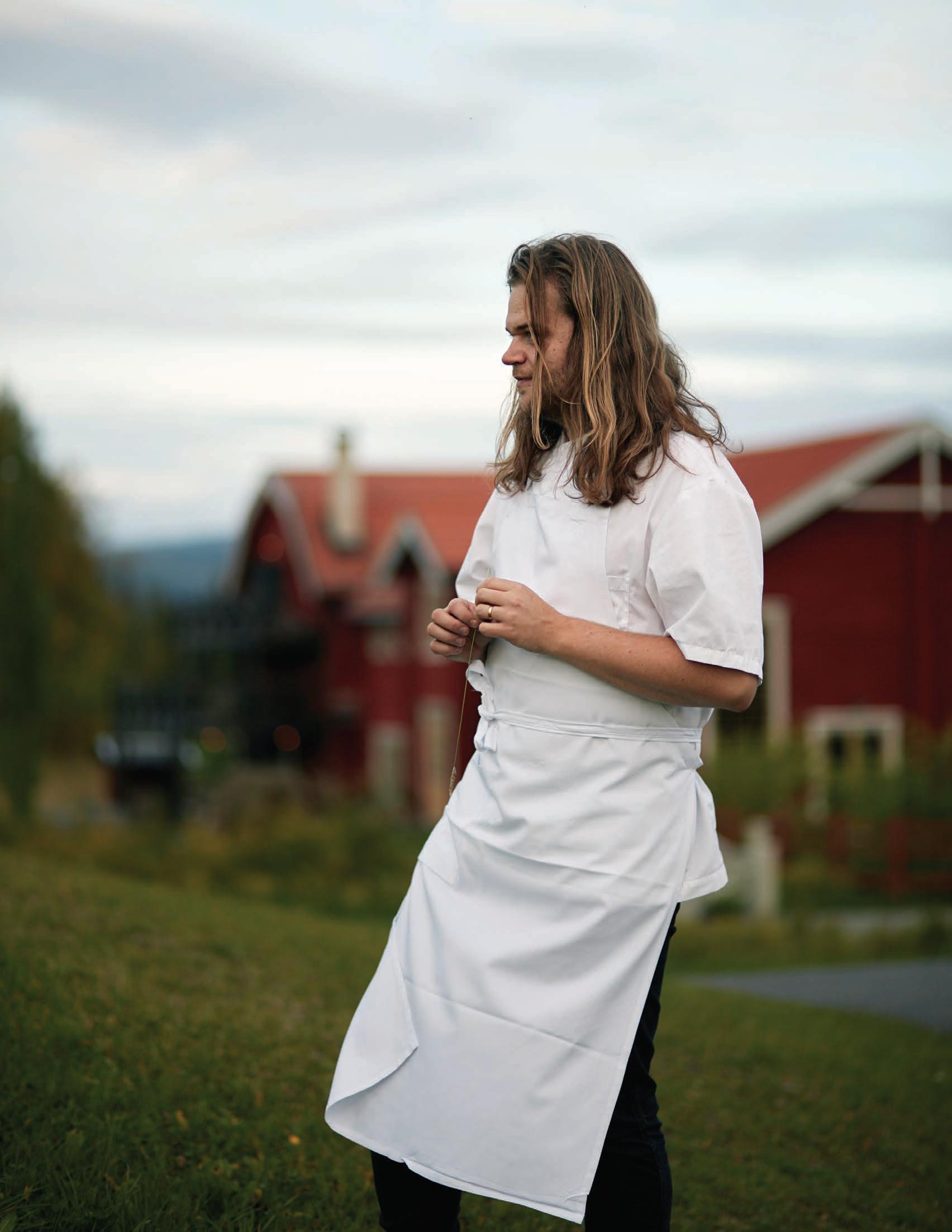
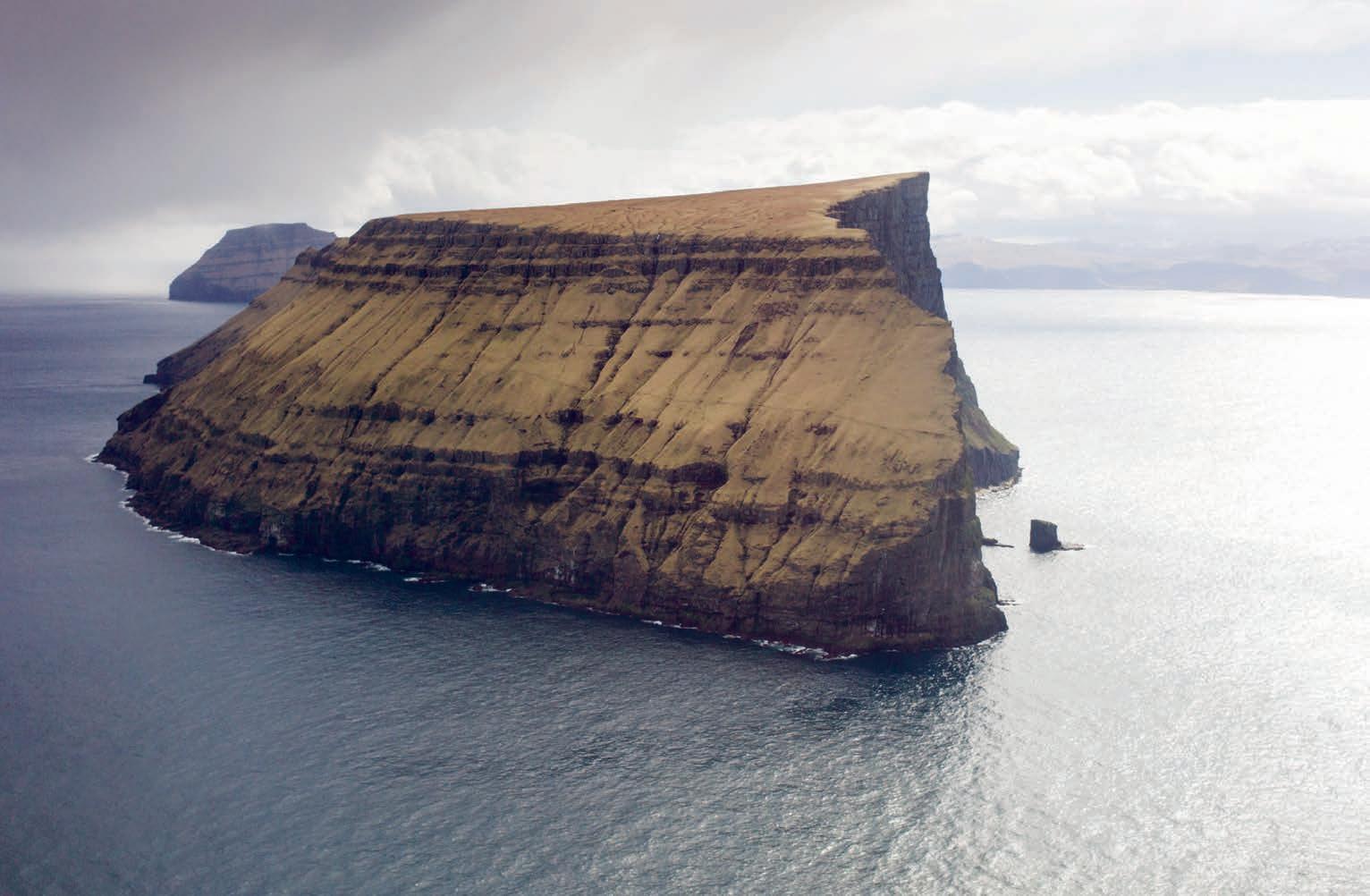
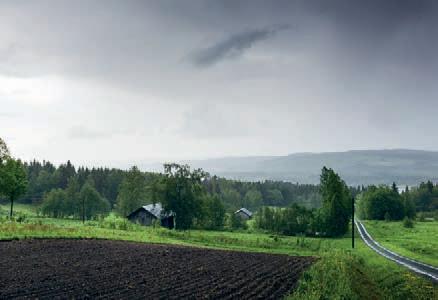
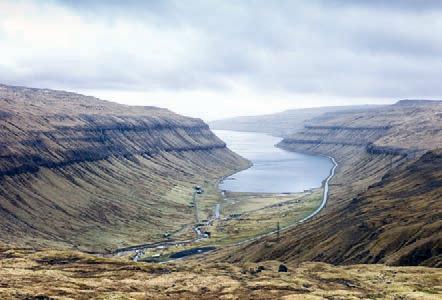
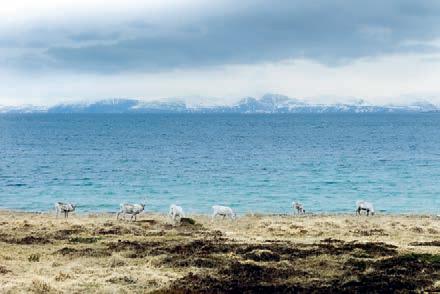
Nilsson infuses his images with the same passion and personality that permeates his cooking. Nordic highlights original, place-based photographs that Nilsson captured of the people he met and the restaurants, private kitchens, and remote locales he explored during three years researching his acclaimed best-seller, The Nordic Cookbook (Phaidon Press, 2015), while seeking an expanded definition of today’s Nordic cuisine.
Nilsson gathered more than 700 indigenous recipes from home cooks, including his grandmother, throughout Sweden, Denmark, the Faroe Islands, Finland, Greenland, Iceland, and Norway, often sleeping on sofas or in tents to get closer to his subject matter, and ultimately shooting some 8,000 photographs. The exhibition and accompanying catalog showcase selected images and invite viewers to discover
food as a universal touch point sharing heritage across boundaries and time.
Nordic also features images of Nilsson’s restaurant, kitchen, and the workings of a chef as described in essays by Swedish journalist Po Tidhom and documented by Minnesota-based photographer Cameron Wittig.
Nilsson’s growing list of accolades include a 2016 award of two Michelin stars for
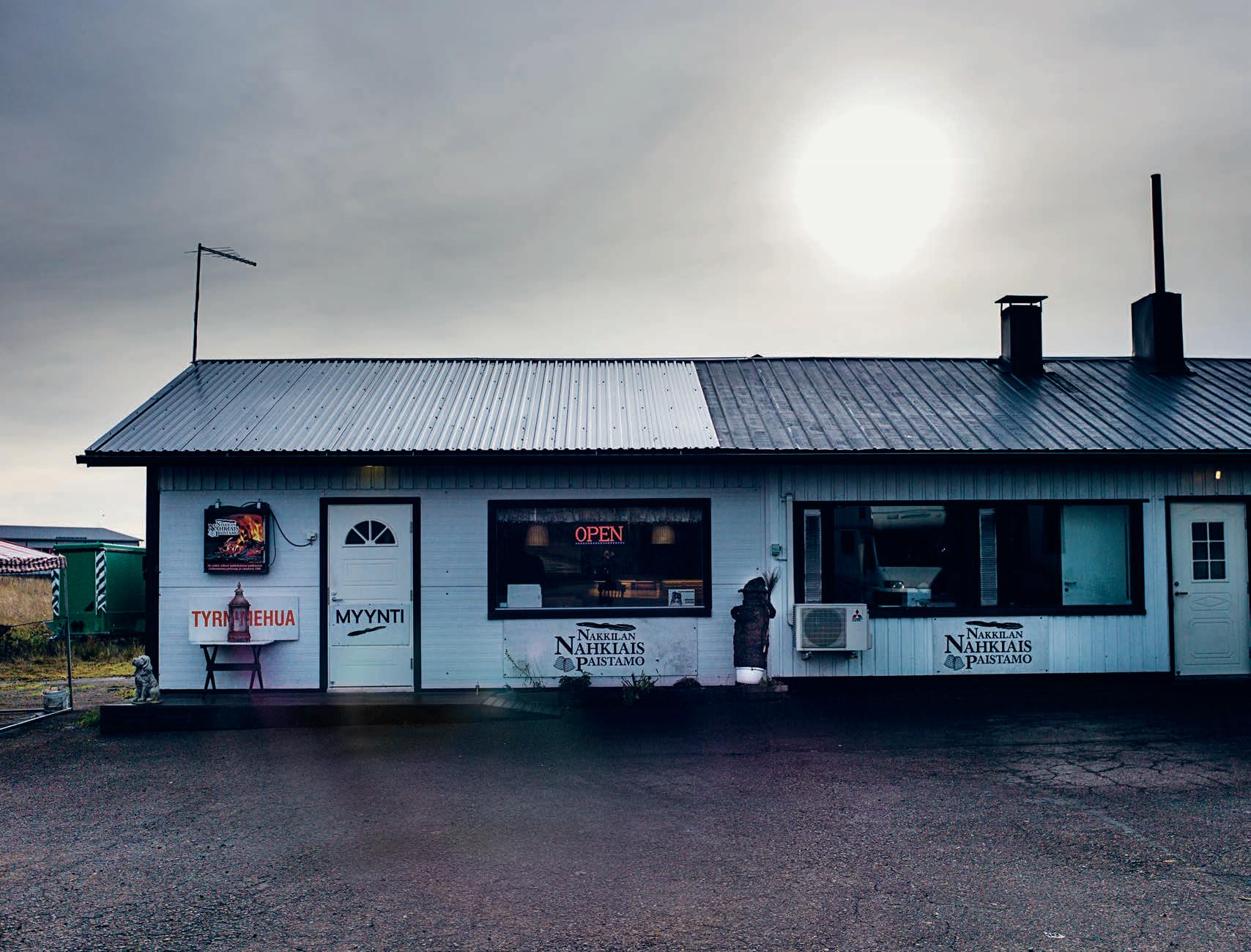
his restaurant Faviken, regularly listed among the world’s best restaurants. He was featured in the February 2016 issue of Food and Wine Magazine, and in 2015 he earned the White Guide Global Gastronomy Award. A popular television personality, he is also renowned through appearances in the Emmy Award–winning PBS series The Mind of a Chef and the Netflix docu-series Chef’s Table.
Magnus Nilsson is the head chef of Fäviken Magasinet restaurant in Sweden. After training as a chef and sommelier in Sweden, he worked with Pascal Barbot of L’Astrance in Paris before joining Fäviken as a sommelier. Within a year, he had taken over running of the restaurant. Fäviken recently earned two 2016 Nordic Michelin stars and is ranked in the San Pellegrino World’s 50 Best Restaurants list.
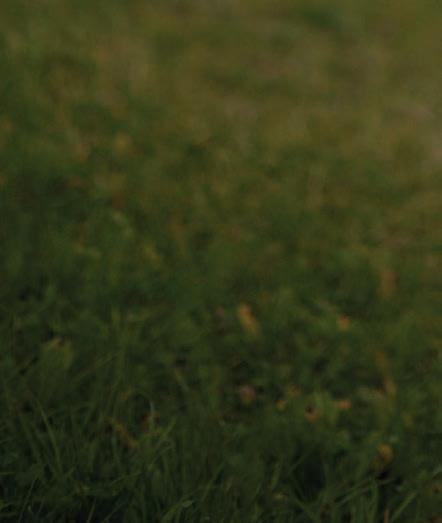
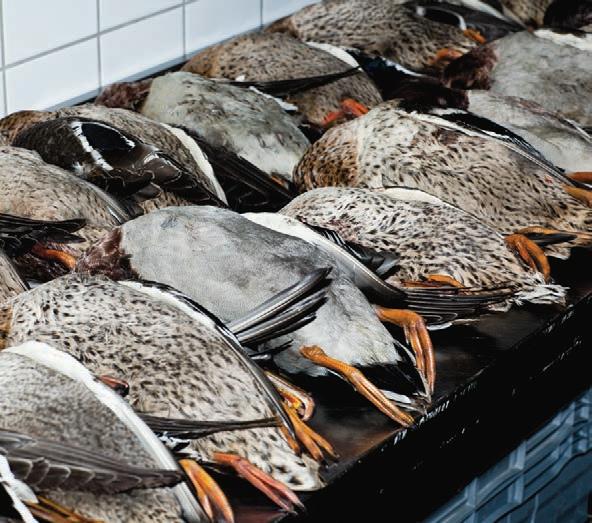
Look for details on our next culinary extravaganza.
Immerse your senses in a series of unique experiences with visionary chefs.
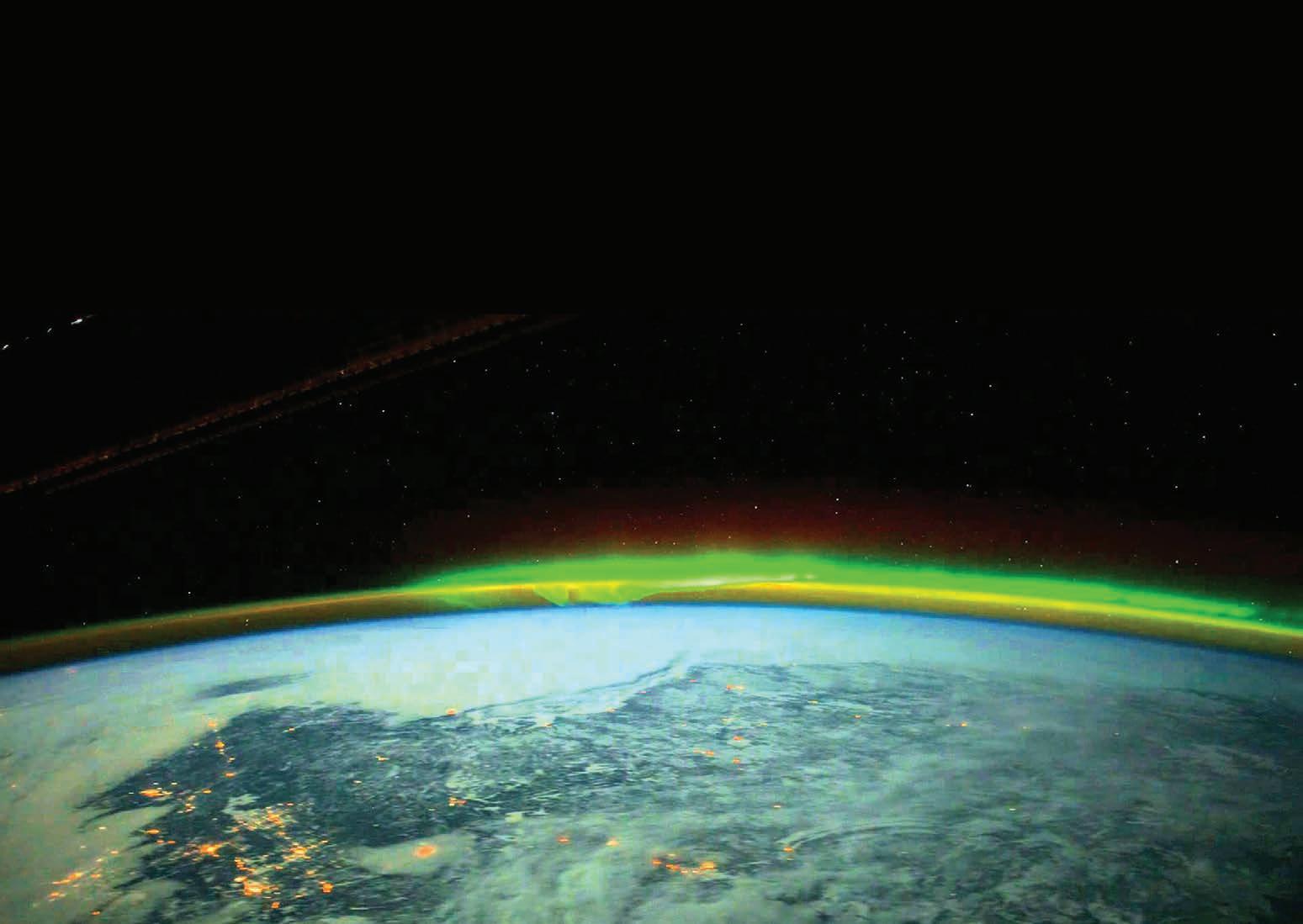
THIRTY-SECOND ANNUAL
BENEFITING NORDIC HERITAGE MUSEUM
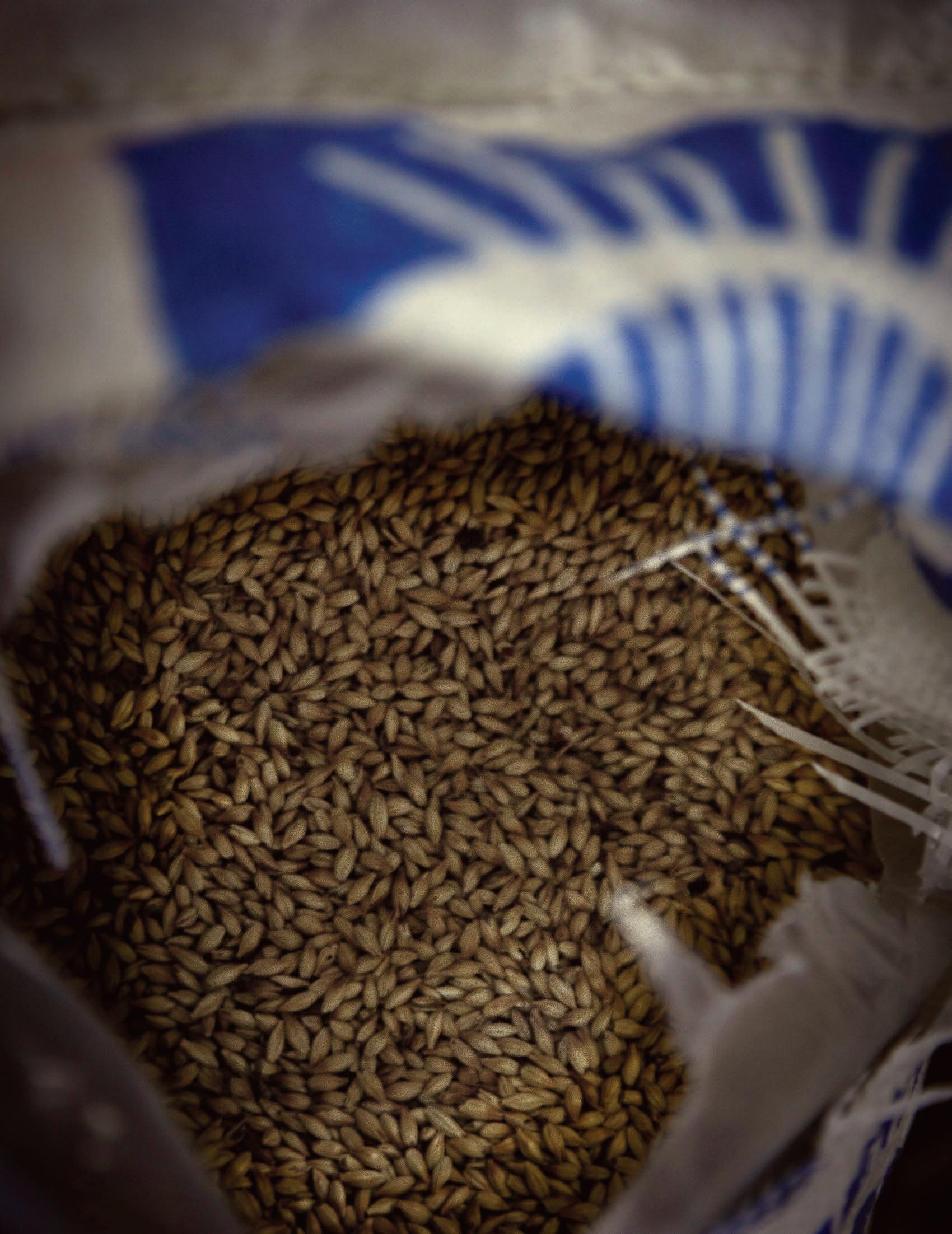
Brothers Daniel Lee and Wes Peterson are adding the Nordic touch to some of the finest craft beers available in the Pacific Northwest
Nestled in the abundance of craft- and microbreweries that have peppered the Pacific Northwest landscape over the past few decades, Odin Brewery stands out as one of Washington State’s finest. Odin’s special brands of beers, created by hand with a food pairing orientation, pour through hundreds of taps throughout the Puget Sound region and are carried in most major grocery store chains.
At the heart of the brewery are brothers Daniel Lee and Wes Peterson, Pacific Northwest natives who decided to make brewing a family business back in 2008, when the recession was hitting hard, motivating each of them to consider a career change. Dan, with a background in marketing that included a prior stint at Miller Brewing Company in Milwaukee, contacted Wes, who was then working in the travel industry, to begin the venture in earnest. The origins of the trade for them were standard: you find a
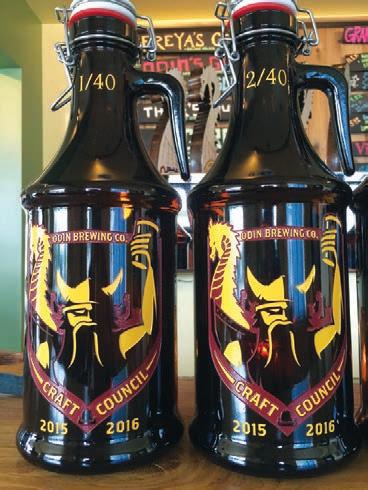
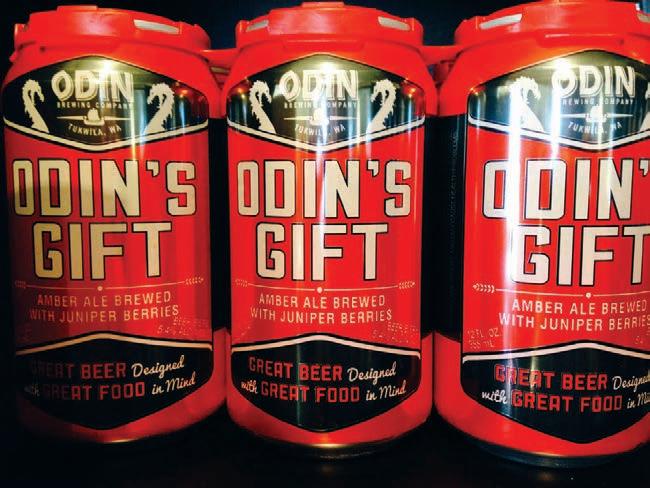
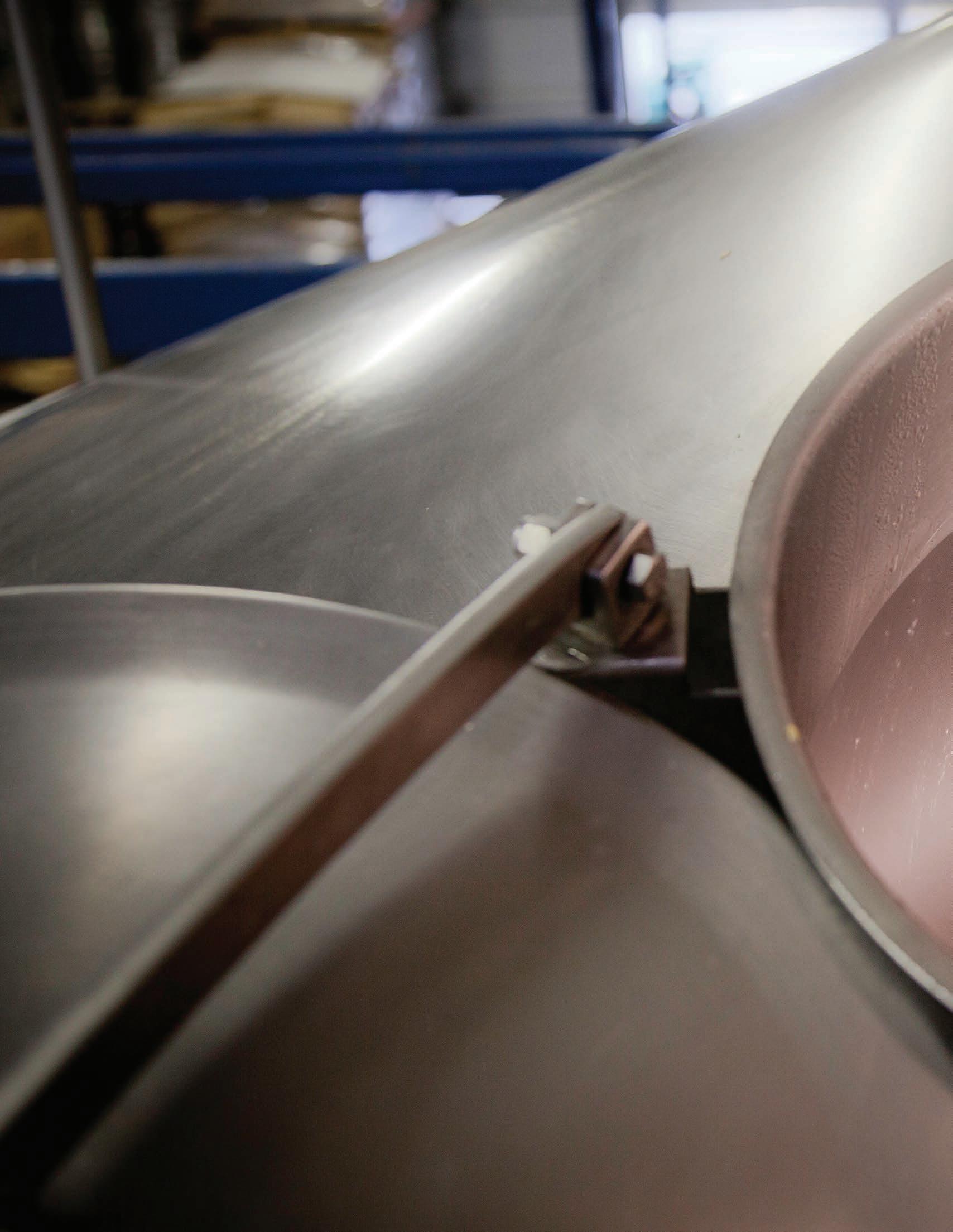
warehouse, the necessary equipment, an experienced brewer, and get to work on some recipes.
“There were already a lot of good microbreweries in Seattle—not just Washington or the larger Pacific Northwest—but specifically in Seattle, so we started doing research into what would differentiate our brand from the other breweries’ productions,” Dan explains.
Indeed, the craft brewery trend was growing in the 2000s, both regionally and nationally. In 2008, Odin was the 118th licensed brewery in the state of Washington alone, a number that by 2015 had grown to over 300.
“Nationally there were 2,000 when we started,” reflects Dan. “Today it’s over 4,000, and expectations are that that number will hit 5,000 within the year.”
The brothers then set out to discover those details that separated them from the larger milieu. First came the brand. “I started thinking about Wes and my interests growing up,” says Dan. “We always had an affinity more for the Norse gods than those that were Greek or Roman. The Norse gods were more practical, more down to earth; you could relate to them because they had flaws.”
And then there was the family connection itself, bearing Icelandic origins. “I wanted to name the brewery in honor of that side of my family,” Dan explains. “I did some research into Norse mythology and came across the story of Odin bringing the gift of fermentation to mankind, so that was the kernel we started with....”
With a brand theme in place, Dan and Wes looked at the larger craft brewing landscape in search of something more
than a trend. “In 2009 you saw the emergence of extreme beers, IPA s with 100 IBUs, or sour beers; beers that were essentially novelties.” But, Odin was destined for something much more substantive.
“We were looking for new lands and territories to take craft beer. I visualized this land where beer and food lived together in perfect harmony…a wonderful land…a paradise, but the gatekeepers of the alcohol side of things had always been wine. So, we used that Viking spirit of conquest and adventure along with a friendly way to invade this land with beers that are relevant to that food context.”
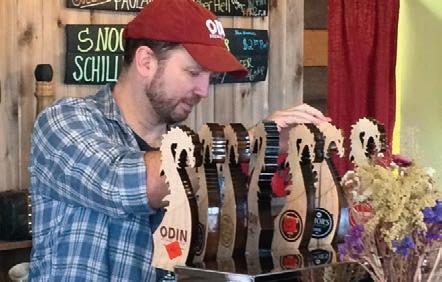
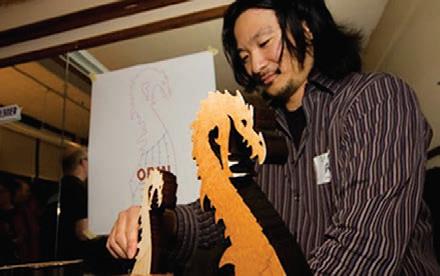
“To us it was an interesting notion, because while there were beers out there that talked about food pairings, they were mostly a secondary or tertiary message, buried under the headline…but we wanted to make food pairing the headline, to make the infrastructure of the company a message of building toward exploring this food land where wine was dominant to beer. We wanted beers that were full-flavored themselves, but also complemented food, as opposed to fighting or coming into a contrast with the food,” recalls Dan.
As they began to research finding a beer that both complemented food and stood
out in its character alone, Dan and Wes again looked to the Nordic countries and pulled from their ancient brewing traditions.
“In looking at the Nordic countries, hops don’t grow particularly well at those latitudes, but what do grow well are juniper bushes. They grow naturally in Scandinavia, and in our research we discovered that in the old days brewers in those regions would take juniper bushes and lay them out as a lattice for filtration, and of course in this process some of that juniper flavor would end up in the beer. So, we thought about how we could incorporate some of that history into our product. Obviously it was not practical for us to chop and lay juniper bushes, but we experimented with dried juniper berries; put them in what’s essentially a giant teabag, threw it in the kettle, and thus found a way to include this material ingredient that has a historical relevance.”
Those experiments led Odin to what is still today their signature brew: Odin’s Gift. “To me it’s kind of the perfect coalescence,” Wes explains. “It’s the concept, the history, the versatility of what we’re trying to achieve.”
Odin’s Gift is a difficult beer to categorize, but one of exceptional taste, craftsmanship, and true versatility. Dark in color, medium-bodied, and equally balanced between malt and hop, the beer has a hop bite, but a very clean finish for a darker beer. “We tend to pair it with main courses. It has enough body and flavor up front, but with that clean finish. One of my favorite pairings is a rabbit stew, but there’s also a variety of salmon preparations and red meat pairings. One of the local restaurateurs did it with lamb and a juniper sauce that was great!”
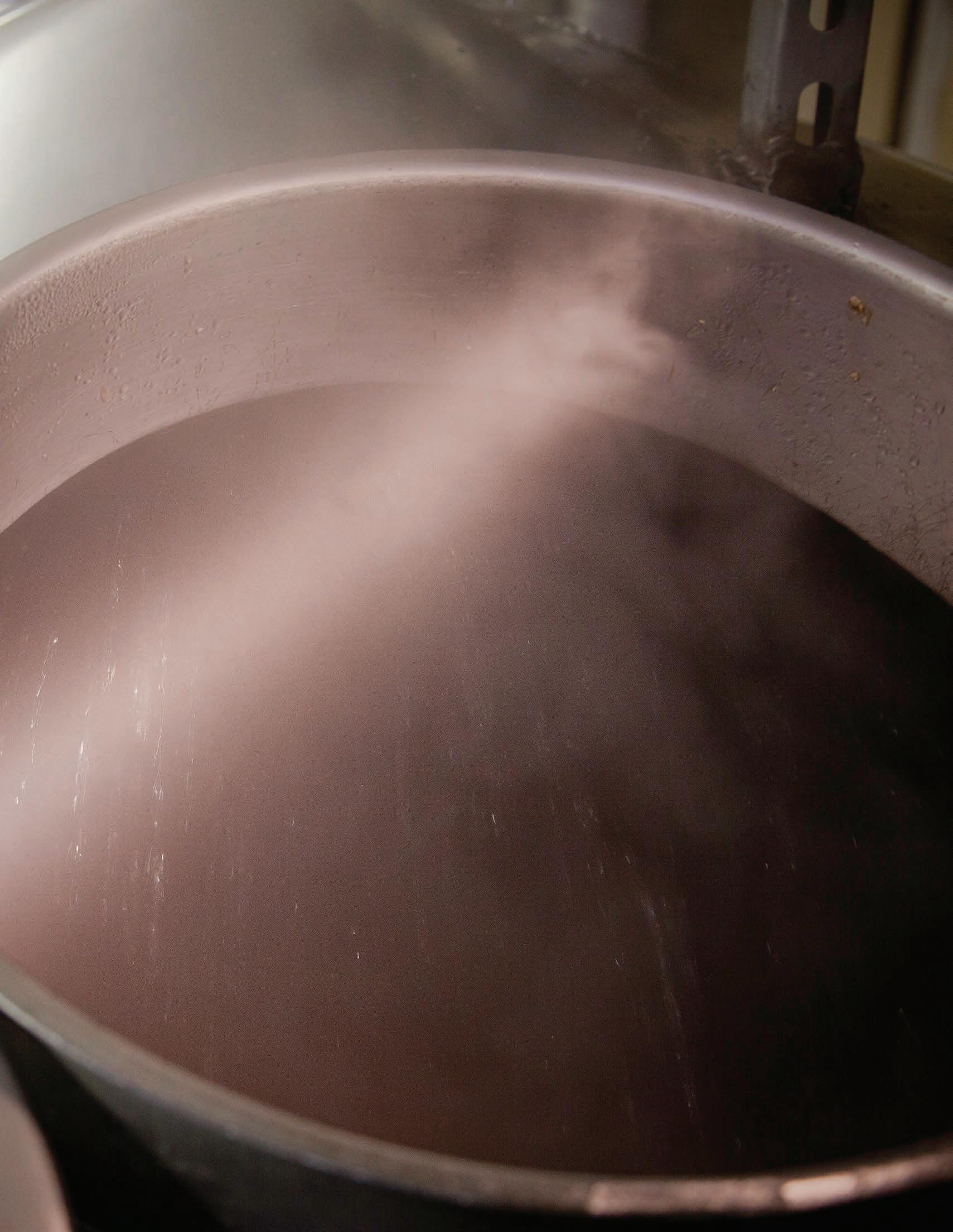
Odin’s Gift made its public debut in 2009, fittingly enough at Nordic Heritage Museum. “The very first keg that we poured in was at the Nordic. It’s just appropriate that our debut take place at the Museum. It was our very first public showing and the timing was right for us,” said Dan. Following their debut, the brewery expanded its offerings in 2010 with the Kolsch-style Freya’s Gold, testing seasonal and one-off batches in the process.
A visit to the newly minted Odin Brewery headquarters in Tukwila today showcases a much wider variety of beers that stand as a testament to Odin’s growth in both popularity and as a business. The original 5,000-sq. ft. distillery, located in the South Park district of Seattle, has recently closed in favor of a more expansive 13,000-sq. ft. distillery and taproom facility. Nordicthemed artworks are scattered throughout the retail space, with construction underway to expand the tasting room into the brewery itself, giving consumers an opportunity to watch the brewing-process results which fill their glasses. “We’re applying modern Nordic design concepts to our interior look,” offers Wes. “All of these furnishings are hand-cut natural woods, produced by local artisans.” He’s referring to the bar, chairs, and benches that align the taproom; thick slabs of wood that transform the retail space into one that’s both rustic and elegant in its simplicity.
So what’s the long range plan for Odin?
“I’ll let you know when we get there!” Dan offers with a laugh. “To me, there’s always going to be a certain level of direct appeal in the local market. It’s hand-tohand combat. You go bar to bar with samples, growlers, tell them who you are and what you have to offer…dealing with restaurateurs and bar owners at a face-to-
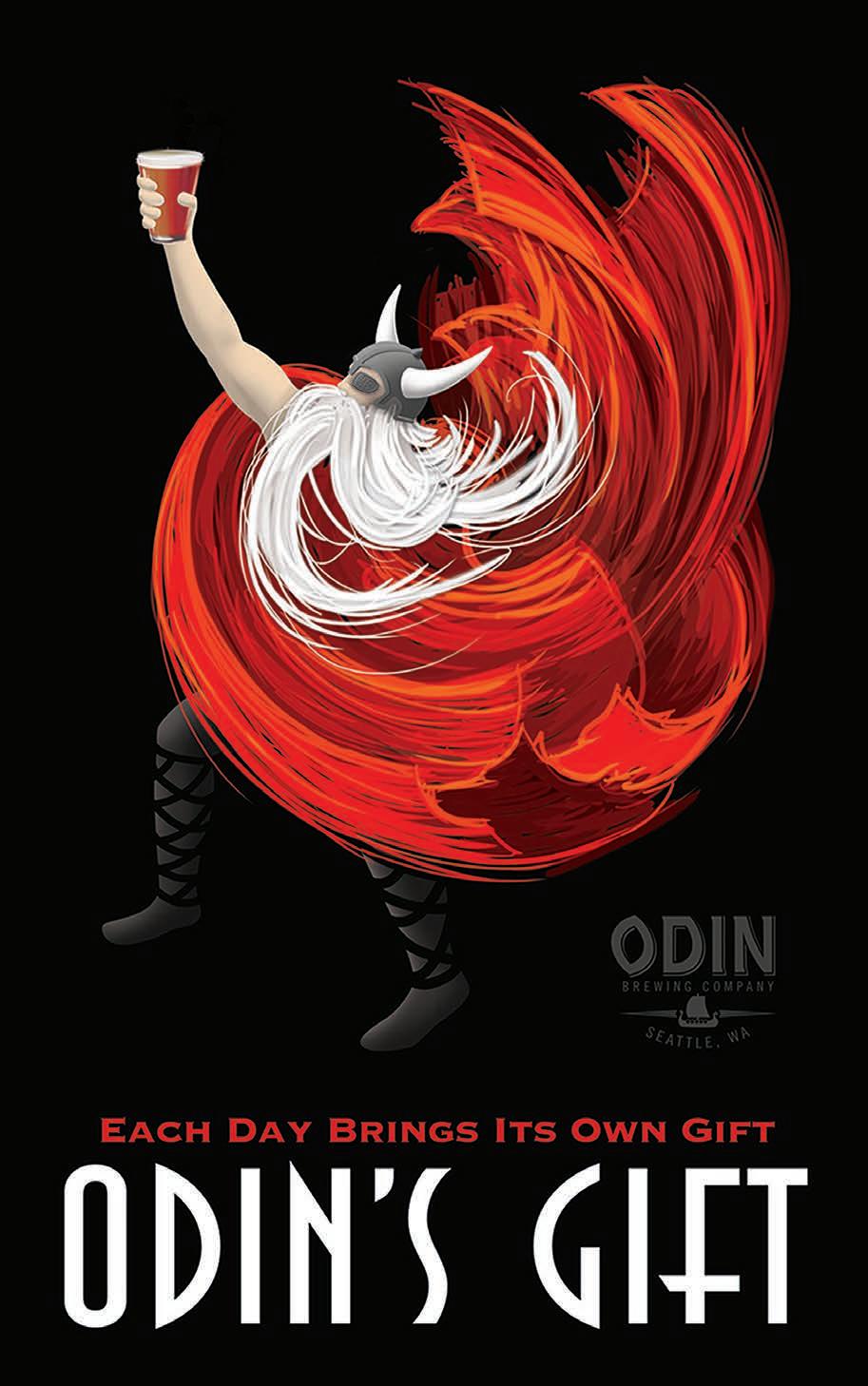
face level, to me that’s the cornerstone to marketing in this business—to take it to that personal level. We want Odin to be recognized as one of the innovative leaders in Washington State craft brewing, and you have to remember that the beer business is a lifestyle choice, and there’s a lot of romance associated with brewing. You’re like that monk in the abbey.”
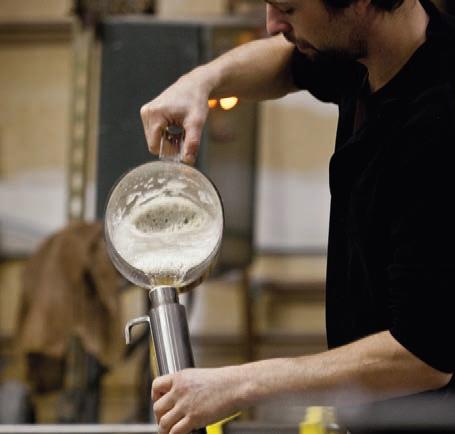
Contributed
by Alison Church, Children’s Education Coordinator
Historically, the Nordic countries have maintained a rich tradition of producing children’s literature that stands the test of time, while culturally placing a high value on literacy and the importance of youth education through reading. According to new research, Finland is the world’s most literate nation followed by Norway, Iceland, and Denmark, with Sweden rounding out the top eight behind the US, Canada, and Australia. This new study conducted by John Miller, president of Central Connecticut State University in New Britain, UK, looked at literacy achievement tests and also at what it called “literate behavior characteristics”—everything from numbers of libraries and newspapers to years of schooling and computer availability in the countries. In continuing to reflect these values, Nordic Heritage Museum’s permanent collection highlights the Museum’s dedication to collecting new reading materials for visitors of all ages to see and enjoy.
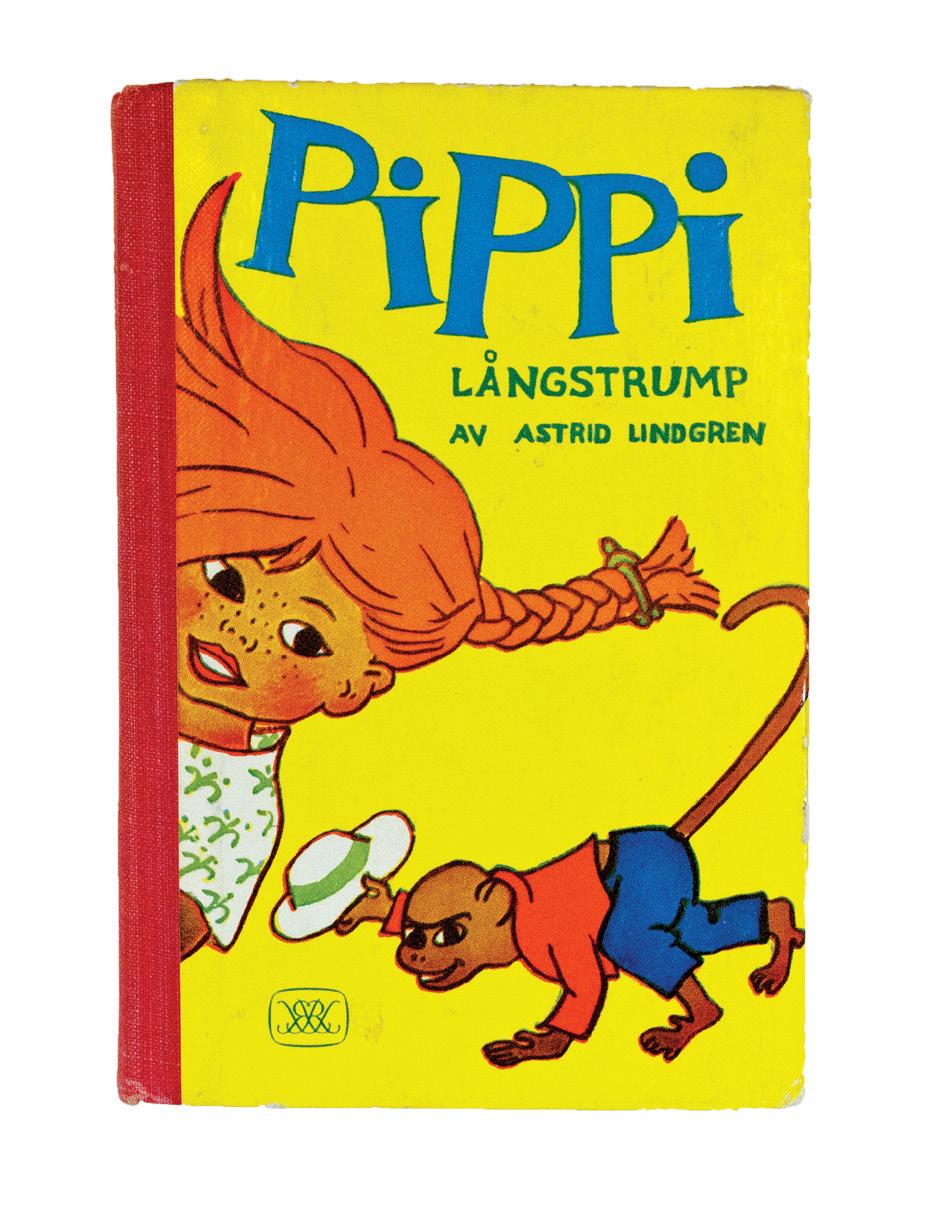
In 2015, a local Seattle donor offered a 1945 edition of the children’s book, Pippi Långstrump (Pippi Longstocking) by Swedish author Astrid Lindgren (1907–2002), the world’s third-most translated author of children’s books after H.C. Anderson and the Brothers Grimm. In addition to adding to the Museum’s archive of children’s books, the new acquisition will be featured as a part of the new displays for the Nordic Identities Gallery inside the new museum. I Skoven Skulde Være Gilde (There Will Be A Party in The Forest) is another book originally intended for younger audiences that will be on view in the new Nordic Identities Gallery. First published in 1935 by Richard Edelmanna Kunstforlag of Copenhagen, the songbook includes lyrics in Danish and eight colorful illustrations by the artist Neils Wivel (1855–1914). The accordion-style book opens up to reveal a beloved poem (that is also set to music) of forest animals at a party. The Museum acquired the book in 1995 as a gift from Ove and Edith Kilgren.
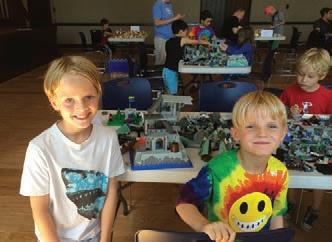
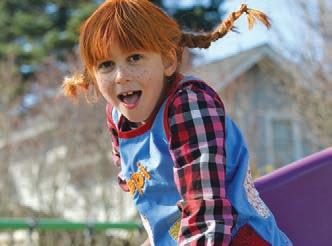
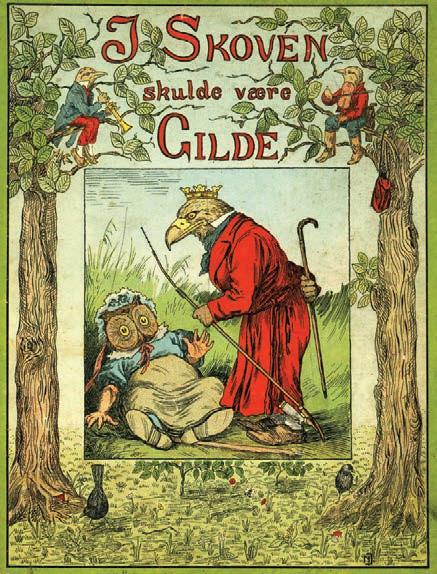
Nordic Stories
Monthly gathering for preschool-aged children and their grown-ups. Featuring stories from the Nordic countries paired with a craft project.
Children’s Christmas in Scandinavia
Nordic fun for the entire family including: Santa Lucia Pageant, Christmas crafts, music, and dancing.
Breakfast at Pippi’s
Dress up as your favorite character from the Pippi stories and join us for a delicious Swedish pancake breakfast, movie, crafts, live music, and dancing.
LEGO Workshop
Annual LEGO-building extravaganza!
Summer Heritage Camp
Themed, weeklong camp filled with crafts and activities.
The Nordic countries have a rich tradition in children’s literature. From folktales to mysteries here are some titles that you may enjoy.
Contributed by Marie Nordquist, The Secret Garden Bookstore in Ballard
The Princess and the Pea | by Hans Christian Andersen | LITTLE GOLDEN BOOK
Only a real princess can detect the pea hidden under a mountain of mattresses.
Comet in Moominland | by Tove Jansson | AGES 8 AND UP
The merry adventures of the Moomintrolls in the Finnish forest. Good family read-along.
The Summer Book | by Tove Jansson | AGES 14 AND UP
The lovely story of a small girl and her grandmother during their summer stay on an island. Family relationship, aging.
The Story of the Blue Planet | by Andri Snaer Magnason | AGES 10 AND UP
Gleesome Goodday lands on an island on a planet with no adults; will Brimir and Hulda see through his deceptive promises? Adventure, social themes.
The Problem with Chickens | by Bruce McMillan | PICTURE BOOK
Puffins lay their eggs in very difficult places so the ladies of Iceland decide to try chickens instead. Delightful illustrations.
Race of the Birkebeiners | by Lise Lunge-Larsen | PICTURE BOOK
The “Birchleggers” race to save a prince in 1206. Beautiful woodcuts illustrate this true story.
The Twistrose Key | by Tone Almhjell | AGES 8–10
This debut novel combines elements of fantasy and magic with action and adventure.
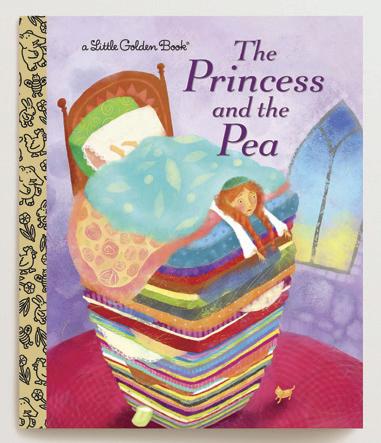
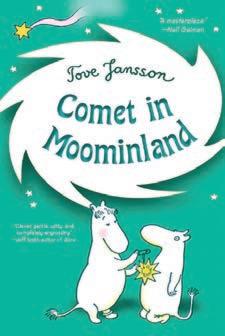
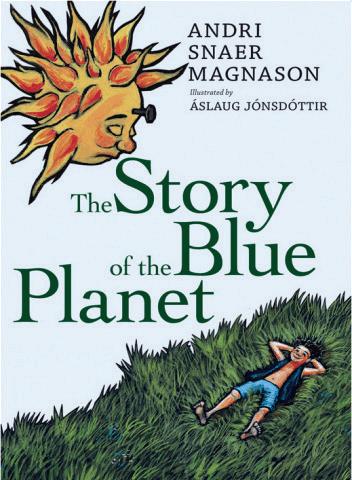
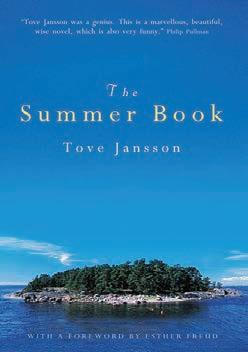
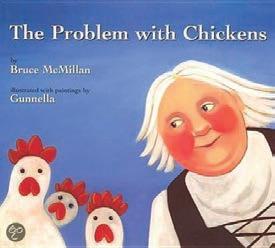
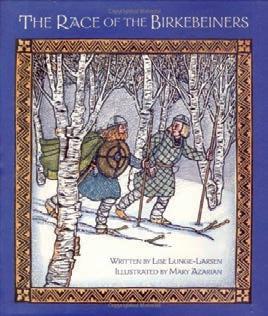
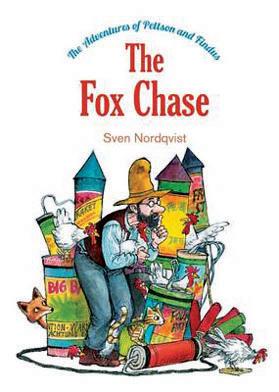
The Fox Chase: The Adventures of Pettson and Findus | by Sven Nordqvist | PICTURE BOOK
Clever cat Findus, and Pettson the farmer, plan to save the fox from hunters.
The Glassblower’s Children | by Marie Gripe | AGES 10 AND UP
Classic folktale genre of children enchanted in a lonely castle who must find their way back home. Action and adventure, family relationships.
A Bridge to the Stars | by Henning Mankell | AGES 12 AND UP
The poignant story of a boy trying to find the truth behind his father’s mysterious disappearances. Fathers and sons, coming of age.
Look for these titles and more at the Museum Store!
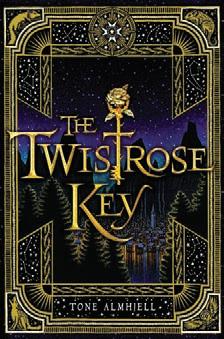
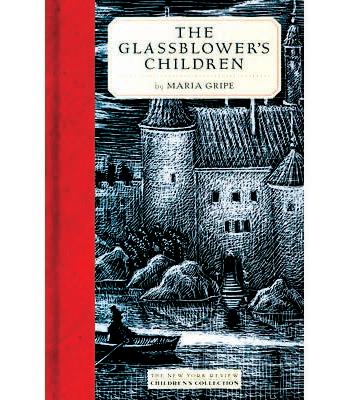
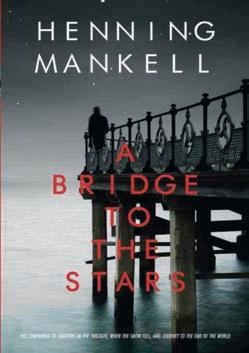
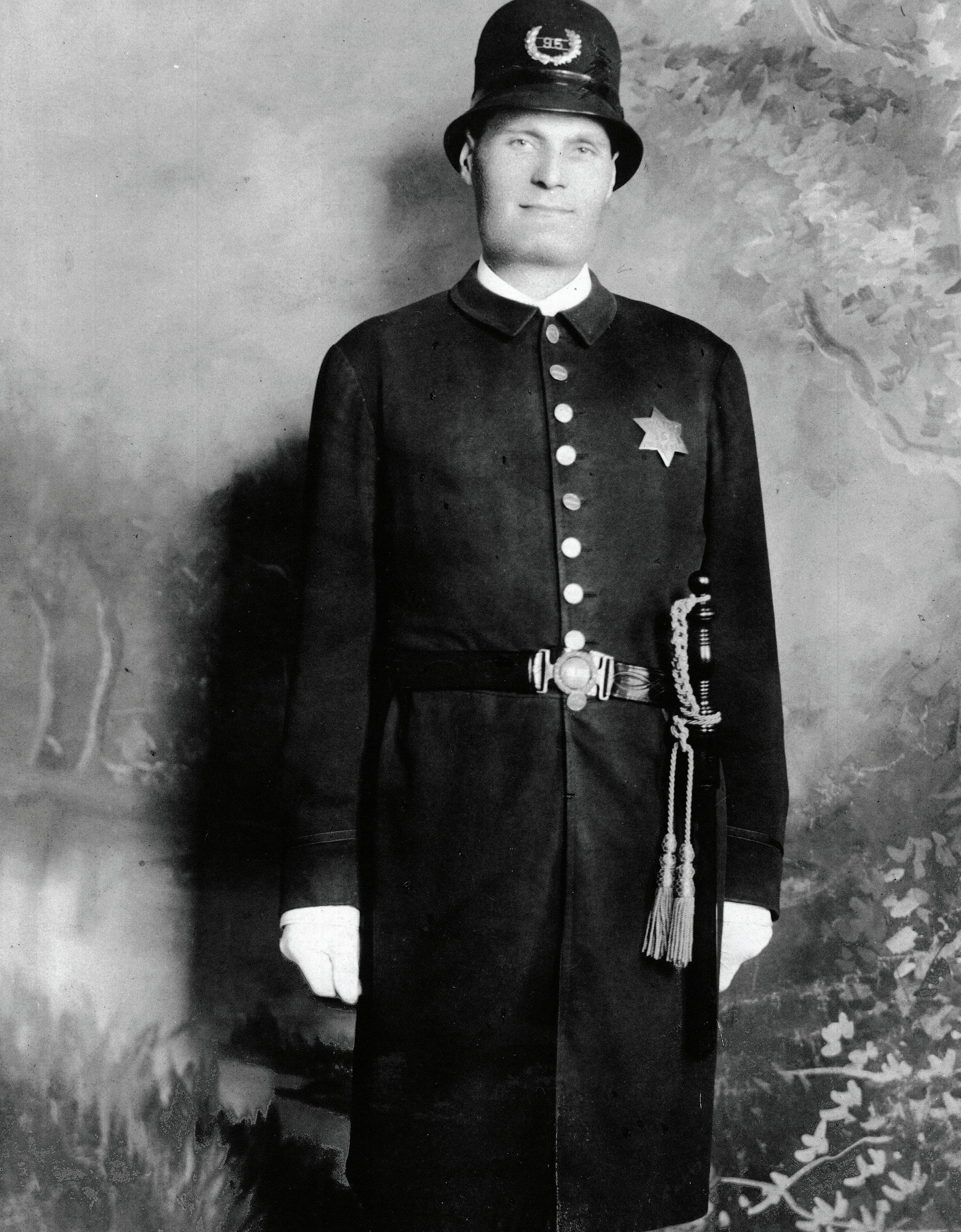
from an article by
Friðrik Þór Guðmundsson
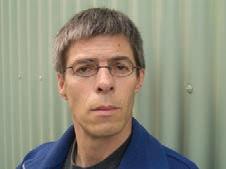
Friðrik Þór Guðmundsson is the great nephew of Jakob “Jake” Bjarnason. He recently spent a year in Seattle and was able to learn more about his colorful relative.
Guðmundsson teaches journalism at the University of Iceland, Reykjavik, and is an elected member of the Iceland Journalists’ Union Ethics committee. He is interested in genealogy and has written two books in Icelandic about the history of his family.
Icelander Jakob “Jake” Bjarnason was a sergeant in the Seattle Police Force from 1903 to 1927. A renowned keeper of the peace, he was an intelligent, gentle man, with a great sense of humor. His enormous seven-foot, five-inch stature and booming voice were known to be effective substitutes for brute force or a weapon.
After leaving Iceland, and arriving in Seattle in 1901, Jake settled in Ballard in 1904, aged 30, because of the large Scandinavian-American community.
Born in Iceland in 1874, he had grown up in a family that included several priests and sheriffs. After school, he left
home to study in Hólaskóla, and taught there before emigrating to the United States. Once in the US, he decided to try his luck and “go west.”
In 1904 he was joined by his youngest sister Guðríður (“Grace”). After she was widowed in 1913, she kept house for her bachelor brother and he, in turn, fostered her daughter, Sigrún Eleanor Ryan.
Someone once asked Jake if everyone in Iceland was as big as he. He answered, “I was so little there, that I was ashamed and had to leave the country!”
At seven-foot and five-inches, Jake was as strong as an elephant, with a broad jawline and a big face. With characteristic good humor, he joked that his barber charged double to shave him. No readymade clothes would fit him, so clothing had to be made specially, even his shoes. At 264 pounds, he would joke that he was getting too thin.
Ballard’s pub-lined streets and residents’ high alcohol consumption meant that drunken behavior and dangerous crowds were commonplace. As a police officer, Jakob was known to be an effective peace keeper because of his good nature and ability to reason with people like a father or brother. Of course, his intimidating stature was a powerful deterrent, too.
Author Magnús Á Árnason tells a story about Jakob wrestling with four men disturbing the peace in a Ballard pub. One of them hit Jakob on the head with a whiskey bottle: “but then Jakob took to his bat and hit two of them in the head so they were out, and took the other two under each arm and walked them to the nearest police station, with his head split open so the blood was leaking down to his toes.” According to the story, Shea Baden was the man who hit Jake with the bottle. He was fined $200, a huge amount in those days… which only added to Jakob’s reputation.
Magnús tells another story about Jakob, who was a witness in a court case that involved a thief. Jakob was accused of lying about the thief. But the judge said “I have known Jakob for twenty years and I have never heard him tell a lie, so I’m afraid I have to take his word over yours!”
Being a policeman was not always so serious. During a convention of car salesmen, one of the speakers and Jakob hatched a plan. Jakob, in police uniform, would rush onto the stage and forcibly arrest his collaborator in mid-speech, dragging him off to justice. The horrified audience only realized it was a prank when the two conspirators returned to the stage, laughing.
Jakob never forgot his Icelandic roots. He took an active part in the social life of the Icelandic-American community, especially in the literary social club “Vestri,” whose board he served on in several capacities. He was also an editor for Geysir, a newsletter written in the Icelandic tongue, where he could help maintain the language and culture of his
homeland. He sung in a choir, joking that his voice might be more useful as a foghorn. He joined speech competitions, discussing topics such as prohibition and his experiences as a police officer.
On October 6, 1927 at the age of 53, Jakob Bjarnason died of heart failure. He had been ailing for a couple of years, perhaps due to the effects of Marfan syndrome, a genetic disorder affecting the body’s connective tissue.
His funeral was one of the largest to be held in the city of Seattle. Two thousand people were in attendance, including over one hundred policemen and the Police Commander, all in dress uniform. Jakob was buried in the Evergreen Washelli Memorial Park in Seattle. Sadly, today, his small headstone is overgrown with grass.
His police colleagues still remember him, however. A bust of Big Jake, sculpted by Inga Thorkelson, figures prominently at the Seattle Metropolitan Police Museum, in Seattle’s historic Pioneer Square.
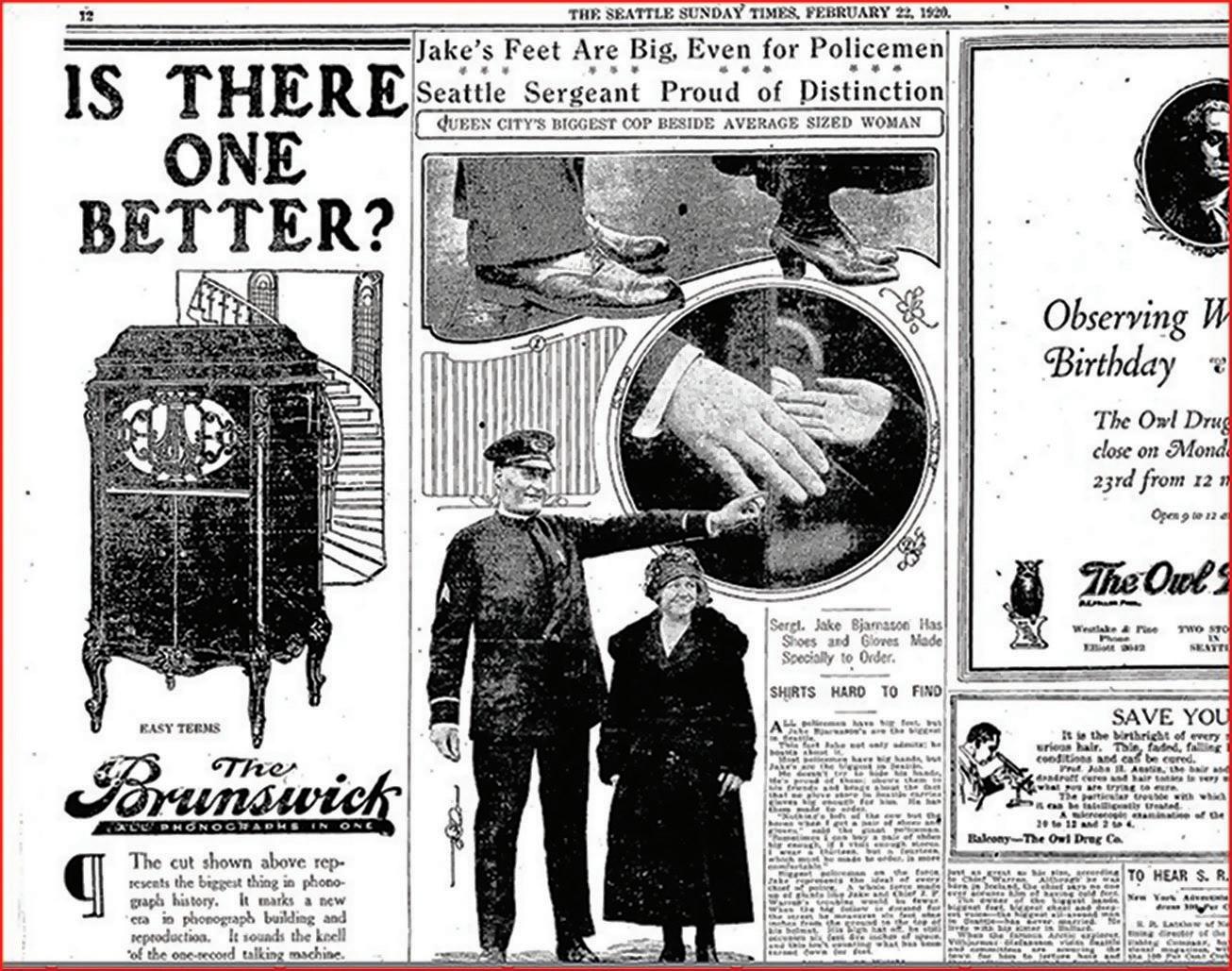
BY SARA LA FOUNTAIN
11⁄4 cups over-night soaked almonds
4 cups fresh water
4 dates
1⁄2 cup blueberries
2 tbs honey
pinch of seasalt pinch of cinnamon pinch of cardamom
Put all the ingredients in a blender and mix well.
Pour the purple milk through a fine sieve so the texture becomes more velvety.
Enjoy in good company!

Award-winning Finnish-American chef Sara La Fountain is a TV personality, designer, and food writer with a focus on Kitchen Couture and New Nordic Fusion.
Her latest cookbook, Healthy Kitchen, features a collection of organic healthy meals that promote a balanced body and mind. For Nordic Kultur, Sara shares a scrumptious twist on a healthy seasonal smoothie!
Sara was a celebrity chef at the Museum’s inaugural Nordic Culinary Conference.
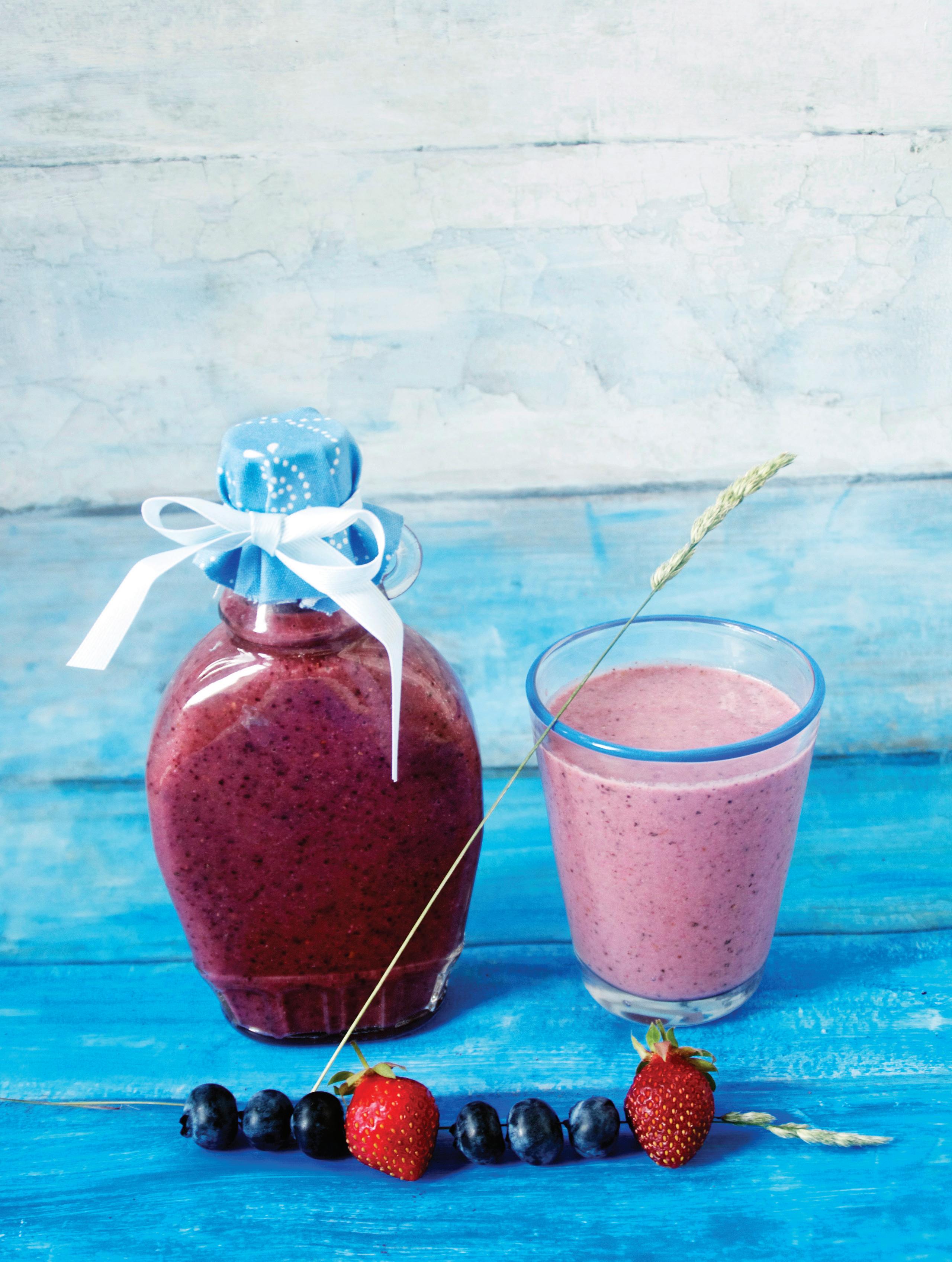
THE NORDIC HERITAGE MUSEUM RECEIVES IMPORTANT FUNDING FROM


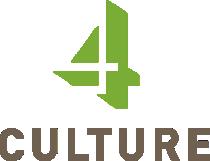
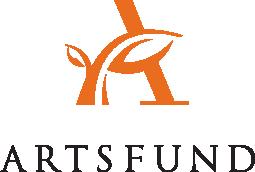
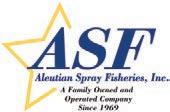
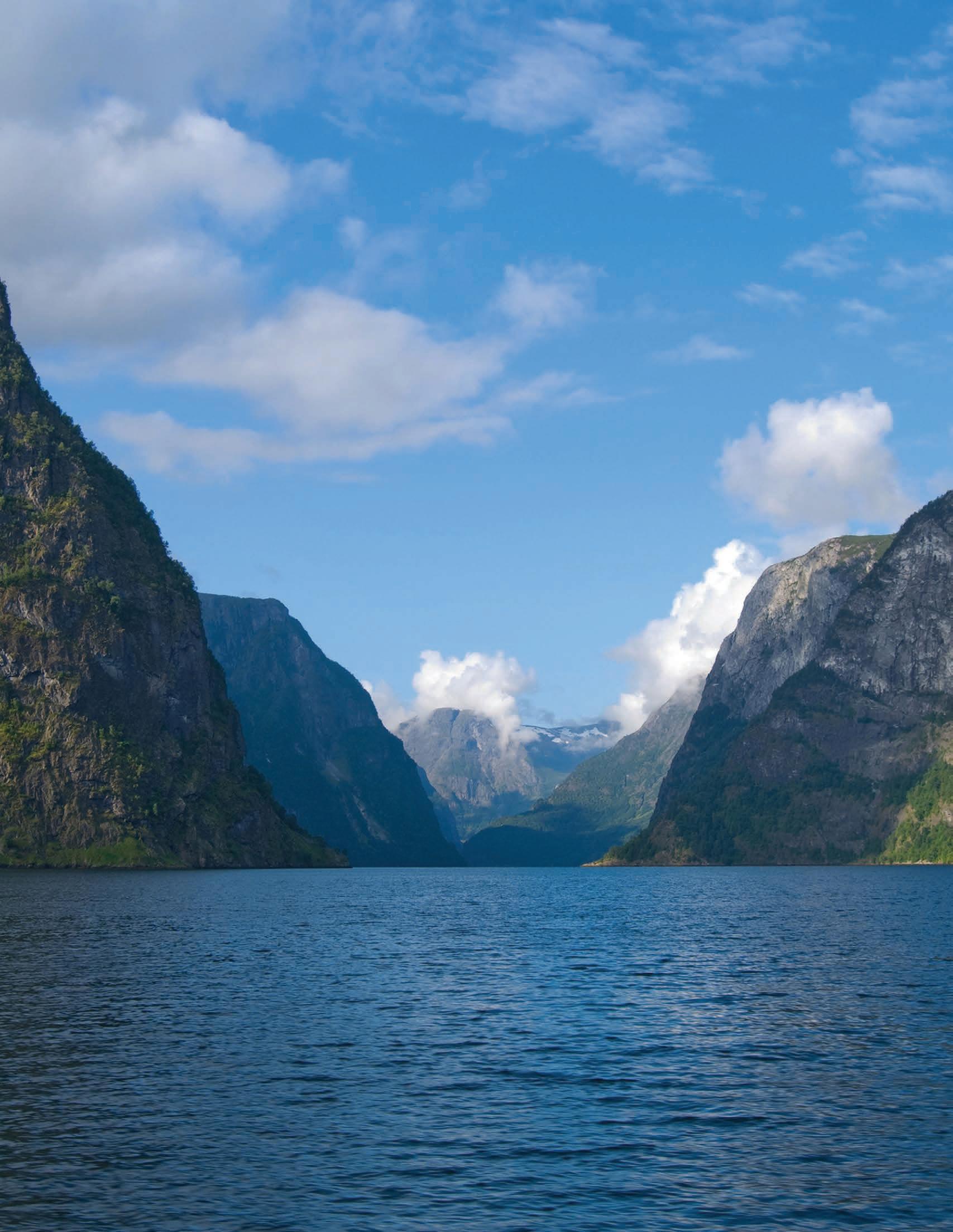
AND ADDITIONAL SUPPORT FROM


